Biographies of the ADR founders
Mahammad Amin Rasulzade
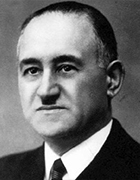 Rasulzade Mahammad Amin Alekbar oglu was born on January 31, 1884 in a township Novkhani, near Baku in a family of the mullah. In spite of being religious, the father of Mahammad Amin sent him to the Russian-Tatar school to get secular education. The director of that school was S. M. Hanizade. Having finished that school, Mammad Amin continued his study in the Baku technical college, where in 1902 he founded a youth study group named the "Muslim Youth Organization". In 1903 his first article about purity of the native language was issued in the “Shargi-Rus” ("The Russian East") newspaper. For that period that was the only one newspaper published in the Turkic language in Russia.
Rasulzade Mahammad Amin Alekbar oglu was born on January 31, 1884 in a township Novkhani, near Baku in a family of the mullah. In spite of being religious, the father of Mahammad Amin sent him to the Russian-Tatar school to get secular education. The director of that school was S. M. Hanizade. Having finished that school, Mammad Amin continued his study in the Baku technical college, where in 1902 he founded a youth study group named the "Muslim Youth Organization". In 1903 his first article about purity of the native language was issued in the “Shargi-Rus” ("The Russian East") newspaper. For that period that was the only one newspaper published in the Turkic language in Russia.
In 1904 together with Mirhasan Movsumov and Mammad Hasan Hajinski he founded the Muslim social democratic organization "Hummet" which has become autonomous part of RSDRP. He was the editor-in-chief of such party newspapers as “Hummet”, “Tekyamul”, and “Yoldash”. He also wrote some articles for such nonparty newspapers as “Irshad” and “Tereggi”, published by Ahmad bey Aghayev. During the revolution of 1905 Rasulzade actively cooperated with the Caucasian Bolsheviks — Stalin, Narimanov, Azizbekov. In connection with his revolutionary activity he was under police observation.
Besides doing some political works, Rasulzade wrote poetry and plays. In 1908 his play "Garanligda Ishiglar"("Fires in the darkness") was put on the stage and at the same time the work on the other play — "Unexpected trouble" was also complete.
After the first Russian revolution’s defeat M.A.Rasulzade had to emigrate to Iran.
He continued his revolutionary activity in Iran, having become the active participant of the revolutionary movement against the regime of Shakh. In 1910, M.A.Rasulzade together with S.G.Tagizade, G.Navvab, S.Mirza and other well known Iranian intellectuals set up the Iranian Democratic Party. The same year he starts issuing the newspaper "Iran-e Now", thereby having laid the foundation for the press of the European type in Iran.
At the same time Rasulzade was actively engaged in publicistic activity. Due to his publications he created the historical chronicle of the revolutionary struggle in Baku and Tabriz, and also in the Middle East and in Russia. He wrote more than 250 articles on this subject, and the most part of the material was devoted to the Iranian revolution.
During his stay in Iran M.A.Rasulzade collected a rich material on the basis of which, he subsequently wrote research work "The Iranian Turkic peoples", published by parts in the “Turk Yurdu” magazine ("The Turkic Fatherland") in 1911-1912.
The period of the Russian revolution of 1905-1907 was, in M.A.Rasulzade's judgment, a transition period from the national and cultural movement to the political struggle for the national rights. It was a struggle for cancellation of the discrimination laws limiting the rights of the Russian Muslims, but not for the idea of national freedom. Later this idea appeared in Rasulzade’s articles named the "National revival".
The imperial authorities anxious with vigorous political and publicistic activity of Rasulzade, which was directed on weakening of the Russian influence on Iran, demanded from the Teheran authorities to expel him from the country immediately. In 1911terms required of Rasulzade to emigrate to Turkey.
In 1913 after the amnesty announcement on the occasion of the 300 anniversary of the Romanovs’ dynasty, he returned to Baku. He left the old party "Hummet" and became a founder of the new party "Musavat" ("Equality"), which combined the ideas of panturkism, pan-Islam and socialism. Since 1915 he headed the “Achig Sez” ("the Clear Word") newspaper’s edition, which was actually a body of the “Musavat” party. He also supported absolute war and expansion of the rights and freedom of the Transcaucasian Muslims.
Later on, February revolution of 1917, he participated in work of the Caucasian Muslim congress which took place in Baku, in April, and the first All-Russian Muslim congress, which has taken place in Moscow, in May of 1917. According to Rasulzade’s offer the resolution on the necessity of the federal organization of Russia was accepted.
In June 1917, after the amalgamation of “Musavat” party with Turkic party of federalists, at the 1st congress of Turkic democratic federal party "Musavat" (on October 26-31, Baku) Rasulzade was elected the chairman of the Central Committee. In the program accepted by the congress it was said that the federal democratic republic based on the principles of a national and territorial autonomy has to be a form of government system of Russia.
He was elected a member of the All-Russian Constituent Assembly, and after the termination of its work by Bolsheviks on January 6, 1918 he moved to Tbilisi and became a member of the Transcaucasian Seim, which has proclaimed independence of Transcaucasia. Later he headed the National Council of Azerbaijan which has declared the foundation of the independent Azerbaijan Republic existed from 1918 to 1920. Rasulzade is the founder of the Baku State University (BSU).
After the takeover of Azerbaijan by Bolshevist armies in April, 1920 he managed to hide himself for some time in the mountainous Lagich, but on August 17, in the town of Garamaryam, near Geychay he was arrested and brought to Baku.
In the fall of 1920 I.Stalin was sent to a long trip on Rostov-Vladikavkaz-Baku-Dagestan route.
In the first days of November he arrived to Baku for participation in celebrations concerning the anniversary of October revolution and in works of conference of the Baku city council.
In the name of Narkomat, dealing with nationalities of RSFSR, he gave the order to the chief of the special department of the XI Army V. Pankratov to release M.A.Rasulzade. And something an unprecedented happened then: I.Stalin personally went to the “Bailov” prison, where once he also languished himself, got out M.A.Rasulzade and took him away with himself to Moscow.
On arrival to Moscow M.A.Rasulzade with the help of Stalin got a job of the commissioner of the press problems in the Commissariat dealing with nationalities.
At the same time he taught the Persian language at the Moscow institute of oriental studies subordinated to the Narcomat. In the Narcomat body - the “New East” magazine - in N1 for 1922 the announcement was given that in the following issue the article of M.A.Rasulzade "Communists of Ancient Iran" would be placed. But probably, in connection with unexpected emigration of Rasulzade from the Soviet Russia, that article didn't come out.
In a number of sources mentioned, that it were well-known Tatar politician M. Bigiyev and the “Musavat” party’s members, who arranged Mammad Amin’s escape from Petrograd to Finland and from there to Turkey.
After two years of free life and the next two years of life under the Soviet press M.A.Rasulzade, who was the founder of the first republic in the East, began to live a life of the emigrant in Turkey.
For a long period of emigrant life M.A.Rasulzade was connected with the Republic of Turkey.
In 1923, several months before the declaration of the Republic of Turkey, in Istanbul, Mammad Amin’s the "Azerbaijan Republic" work came out. This work contained the description of the historical way passed by the Azerbaijan Democratic Republic. But for the Turkish public this book was most welcome, because it promoted distribution and strengthening of republican ideas in Turkey.
On "A book holiday" in Izmir this work of M.A.Rasulzade was appreciated by the highest award. This book received a good rating in the opening speech, written by Ali bey Huseynzade. Huseynzade also foretold that at the forthcoming book fair in Izmir the book of Rasulzade would get a high award.
In 1924 M.A.Rasulzade founded in Turkey the National center of Azerbaijan which primary aim was consolidation of the Azerbaijani political emigration in the struggle against Bolshevist occupation and restoration of the state independence of Azerbaijan.
He also set up and headed the “Foreign” bureau of “Musavat” party. The bureau started to publish "The New Caucasus" almanac, which was the main propagandistic mouthpiece of the both organizations.
The activity of M.A.Rasulzade in a new field received a wide response both in Turkey, and in the Caucasus and among Russian Turkic peoples.
Results of his works became so noticeable that according to I.Stalin's order the intelligence services and the bodies of the USSR propaganda gave a start to a total struggle against M.A.Rasulzade.
After "The New Caucasus" issue, in Istanbul under the edition of M.A.Rasulzade the following almanacs began to be published: "Azeri Turk" (1928-1931), "Odlu yurd" ("The country of fires") (1929-1930), the “Bildirish” ("Message") weekly (1929-1931). These periodical publications played a big role in the propaganda of the principles of freedom and independence.
Those years were also noticeable for M.A.Rasulzade due to his published books: in Istanbul - "Crash of a revolutionary socialism and the democracy future", "The nation and the Bolshevism", "The Caucasian Turkic peoples"; in Paris - "About a panturanizm. In connection with the Caucasian problem" (1930), in which he continued to put forward fresh ideas about the development of the nations and the construction of a new society.
In 1930 the Soviet Union and Turkey came to the confidential agreement on prohibition and dissolution of the organizations and the societies, which were responsible for counter-propaganda against each other.
Because of the reason of being in the backstage collusion M.A.Rasulzade was deported from Turkey, in 1931.
He had to spend some time in Poland, then in Germany and in some other European countries.
In the 30th Rasulzade was one of the active participants and leaders of the "Prometheus" movement, united representatives of political emigration of the non-russian people of the USSR. In the same years he issued the “Nezavisimost” (“Independense”) newspaper (1932-1934), the "Osvobozhdeniye" (1934-1938) (“Liberation”) almanac; quite often made articles in the Russian-language magazine "The Caucasus" (1932-1938) and French-speaking the "Prometheus" (1928-1939), published in Paris.
M.A.Rasulzade returned to Turkey again after World War II.
Since 1947 he headed the Azerbaijani national center in Ankara, and in 1949 founded "The Azerbaijani cultural society"; in 1952 started issuing the "Azerbaijan" almanac. He also closely cooperated with the Society of the Turkish language and the Society of the Turkish history.
On March 6, 1955 M.A.Rasulzade died in Ankara at the age of 71 year and was buried on the cemetery "Asri", in Ankara.
***
Abilov Ibrahim
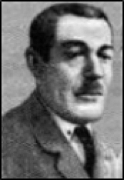 Abilov Ibrahim Maharram oglu was born in 1882, in Ordubad city. He was a member of Parliament of Azerbaijan Democratic Republic and socialists faction. Abilov was one of the first Azerbaijani diplomats and ambassador of the Soviet Azerbaijan in Turkey. He did not complete his education in M. T. Sidghi’s “Akhtar” school in Ordubad, because of the family difficulties arisen out of his father’s death. From 1903, he worked as a worker in Port-Petrovsk (present Mahachgala) and Baku, then joined in revolutionary movement and became a Menshevik member of “Hummat”. He was one of the organizers of Baku Caspian mercantile marine seamen’s strike in 1907. In 1908, Abilov was sent to Iran under the instruction of Nariman Narimanov who was a leader of social-democratic party in the South Caucasus and the South Azerbaijan. After returning to Baku in 1909, he became editor-in chief of “Baku life” magazine (1912). Abilov was arrested by tsarist government for many times and was sent into exile to Astrakhan in 1913. After the overthrow of tsarist government, Abilov came back from exile and became a distinguished political figure of Menshevik “Hummat” party in Tbilisi.
Abilov Ibrahim Maharram oglu was born in 1882, in Ordubad city. He was a member of Parliament of Azerbaijan Democratic Republic and socialists faction. Abilov was one of the first Azerbaijani diplomats and ambassador of the Soviet Azerbaijan in Turkey. He did not complete his education in M. T. Sidghi’s “Akhtar” school in Ordubad, because of the family difficulties arisen out of his father’s death. From 1903, he worked as a worker in Port-Petrovsk (present Mahachgala) and Baku, then joined in revolutionary movement and became a Menshevik member of “Hummat”. He was one of the organizers of Baku Caspian mercantile marine seamen’s strike in 1907. In 1908, Abilov was sent to Iran under the instruction of Nariman Narimanov who was a leader of social-democratic party in the South Caucasus and the South Azerbaijan. After returning to Baku in 1909, he became editor-in chief of “Baku life” magazine (1912). Abilov was arrested by tsarist government for many times and was sent into exile to Astrakhan in 1913. After the overthrow of tsarist government, Abilov came back from exile and became a distinguished political figure of Menshevik “Hummat” party in Tbilisi.
Abilov came to Baku in late 1918, was elected to the parliament of Azerbaijan Democratic Republic and became a member of socialists’ faction. In 1920, he was editor-in chief of Baku Mensheviks’ newspaper “Iskra”.
After the soviet power was set up in Azerbaijan, he became a deputy minister of internal affairs of soviet socialist republic of Azerbaijan. He was elected the secretary of Eastern Peoples Propaganda and Agitation Council in the first congress of the eastern peoples convened in Baku. On July, 1921, he participated in the 3rd congress of communist international as a amember of Azerbaijani delegate. Starting from 1921, on the recommendation of N. Narimanov, he became an Ambassador Extraordinary and Plenipotentiary of Azerbaijan SSR and then Transcaucasia Soviet Federative Socialist Republics in Turkey. Abilov played the leading role in establishment of Soviet-Turkey, as well as Azerbaijan-Turkey friendly relationships. On his initiative the consulates of Azerbaijan were opened in Trabzon and Samsun cities of Turkey. Many bilateral and multilateral agreements were signed between Soviet republics and Turkey owing to Abilov’s great efforts. He also signed the Moscow and Kars agreements in 1921 that paved the way for autonomy of Nakhichevan. There were strong friendship relations between Ibrahim Abilov and the founder and the first president of the Republic of Turkey Mustafa Kamal Ataturk. Abilov presented to Ataturk a gold sword as a sign of friendship and brotherhood on behalf of Azerbaijan Government.
Abilov died on February 23, 1923, in Izmir city of Turkey. He was buried in Baku.
Agamalioglu Samad aga
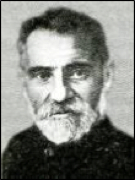 Agamalioglu Samad aga Hasan oglu was born on December 27, 1867 in the village of Kyrag Kesemen of Qazakh district, Elisabethpol Governorate. He was a statesman, educationalist and leader of the socialists’ faction in the parliament of the Azerbaijan Democratic Republic. Agamalioglu graduated from Vladikavkaz military school, trained as a surveyor. In 1887 he entered to the military service of Ganja, soon later started to read about Marxism and became a socialist revolutionary and active member of Muslim Social Democratic Party. After the February Revolution of 1917, he became a member of the Board and Executive Committee of the Russian Social Democratic Labor Party in Ganja, actively participated in the Hummet activities. Since the end of 1918, he worked in Baku. He was chosen as a deputy to the Muslim Socialist Bloc in Azerbaijani National Council of Azerbaijan Democratic Republic. In 1922-29 he served as the CEC Chairman and one of the chairmen of the CEC of Transcaucasian Socialist Federative Soviet Republic. At the 1st Congress of Soviets of the USSR (1922), he was elected a member of the CEC of the USSR, then a member of the Presidium of the USSR Central Executive Committee. He led the introduction of romanized alphabet to the republics of the Soviet East. Agamalioglu is also author of several works on the revolutionary movement, the Cultural Revolution in the Eastearn parts of the Soviet Union. He was also the first collector and the publisher of the famous Kamaluddovle Mektublari by the celebrated Azerbaijani playwright Mirza Fatali Akhundov. The cultural icon of the era Maxim Gorky called Agamalioglu a "marvelous man" and highly appreciated his works on the newly reformed alphabet. He died in Moscow on October 6, 1930.
Agamalioglu Samad aga Hasan oglu was born on December 27, 1867 in the village of Kyrag Kesemen of Qazakh district, Elisabethpol Governorate. He was a statesman, educationalist and leader of the socialists’ faction in the parliament of the Azerbaijan Democratic Republic. Agamalioglu graduated from Vladikavkaz military school, trained as a surveyor. In 1887 he entered to the military service of Ganja, soon later started to read about Marxism and became a socialist revolutionary and active member of Muslim Social Democratic Party. After the February Revolution of 1917, he became a member of the Board and Executive Committee of the Russian Social Democratic Labor Party in Ganja, actively participated in the Hummet activities. Since the end of 1918, he worked in Baku. He was chosen as a deputy to the Muslim Socialist Bloc in Azerbaijani National Council of Azerbaijan Democratic Republic. In 1922-29 he served as the CEC Chairman and one of the chairmen of the CEC of Transcaucasian Socialist Federative Soviet Republic. At the 1st Congress of Soviets of the USSR (1922), he was elected a member of the CEC of the USSR, then a member of the Presidium of the USSR Central Executive Committee. He led the introduction of romanized alphabet to the republics of the Soviet East. Agamalioglu is also author of several works on the revolutionary movement, the Cultural Revolution in the Eastearn parts of the Soviet Union. He was also the first collector and the publisher of the famous Kamaluddovle Mektublari by the celebrated Azerbaijani playwright Mirza Fatali Akhundov. The cultural icon of the era Maxim Gorky called Agamalioglu a "marvelous man" and highly appreciated his works on the newly reformed alphabet. He died in Moscow on October 6, 1930.
Agayev Ahmed bey
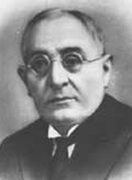 Ahmed bey Mirza Hasan oglu Agayev, also known as Ahmet Ağaoğlu was a prominent public figure and politician, Azerbaijani and Turkish publicist and journalist. He was recognized as one of the founders of pan-Turkism movement. Ahmed bey Agayev was a descendant of Karabakh khan - Panahali khan.
Ahmed bey Mirza Hasan oglu Agayev, also known as Ahmet Ağaoğlu was a prominent public figure and politician, Azerbaijani and Turkish publicist and journalist. He was recognized as one of the founders of pan-Turkism movement. Ahmed bey Agayev was a descendant of Karabakh khan - Panahali khan.
Ahmed bey was born in 1869 in the town of Shusha, Azerbaijan. In 1888, he arrived in Paris and came under the influence of French Orientalists like Ernest Renan and Professor James Darmesteter on Persiano-centricism. He was a well-educated person of his time, who had graduated from the Universities in Saint Petersburg and the Sorbonne University in Paris. He was also a famous journalist, who spoke fluently in five languages and therefore, wrote articles on current affairs for many popular newspapers in the country and abroad. He returned to the Caucasus in 1894. In 1896 he went to Shusha and taught French at school.
Ahmed bey Agayev considered the cultural and educational progress to be the major provision for the national liberation. He viewed the emancipation of women as part of this struggle. Thus, Agayev was the first member of the Azeri national intelligentsia to raise his voice for the equal rights for women. In his book "Woman in the Islamic World" published in 1901, he claimed that "without women liberated, there can be no national progress".
Along with Nasib-bey Yusifbeyli, Agayev became a founder of "Difai" (Defender) National Committee in Ganja, which in 1917 merged with the Turkic Party of Federalists and Musavat into a single party. Fleeing police persecution and possible imprisonment, in late 1908, during the Young Turk revolution in the Ottoman Empire, Agayev moved to Istanbul. Along with other émigrés from the Russian Empire, like the pan-Turkist writers Yusuf Akçura and Ali bey Huseynzade, he became a key figure in the Turkish movement led by Akçura’s journal Türk Yurdu ("Turkish Homeland") and in the Türk Ocağı ("Turkish Hearth") movement, becoming its president. With increasing influence in the CUP (The Committee of Union and Progress) regime, in late 1915, he became a deputy advocating the Ottoman expansion policies to unite all Turkic nations.
Upon the establishment of Azerbaijan Democratic Republic (ADR) in May 1918, Agayev returned to Azerbaijan. He took up Azerbaijani citizenship, was elected to the Parliament (Milli Mejlis) and was chosen to represent ADR at the Paris Peace Conference in 1919. This mission was not carried out, however, due to his imprisonment by the British in 1919.
After the Soviet take over, Agayev had to leave the country. He moved to Ankara, Turkey and continued his journalistic and political activities there, working as the director of the press bureau, the editor-in-chief of the official newspaper Hâkimiyet-i Milliye ("National Sovereignty"), and as a close adviser of Atatürk,- the founder of the modern Turkish Republic.
Ahmed bey Agayev died in 1939 in Istanbul, Turkey.
Aghabeyov Mammad Sadikh bey
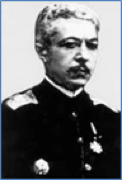 Aghabeyov Mammad Sadikh bey Ismail oglu - the Azerbaijani political figure; the founder and reformer of the Azerbaijani police, the companion (deputy) of Minister of Internal Affairs of the Azerbaijan Democratic Republic, major general, scientist-orientalist.
Aghabeyov Mammad Sadikh bey Ismail oglu - the Azerbaijani political figure; the founder and reformer of the Azerbaijani police, the companion (deputy) of Minister of Internal Affairs of the Azerbaijan Democratic Republic, major general, scientist-orientalist.
Mammad Sadykh bey was born on March 15, 1865 in the town of Goychay of the Baku Governorate. In 1883 he graduated from the Baku real school and upon its termination he entered the 2nd Konstantinovsky military college in Petersburg. In 1886 Aghabeyov began his service in a rank of the second lieutenant in the Caucasus. Ten years later, in 1896, successfully passing the exams, he was admitted to the St. Petersburg Institute of Oriental Languages at the General Staff. After graduating from this institute, in 1899 he was sent to Turkestan for further military service. In 1913, Sadykh bey retired from army in the rank of major general due to illness.
During his service in Turkestan, as the scientist-orientalist he was engaged in collecting national legends, folk tales and epics. As a result of titanic work Sadykh bey published the textbook “Turkmen Dialect”, for what the Emir of Bukhara awarded him a special diploma.
Having retired, Sadykh bey was sure that his military career terminated and that he would spend the rest of his life in his native Goychay. However World War I made some editions in his life. Sadykh bey was true to the oath. He returned to the army and fought in battles in the Caucasus and then on the Ukrainian front. On October 23, 1918 by the decision of the Government of ADR Sadykh bey was appointed the Deputy Minister of Internal Affairs of Azerbaijan. His term lasted until December 1919.
Sadykh bey’s offer about increase of the financial and budgetary funds allocated by the Ministry of Internal Affairs of ADR was one of the first steps in transformation of police. At the end of September - at the beginning of October, 1918 on his initiative in the old city the school of policemen was open.
Sadykh bey was seriously engaged in creation of regional structures of police agencies all across the country. Sadykh bey was fervent supporter of normative legal base’s use, but only with some changes of the former Russian Empire, which had no analog in world police practice of the end of XIX and the beginning of the XX centuries.
Sadykh bey played a big role in development of the concept on reforming of police of ADR. The concept provided police reforming in three stages (since July – December, 1918 till December, 1919)
In November, 1918 in connection with arrival in Baku of armies of allied powers the Baku police was reallotted to a temporary Commissariat of police of allied powers. However, despite of this fact, Sadykh bey continued to put into practice reforms in police.
Due to Sadykh bey Aghabeyov was developed the classification system for police officers. For example, in 1919 in Azerbaijan the total number of police officers reached 9661 persons, 498 of them were policemen of the 1st class, 5089 policemen of the 2nd class, 242 point duty officers of the 1st class and 243 point duty officer of the 2nd class.
After the withdrawal of British from Baku, ADR was in imminent danger. The threat proceeded from the armed activists of the left wing of a Bolshevist underground which had a very strong influence on armies.
The head department of the General Staff of the Ministry of Defense, which had duties to fight against the Bolshevism in armies, was compelled to leave in October, 1919 with the offer addressed to the government about creation of the Criminal Investigation Department under the Ministry of Internal Affairs of the republic, which could play a role of political police in armies. But during the discussion of this question Sadykh bey was categorically against it, as the idea of creation of the Azerbaijani national police in a democratic society, initially (after February, 1917) excluded the idea about political police itself.
Due to his activity, Sadykh bey was really a hero of that time. Life and time brought together this outstanding person with such prominent statesmen of Azerbaijan, as Fatali Khan Khoyski, Behbud Khan Javanshir, Halil Hasmammadov, Nasib Yusifbeyli, who as well as Sadykh bey, stood at the origins of creation of professional regular national Azerbaijani police.
After the ADR’s fall Sadykh bey emigrated to Turkey with his family, where they lived at relatives in Istanbul. He then moved to Paris where he taught the Turkish and Persian languages in Sorbonne for 2 years. In Paris, he had another strike of fate - death of his wife Gulnara. She was buried in a Muslim cemetery of the French capital.
After the death of his wife, at the beginning of February, 1927 by the invitation of Zygmunt Smogorzewski he moved to Lviv (Poland) where he started to work in Faculty of Philosophy at the Lviv University and later at the Lviv High Trade School where he taught the Turkish, Persian and Arabic languages, studying at the same time himself Polish and Ukrainian.
Z.Smogozhewski, V. Kotvich and Sadykh bey Aghabeyov were the main scientists of oriental studies school which later received the name of the Lviv and St. Petersburg school.
At the Lviv University Sadykh bey taught a number of disciplines: the Turkish language (modern and old Ottoman), the Persian language, the Arabic language, the Arab grammar, the Islamic studies, the Muslim paleography, calligraphy and epigraphy.
In 1931 Sadykh bey published his Turkish language textbook in the Polish language. In 1932, he published textbook about elementary grammar of the Arabic language, which had been written on the base of the second edition of “New Arabian Language Grammar” by Ogust Perye.
In Lviv Sadykh bey left a number of the pupils, such, as Teofil Volodimirski, Marjan Levitski, Omelian Pritsak, Tadeush Levitski, Frantisek Makhalski and many others. During the Nazi occupation, he was evicted from his apartment, having lodged in a badly heated room. In 1943 he was seriously ill, and on October 9, 1944, after liberation of Lviv, Sadykh bey Aghabeyov died. Olga Bak and her husband, who were the scientist’s pupils, took care of Sadykh bey till his last days. He was buried in the Lychakiv Cemetery, in Lviv.
The marble slab had an inscription on Polish and Turkish: “The general and professor Mohammad Sadykh bey Aghabeyzade (Aghabeyov) is buried here”.
Aghayev Hasan bey
 Hasan bey Meshadi Huseyn oglu Aghayev was born in Ganja, in 1875. A secondary education he got in a classical gymnasium of Ganja. Due to the patronage of Haji Zeynalabdin Taghiyev he entered the Moscow University, on medical faculty and graduated from the university with honors in 1901.
Hasan bey Meshadi Huseyn oglu Aghayev was born in Ganja, in 1875. A secondary education he got in a classical gymnasium of Ganja. Due to the patronage of Haji Zeynalabdin Taghiyev he entered the Moscow University, on medical faculty and graduated from the university with honors in 1901.
At the same time with his medical activity Hasan bey published some articles in newspapers and magazines.
On a commission from the organization “Hummet” his brochure "social estate, a class, a social stratum" was published in “Geyret” printing house of Jahleel Mammadguluzade, in Tbilisi (1906). Because of the edition of this brochure Aghayev was persecuted, he was forced to move to Iran and to live there some time.
After homecoming he became the editor of the “South Caucasus” newspaper which was issued in Ganja in the Russian language. He also led the society, which was devoted to the public education among Muslims. At the end of 1914 together with Hudadat bey Rafibeyli he created the first medical society in Ganja.
As well as in lives of other eminent political persons of Azerbaijan, February revolution of 1917 played a crucial role in Aghayev's subsequent life and activity.
Under already new conditions Hasan bey became one of the founders of the “Turkic Party of Federalists” (Türk Ədəmi-Mərkəziyyət Partiyası). Hasan bey Aghayev participated in the congress of the Caucasian Muslims which was held in Baku.
The “Turkic Party of Federalists”, directed by Nasib bey Yusifbeyli amalgamated with the “Musavat” party of Mammad Amin Rasulzade in a new party named the "Turkic Party Federalists-Musavat", in June, 1917.
At Musavat's first congress on October 26-31, 1917 Hasan bey was elected the member of the central committee of party, and later, in the end of the year - the representative in the All-Russian constituent assembly.
Due to the October revolution the All-Russian Constituent Assembly didn't take place; his representatives, having gathered on February 10, 1918 in Tbilisi, formed the Transcaucasian Seim – the superior body of the power in the South Caucasus. On April 22nd they declared the sovereignty of the South Caucasus and created the power of the Transcaucasian Democratic Federal Republic. Being the member of the Muslim fraction in the Transcaucasian Seim, Hasan bey participated in all actions very actively.
But the Transcaucasian Seim and the power were unable to accord with people's national interests who lived in this territory, result of what it was dismissed on May 25, 1918.
On May 27 the Muslim fraction of the Transcaucasian Seim declared itself The National Council of Azerbaijan and elected the Council Presidium. Hasan bey Aghayev was elected the vice-chairman of the Council.
Hasan bey Aghayev was the first one, who signed the Act of Independence of Azerbaijan on May 28, 1918, in Tbilisi at the solemn meeting which has been carried out under the chairmanship of Hasan bey Aghayev in the former palace of the deputy in the Caucasus.
On June 16, 1918 the National Council and the Power of Azerbaijan were transferred to Ganja.
At the first meeting which has been carried out here on June 17, due to the current situation the National Council temporarily suspended its activity and hand over the administration of all power to the new Government. At that period Hasan bey Aghayev worked at a position of the chief physician of the Railway Administration of Azerbaijan till the solemn opening of the Parliament of Azerbaijan on December 7, 1918.
Hasan bey Aghayev was elected the first vice-chairman of the Parliament of the Azerbaijan Democratic Republic at its first official meeting. To a position of the chairman of the Parliament was appointed Alimardan bey Topchubashov, but because of his absence in Baku, Hasan bey Aghayev placed himself at the head of the parliament.
In December, 1919 Aghayev was re-elected on a position of the vice-chairman of the Parliament and was at the head of it till February 2, 1920.
After April occupation (1920) Hasan bey emigrated to Tbilisi where he was killed by the hired Armenian terrorist on July 19. He was buried in a Muslim cemetery in Tbilisi.
Akhu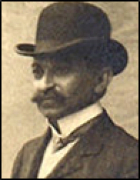 ndov Bahram bey
ndov Bahram bey
Bahram bey Jafar oglu Akhundov was born in Shusha in 1872. During the years 1893-1895 he studied medicine and nature study in France. He worked as a doctor in “Ittihad” school in Baku and was a member of “Nijat” and “Safa” societies. According to the law of the Azerbaijan National Assembly, he was entered into the parliament of the Azerbaijan Democratic Republic. In 1919, the medical control of the students going to study abroad was entrusted to Akhundov by the Azerbaijani Government. After the April occupation, he worked as a doctor in different medical facilities and was given the award of “Labor Hero”.
He died in 1932 in Baku.
Akhundov Jafar
Akhundov Jafar (? –?) – one of the participants of the National Liberation Movement of Azerbaijan. He was a member of the Muslim fraction, and after the Transcaucasian Seim’s dissolution (on May 26, 1918) he was a member of the National Council of Azerbaijan. He participated in adoption of the declaration of Independence of Azerbaijan (on May 28, 1918, in Tbilisi,), where he abstained from voting. He also was one of the leaders of the Muslim Social Democrats of the Mensheviks’ party "Hummet" in Tbilisi.
Akhundzade Haji Molla Selim
 Akhundzade Haji Molla Selim Mirza Ismail Gasir oglu was born in 1872 in Lankaran. He was a public figure, politician, a member of the Azerbaijan Democratic Republic’s Parliament. Within the Parliament he was a member of “Musavat” party’s fraction and nonpartisan.
Akhundzade Haji Molla Selim Mirza Ismail Gasir oglu was born in 1872 in Lankaran. He was a public figure, politician, a member of the Azerbaijan Democratic Republic’s Parliament. Within the Parliament he was a member of “Musavat” party’s fraction and nonpartisan.
He got his primary education at school, opened in Lenkoran by his father Mirza Ismail Gasir (1805-1900), and then he finished a gymnasium. Over a period of 8 years he continued the training in Ardebil, Zenjan, Najaf, where he studied theology. Coming back to Lenkoran he worked in municipal police department, then at a position of a secretary of the landowner Asker khan Talishinski. Later he worked as a mullah. Since 1911 taught Sharia and French in a city gymnasium. At the beginning of 1915 he moved to Turkey. In the summer of 1917, having returned home, he joined “Musavat” party. He participated at the first congress of “Musavat” (26-31th of October, 1917), participated in the Transcaucasian Commissariat’s activity, and became a member of the Transcaucasian Seim’s Muslim fraction. Akhundzade was a member of the National Council of Azerbaijan. In 1918 he active participated in a cleansing of Zangezur from the Armenian bands, headed by Andronik. On May 28, 1918 at the meeting of the National Council of Azerbaijan, which took place in Tbilisi, the Act of Independence of Azerbaijan was adopted. Akhundzade was one of the 24 members of the National Council, who voted for adoption of this Act.
Akhundzade was elected the deputy in ADR Parliament, and took part at the second congress of “Musavat” (on December 2-11, 1919).
Later on, when Azerbaijan was occupied by the Soviet army, Akhundzade moved to Iran, to the city of Enzeli, where he taught Sharia at a state school. Akhundzade was one of those, who led the activity of musavatists in Iran.
Akhundzade died on December 15, 1930 in Iran.
Akhundzade Mammadsadikh
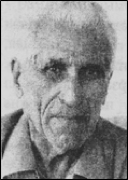 Akhundzade Mammadsadikh Samikh oglu (Mammad Sadikh Aran) was born in 1895 in the village Urud of the Zangezur district in a family of the priest. His grandfather was a sheykhulyislam of the Caucasus, in Tbilisi. His father was one of the prominent representatives of the intellectuals of that period.
Akhundzade Mammadsadikh Samikh oglu (Mammad Sadikh Aran) was born in 1895 in the village Urud of the Zangezur district in a family of the priest. His grandfather was a sheykhulyislam of the Caucasus, in Tbilisi. His father was one of the prominent representatives of the intellectuals of that period.
Mammadsadikh got his primary education at the village school constructed by his father, and then he finished the elementary school in Garakilse. Mammadsadikh continued the education at the 8-year Russian school in Nakhchivan.
In 1917 Mammadsadikh Akhundzade opened a school, in Goris. He himself was engaged in the training of the children. After the declaration of the Azerbaijan Democratic Republic on May 28, 1918 he was elected the ADR’s parliamentary deputy, from Zangezur. Mammadsadikh Akhundzade was also a member of the “Musavat” party’s commission dealing with refugees’ problems.
During some period, after the ADR’s fall on April 27, 1920 Mirza Mammadsadikh Akhundzade directed the underground organization of the “Musavat” party, which has been operating in Karabakh. Later he emigrated to Turkey. Coming back to Azerbaijan, he was arrested in Tbilisi. After two years of imprisonment, he was released in 1924. After that he went to Iran, and from there to Turkey.
Mammadsadikh Akhundzade worked in Finland for two years. There he was engaged in issuing of the "Turan" newspaper. In 1936-1941 he worked as a correspondent of the Turkish newspapers "Ulus" and "Jumhuriyat" in Iran. For a long period of time he worked at the Institute of researches of Turkic culture, in Ankara. Mammadsadikh Akhundzade died in Istanbul, in 1971.
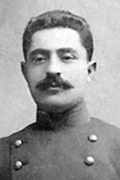
Akhundzade Rasheed bey
Akhundzade Rasheed bey – was one of the members of the National Liberation Movement. He also was a member of the Azerbaijan Democratic Republic’s Parliament. According to Parliament’s foundation law he was included into Parliament structure from Salyan. From January 1 to February 5, 1919 Akhundzade was a chief of the executive office of ADR government. According to the government resolution of February 5, 1919 Akhundzade was appointed to a position of the governor of Baku. He worked at this position till August 25, 1919.
Hagverdiyev Abdurrahim bey
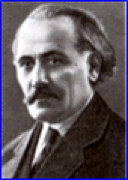 Hagverdiyev Abdurrahim bey Asadbey oglu was the Azerbaijani writer, a playwright, a translator, a publicist, a theatrical and public figure, the classic of the Azerbaijani literature. He was the honored worker of arts of Azerbaijani the Soviet Socialist Republic (1928), the first diplomat of Azerbaijan and the first conductor during demonstration of the opera "Leyli and Medjnun".
Hagverdiyev Abdurrahim bey Asadbey oglu was the Azerbaijani writer, a playwright, a translator, a publicist, a theatrical and public figure, the classic of the Azerbaijani literature. He was the honored worker of arts of Azerbaijani the Soviet Socialist Republic (1928), the first diplomat of Azerbaijan and the first conductor during demonstration of the opera "Leyli and Medjnun".
Abdurrahim bey Hagverdiyev was born in 1870 in the town of Shusha. His father Asadbey was a secretary in the district administration. At the age of three years he lost his father and had to live at the uncle’s place for some time. In 1880 he was sent to school by his stepfather Sadihbeyov. In 1890 Hagverdiyev finished the sixth class of the Shusha real college and entered the last class of the Tbilisi real college.
In 1891 Hagverdiyev completed his studies in Tbilisi and went to Petersburg to continue the education. He entered the Institute of Engineers of Railway Transport, and at the same time attended the courses of the east faculty of the University as an auditor.
In Petersburg to be playwright continued being interested in theater, often visits the Aleksandrinsky Theater to watch its performances. His first drama works "Eat goose meat and you’ll learn its taste" (1892) and "The ruined nest" (1896) were written in Petersburg.
In the drama "The Ruined Nest" ("The scattered union") Hagverdiyev represented moral degradation of the Russian and Azerbaijani nobility at the end of the XIX century, the social and family tragedy of the landowner. It was Hagverdiyev, who for the first time in the Azerbaijani dramatic art created an image of the young man struggling against patriarchal feudal system in the play named "The Unfortunate young man" (1900). In the historical tragedy "Agha Mohammed Shakh Khadjar" (1907) he created the generalized image of the east despot. Hagverdiyev's play "The enchantress Peri" (1901), which reflected the influence on the creativity of symbolist dramatic art, approved the idea of nonresistance to the evil. He also was the author of such realistic prosaic works as a cycle of stories "My Deers", the stories "Infernal Letters of a Fright", stories "The Bomb", "Sheikh Shaban", "Mirza Safar" and etc. A.Hagverdiyev played an important role in the Azerbaijani musical culture. He was the organizer of the first scenic performance based on one of the main genres of the Azerbaijani traditional music – Mugam.
Hagverdiyev's best works express a protest against the oppression of the people, call on to fight against the remains of the feudalism and ignorance. A.Hagverdiyev, as well as N. Vezirov, showed the demoralization of the feudal system, moral degradation of the landowners, but in addition to that he expanded the frameworks of the novels of everyday life, extended a social sense of his plays, created the images of the heroes fighting for justice and protesting against violence. The author’s plays were in all Azerbaijani pre-revolutionary troupes. Hagverdiyev participated in the development of the national theater as well as the organizer and the director.
In 1899-1900 he directed the drama troupe of Shusha and later, together with G. Makhmudbeyov and D. Zeynalov worked in the Baku troupe, where he carryied out the staging of the performances. Hagverdiyev achieved considerable successes in the activity of this collective and since 1900 the troupe became a professional one. In 1901-1903 he staged at this theater the plays of Nadjaf-bey Vezirov, M.F.Akhundov and etc. A.Hagverdiyev directed the troupe till 1904. Hagverdiyev was the ideological head of the national theater during its formation, headed the fight for the scenic realism, a democratic orientation of the Azerbaijani theater, he aspired to enrich the repertoire, to make use of the experience of the advanced Russian culture, to achieve the naturalness and the ensemble in the actor's performance.
In 1906 he was elected the deputy of the First State Duma from the Elizabethpol’s province.
Since 1907 Hagverdiyev was one of the leading authors of the fighting democratic magazine "Mullah Nasreddin", where he placed stories, feuilletons, articles which were sharply criticizing the bourgeois and landowner system and the ruling classes.
In 1919 Hagverdiyev was appointed the diplomatic representative of the Azerbaijan Democratic Republic in the Mountain Republic, and then in Armenia.
During the Soviet power’s rule he worked as a head of the art department in the National commissariat of education, as a chairman of the Society of research and studying of Azerbaijan, as a teacher at the Azerbaijani State University.
During the Soviet period he also wrote such plays as "In a Tree Shadow" (1926), "The Old Generation" (1927) – the play where he opened a subject of crash of the noble world in a new way and condemned past remains, "A female holiday" (1928), "Comrade Ker-oglu" (1932). Hagverdiyev's plays were shown at the Azerbaijani drama theater of Azizbekov and other collectives of the republic. He also was the author of a sketch "From history of the Azerbaijani theater". He translated Shakespeare ("Hamlet"), Schiller, Gorky, Chekhov and etc.
Hagverdiyev Abdurrahim bey died in Baku, in 1933.
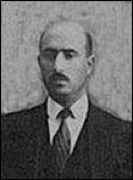 Aminov Aghakerim
Aminov Aghakerim
Aminov Aghakerim Meshedi Kerim oglu was born in Baku in 1888. In 1907 he finished the Baku Gymnasium with honors. In 1916 he graduated from the Petersburg Polytechnical Institute. In 1912, being a student, he underwent a practical training in Pyatigorsk. After the graduation, he returned to Baku, where he worked as an expert in the Sabunchi-Surakhani Oil Trade. Later he took postgraduate courses in London. He was a politician and a statesman.
In 1912, Aminov joined the “Musavat” party. In April, 1917 he participated in the “Caucasian Muslims in Baku” congress activity and also took part in work of “Musavat” party at the same year. In 1918, when the ADR was esatablished he was elected a member of the parliament. He held a post of the Minister of Trade and Industry in the Fourth Governmental Cabinet of ADR. In May, 1919 due to his active participation the “Alliance of the Muslim Working Intellectuals” was set up.
After the transition period to the Soviet regime he worked in the "Azneft"association system. He died in 1921 of a serious illness.
Amirjanov Abdulali bey
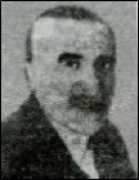 Amirjanov Abdulali bey Shirali bey oglu was born in 1870 in Sheki. During the period of 1876-1883 Amirjanov Abdulali bey received training at the Sheki city school. In 1888 he graduated from the Aleksandrov Teacher's Institute in Tbilisi. Then he was appointed the teacher of the Sheki city school. At the end of the XIX century he worked as a teacher in Lenkoran. He was a political figure and an enlightener.
Amirjanov Abdulali bey Shirali bey oglu was born in 1870 in Sheki. During the period of 1876-1883 Amirjanov Abdulali bey received training at the Sheki city school. In 1888 he graduated from the Aleksandrov Teacher's Institute in Tbilisi. Then he was appointed the teacher of the Sheki city school. At the end of the XIX century he worked as a teacher in Lenkoran. He was a political figure and an enlightener.
At the beginning of the XX century Amirjanov worked as a teacher in Baku, an accountant in public institutions and the various companies, was the vice-chairman of the Baku Muslim charitable society.
Later on February revolution of 1917, he actively joined in political processes. Amirjanov was a member of the Interim Executive Committee of the Baku Muslim public organizations. In March, 1918 he tried to prevent the mass slaughter made by Bolshevist-dashnak groups against the muslim-Turkic population.
Amirjanov held a post of the Minister of Finance (June-October, 1918) and the public supervisor (October-December, 1918) in the Second Governmental Cabinet of the ADR. In December, 1918 he was voted the deputy into the ADR parliament, where he became a member of non-parties fraction.
Abdulali bey Amirjanov was also a member of the commission (formed on July 29, 1918 by the governmental decree) dealing with reorganization of food business in Azerbaijan.
Unfortunately, the young republic inherited from the former era the hardest financial crisis caused by a general crisis of production and the exchange rate falling shown up in a lack of money. In connection with this, Amirjanov was faced with a problem of improvement of the precarious financial position, the restoration of pecuniary, the bank and the tax systems of Azerbaijan.
During the period of Amirjanov’s being the Minister of Finance, the Second Government of Fatali-Khan Khoyski, a week later after its formation in June, 1918, made the decision on renewal of bank registration operations, having started the mechanism of banking system’s activity in the independent Azerbaijan.
Amirjanov played a big role in the standard’s ordering of the country, particularly in acceptance by the government (at the beginning of October, 1918) of the resolution of the unified banknotes’ establishment being in use in the republic. According to that resolution the former all-Russian money (“Nikolaevsky” and “Kerensky” notes), the Baku and the Transcaucasian paper money got equality in cost.
Amirjanov was also engaged in formation of the independent tax system corresponding to the proclaimed democratic principles of the Azerbaijan Government. Being a confirmed statesman and democrat he accepted the measures which led to collision of interests of the government with the interests of private financial and industrial circles.
The department headed by Amirjanov paid attention to that circumstance that numerous Baku offices of joint-stock companies evaded additional tax on trade and income tax, enjoying a favor of their central boards outside Azerbaijan. For the purpose of change of this situation the Ministry of Finance prepared the resolution on involvement to taxation by an additional tax on trade of the enterprises of these joint-stock companies, which was accepted by the government on October 7, 1918.
At the same time there was prepared the resolution on tax collection of the commerce and industry enterprises’ acceleration of profit and its distribution on the enterprises which boards were outside the ADR. Creation of the Head department of excise tax under the Ministry of Finance became one of Amirjanov's important achievements. Further he became one of the eminent persons of the Azerbaijani parliament and took the most active part, particularly, in development of the legislation on improvement of living conditions of needy segments of the population.
Amirjanov was one of the founders of the “Deyanet” foreign trade association (1919).
After establishment of the Soviet power in Azerbaijan he emigrated to Turkey where he became a member of the Azerbaijani national center. Abdulali bey Amirjanov died in 1948 in Istanbul.
Asadullayev Mirza
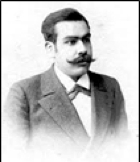 Asadullayev Mirza Shamsi oglu – was the Azerbaijani businessman, a public figure, a Maecenas; the eldest son of the richest petroindustrialist and Maecenas of Azerbaijan Shamsi Asadullayev.
Asadullayev Mirza Shamsi oglu – was the Azerbaijani businessman, a public figure, a Maecenas; the eldest son of the richest petroindustrialist and Maecenas of Azerbaijan Shamsi Asadullayev.
Mirza Asadullayev was born in 1875 in Amirajan's village of the Baku district of the Baku province, in a family of millionaire Shamsi Asadullayev. He got his secondary education in the Baku gymnasium. After being educated he started to work for the father’s company "Shamsi Asadullayev's Trade Affairs". Since 1903, when Shamsi Asadullayev moved to Moscow he headed the company work in Baku.
Later he became a chairman of the Baku Muslim charitable society and on March 11, 1915 started issuing the “Gardash Komeyi” newspaper ("The brotherly help"). After February revolution of 1917, Asadullayev in March, 1917 was elected a member of the Interim executive committee of Muslim national council. Since 1918 Asadullayev was a chairman of the board of congress of the Baku petroindustrialists. After declaration of the Azerbaijan Democratic Republic he was elected the deputy in Parliament. Being in the Parliament he was a member of the “Musavat” fraction and non-parties. In the Third Governmental Cabinet of the ADR he held a post of the Minister of Trade and Industry (December, 1918 – March, 1919). After the Soviet power’s establishment in Azerbaijan in May 1920 he was arrested. Later he managed to emigrate with his family to Europe.
Mirza Asadullayev died in 1936 in Paris and was buried in a Muslim cemetery in the city of Bobinyi, near Paris.
Ashurov Agha
 Ashurov Agha Haji Aslan oglu was a public figure, politician a statesman. He was born in 1880 in Baku.He finished the Baku gymnasium and then got an education on the specialty of technologist in Germany. Returning home he worked in the administration of Baku municipal duma.
Ashurov Agha Haji Aslan oglu was a public figure, politician a statesman. He was born in 1880 in Baku.He finished the Baku gymnasium and then got an education on the specialty of technologist in Germany. Returning home he worked in the administration of Baku municipal duma.
In 1908 the agreement of new electric power station construction in Baku was signed under the direct leadership of Ashurov. He also participated in laying the Shollar water in Baku. He was one of the leaders of the society "Nashri-maarif", and also a member of the Baku City Duma. He was a member of the Interim Executive Committee of the Muslim National Council. Ashurov participated at the congress of the Muslims of the Caucasus in Baku. During the period of March slaughter in 1918, being in the Delegation of Muslims, he was partly to conciliatory negotiations with members of Revolutionary committee, with the Armenian National Council and with the consul of Iran in Baku – Khabibulla khan.
Ashurov worked at the post of the Minister of trade and Industry, and later the Minister of Food in the Second Governmental Cabinet of the Azerbaijan Democratic Republic. On October 6, 1918 in connection with changes in the Government structure he was appointed to a post of the Minister of Post Service and Telegraph.
On April 27, 1920 Ashurov became the only member of the Parliament of Azerbaijan, who voted against to hand over the power to Bolsheviks. Due to this Bolsheviks decided to arrest Ashurov, but they didn’t manage to detain him.
Having no opportunity for emigration to Turkey, Ashurov moved to Rostov-on-Don, where he worked as a processing engineer. Ashurov Agha died in 1936 and was buried in the Tatar cemetery in Rostov-on-Don.
Atamalibeyov Abbas
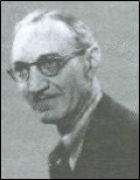 Atamalibeyov Abbas Seyfulla bey oglu was born on February 26, 1895, in Tbilisi. He was one of the students sent for studying abroad according to the special resolution of the Parliament of Azerbaijan Democratic Republic. He was a renowned representative of Azerbaijan political migration. He got his primary education in Shamakhi, Tbilisi. He entered into the marine engineering department of Petersburg Polytechnic University; in that period he joined to the right socialist revolutionaries and was elected a head of the Muslim countrymen committee. He participated in the revolutionary movement in Russia, and due to the utter chaos went back to Caucasus and continued his political activity in socialist revolutionaries’ party. Atamalibeyov was a member of the National Council and “Socialists’ bloc” faction in the Parliament of Azerbaijan Democratic Republic. According to the resolution of the Parliament dated September1, 1919, he was sent to Paris University (France) in order to continue his education in the field of shipbuilding. The Ministry of Foreign Affairs of Azerbaijan had seconded him to France in substitute for M. Maharramov, the member of Azerbaijani delegation in Paris Peace Conference and he acted as a secretary to the delegation.
Atamalibeyov Abbas Seyfulla bey oglu was born on February 26, 1895, in Tbilisi. He was one of the students sent for studying abroad according to the special resolution of the Parliament of Azerbaijan Democratic Republic. He was a renowned representative of Azerbaijan political migration. He got his primary education in Shamakhi, Tbilisi. He entered into the marine engineering department of Petersburg Polytechnic University; in that period he joined to the right socialist revolutionaries and was elected a head of the Muslim countrymen committee. He participated in the revolutionary movement in Russia, and due to the utter chaos went back to Caucasus and continued his political activity in socialist revolutionaries’ party. Atamalibeyov was a member of the National Council and “Socialists’ bloc” faction in the Parliament of Azerbaijan Democratic Republic. According to the resolution of the Parliament dated September1, 1919, he was sent to Paris University (France) in order to continue his education in the field of shipbuilding. The Ministry of Foreign Affairs of Azerbaijan had seconded him to France in substitute for M. Maharramov, the member of Azerbaijani delegation in Paris Peace Conference and he acted as a secretary to the delegation.
Atamalibeyov was renowned for his political activities in migration circles in Paris. Benefiting from the opportunities given by the policy of France government against the USSR to the migrants, he graduated from the school of political sciences in Paris. He belonged to the group which was in opposition to Mammad Amin Rasulzade. Atamalibeyov periodically participated in political events and debates of the League of Nations, the headquarters of which was situated in Geneva. After the death of Alimardan bey Topchubashov (1934) he became a leader of Azerbaijani migrants in Paris. Many of his articles about the South Caucasus were published in “Review de Prometheus” and “O” magazines.
After the occupation of France by Germany, Atamalibeyov lived in Berlin, worked there in Red Cross Committee and did his best to release Azerbaijani captives. He continued his political activity and was involved in the group consisting of three persons (together with A. Fatalibeyli-Dudenginski and F. Amirjan) connecting up Azerbaijani legion with Hitler’s army headquarters. Atamalibeyov was one of the initiators of establishment of the Caucasus Council in October, 1944 and participated in the meeting of the Council held in 1947 in Lausanne. Later, for some period of time he lived in Chile, in the Arab Republic of Egypt and from 1967 in the USA. He fought for the independence of Azerbaijan by the end of his life and did not lose his confidence in returning home. He died after a long-term serious illness.
He died in 1971 in Cleveland.
Chamanzaminli Yusif Vazir
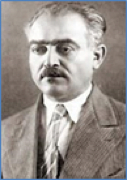 Yusif Vazir Chamanzaminli (born Yusif Mirbaba oghlu Vazirov) was born on September 12, 1887 in a town of Shusha, in a family of Meshedi Mirbaba bey Vazirov and Seyid Aziza Seyid Husein gizi. The surname of Vazirov is connected with one of the influential viziers of the Karabakh khanate of Mirza Jamal Javanshir, holding this post during the period of Ibrahim Halil Khan and Mekhtikuli Khan governing. This surname was passed from one generation to the next.
Yusif Vazir Chamanzaminli (born Yusif Mirbaba oghlu Vazirov) was born on September 12, 1887 in a town of Shusha, in a family of Meshedi Mirbaba bey Vazirov and Seyid Aziza Seyid Husein gizi. The surname of Vazirov is connected with one of the influential viziers of the Karabakh khanate of Mirza Jamal Javanshir, holding this post during the period of Ibrahim Halil Khan and Mekhtikuli Khan governing. This surname was passed from one generation to the next.
Having got a primary education at school of Mullah Mekhti who has become famous under the pseudonym “Khar Khalifa”, Chamanzaminli continued his study at the Russian school of the town of Aghdam. After graduating from the primary school in 1896, Chamanzaminli came back to Shusha where he pursued his studies at the Realschule which among average educational institutions of the Caucasus of that time was considered as one of the best. Studying there, he wrote his first poem “Complaint” in Russian. Yusif Vazir showed some verses to the teacher of Russian Klemiy. The teacher advised him to read Chekhov. Yusif Vazir liked Chekhov’s satirical stories very much and further it affected on his formation as a writer of short stories. Studying at the Realschule in Shusha, together with his cousin Mir-Hasan Vazirov (subsequently one of the 26 Baku commissioners) he issued the monthly comic magazine in Russian “Conjurer”, which in spite of being small on volume, was quite serious according to its contents.
In 1907 Yusif Vazir went to Baku and entered the Baku real school. In 1911 he published his first work in the local Azeri-language periodicals “Sada” and “Molla Nasraddin”.
Having graduated in 1909 from the Baku real school Yusif Vazir left for St. Petersburg to enroll in St. Petersburg State University of Architecture and Construction Institute for Civil Engineers but having realized that he would not pass the placement test in mathematics, Chamanzaminli withdrew his application. Living in Petersburg he wrote one of the most known stories of him named “The Permit to Paradise” and the poem devoted to the national hero of Dagestan Shamil.
In 1910 Chamanzaminli was admitted to the St. Vladimir University in Kiev to study law. In spite of being far away from his motherland he always managed to communicate with Azerbaijan. Due to this Yusif Vazir published a lot enough in newspapers and the magazines issued in the homeland. During this period such works of him, as “The Actual Position of the Azerbaijani Moslem (woman)”, “Bloody tears”, “Mother and Motherhood” were issued. Later were written the articles “Autonomy of Azerbaijan”, “Who are we and what do we want?”, “History of the Lithuanian Tatars”, “Our foreign policy”, “Problems of our nation and culture” and etc.
When World War I broke out, the students and staff of the university were transferred to Saratov (Russia), where Chamanzaminli graduated in 1915. For a while he worked at the judiciary chamber of Saratov. But living and working there he couldn’t earn enough for a normal livelihood and it was the reason why he had to come back to Kiev. Returning to Kiev he joined the organization named “Zemstvo” and later went to the front. During the February revolution Yusif Vazir was in Galicia. There, reflecting on the February Revolution in Russia, he wrote the novels “Students” and “In the Year 1917”.
In 1917 Yusif Vazir came back from Galicia to Kiev. Here having brought together the Azerbaijani students, he established the Azerbaijani cultural association, which chairman he was elected. In 1918 he was appointed to represent the newly established Azerbaijan Democratic Republic in the Ukrainian People's Republic. At the same time he was the diplomatic representative of the Azerbaijan Democratic Republic in the Crimea, and Poland.
In 1918, because of the civil war the communication with Azerbaijan stopped suddenly and Yusif Vazir had to move to Simferopol and stay there for some months. Here he worked for a while as a judiciary advisor. The Crimean newspaper “Millat” published his article “Azerbaijan and Azerbaijanians”. In 1919 he published his research work “Lithuanian Tatars”, which was dedicated to the history and culture of Lipka Tatars. Coming back home he published in the “Azerbaijan” newspaper a series of articles “Our Foreign Policy”, “Our Ethnic and Cultural Questions”.
After a while according to the proposal of the Council of Ministers’ chairman Nasib-bey Usubbeyov he left for Istanbul to open the Azerbaijan Embassy there at the position of ambassador of the ADR. Being engaged in diplomacy, in Istanbul he managed to continue his literary activity. In 1921 he wrote at least two books that were published while he was in Turkey: “A Survey of Azerbaijani Literature”, and “The History, Geography and Economy of Azerbaijan”, which were full of scientific supervision of the writer.
After the Soviet Power’s establishment in Azerbaijan Yusif Vazir declared the termination of his activity. Now he left for Paris to join his younger brother Mir Abdulla, who was studying there diplomacy at the Paris Institute of Political Science. But being unable to find a job in his field there Yusif Vazir had to work in an automobile locomotive factory, in the Paris suburb of Clichy. At the same time he also cooperated with the “Paris News” newspaper, publishing there the articles under the title “Eastern letters”.
After his younger brother’s quite unexpected death, Yusif Vazir saw little reason to continue living in Europe. He wrote letters to the representative of the Council in Paris and to the national commissioner Gazanfar Musabeyov, who was the chairman of the Azerbaijan Soviet Republic at that period. The chairman of the communist party of Azerbaijan Kirov was glad to know, that Yusif Vazir wanted to return. And this time, in 1926 Yusif Vazir came back home forever.
Upon his return, Yusif Vazir worked at the “Baku Worker” publishing house, at the position of editor of the art department. Later he worked at the public culture department of the State Committee for Planning and at the same time was engaged in teaching. He taught at the faculty of oriental studies and pedagogics at the Azerbaijan State University, and then at the faculties of the Azerbaijani and Russian languages at the Pedagogical, Medical and Oil Institutes. At the same time Yusif Vazir was one of the editors of the “Russian-Azeri dictionary” under Rukhulla Akhundov’s edition. In 1930-35 he published the novels “Maiden Spring”, “Students”, “In the 1917th Year” and the comic play “Hazrati Shakhriyar”.
Yusif Vazir translated various works of Russian writers into Azeri. In 1937 he finished the historical novel “Between two fires” (“Between the devil and the deep sea”), but he didn't manage to publish it. The novel was published with reductions in the “Azerbaijan” magazine only in 1960 and under the name “In Blood”. In 3-4 months prior to dismissal from the Azerbaijan Writers’ Union Yusif Vazir gave a screenplay of his work “Altunsach” to the “Azerfilm”. In spite of the fact that the work was approved by the governing body of “Azerfilm” the contract wasn’t signed, because of the criticism of his other novel “Students”.
Yusif Vazir wrote under the pseudonyms: “Sersem”, “Chamanzaminli Aligulukhan”, “Zarasb”, “Chamanzaminli Ali Khan” and “Gurban Said”.
In 1937 Yusif Vazir was discharged of work on various pretexts.
In 1940 he was condemned and sent to the camp for prisoners in Gorky Oblast to Sukhobezvodnoye station where he died in 1943.
 Efendizade Abdulla
Efendizade Abdulla
Abdulla Ismayil oglu Efendizade (Efendiyev) was born in 1873, in Sheki. He was an education worker and translator. He got his elementary education in Nukha (Sheki) district school in 1880-1888 years. Efendizade continued his education in Yelizavetpol (Ganja) technical school in 1888-1894 years, then in Alexander Teachers’ Institute in 1895-1898 years. He started his pedagogical activity in 1898 in Baku. In 1898-1920 years he acted as a teacher and principal in different schools. He took an active part in the first (1906) and second (1907) congresses of Caucasus Muslim Teachers. In 1908, he published the new draft alphabet which he prepared together with Suleyman Sani Akhundov and Farhad Aghazade and the manual titled “Second year”. Efendizade was elected deputy to the parliament of the Azerbaijan Democratic Republic from Nukha city. At first, he joined “Ahrar” faction in the parliament. In November, 1919, he separated from faction and declared himself left independent.
Efendizade was an author of “The last alphabet” manual published by the Azerbaijan Democratic Republic government in 1919. Efendizade translated the poems of I. A. Krilov and M. Y. Lermontov to Azerbaijani language.
He died in Baku.
Efendiza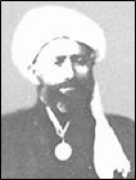 de Hamdulla
de Hamdulla
Efendizade Hamdulla efendi Ismayil oglu was born in 1888, in Galagah village of Devechi district of Guba region. He was a public figure, and a member of the Parliament of Azerbaijan Democratic Republic. He got his primary education in Muslim religious school. In 1906 he graduated from the two-class Russian school. He mastered Arabic, Persian and Russian languages. In April, 1918, he fought against the Armenian dashnaks rushed into Devechi district and committed massacres against the Azerbaijani people. Efendizade took an active part in political life of Azerbaijan and was one of the active members of “Ittihad” party. According to the law on the formation of Azerbaijan Parliament (November 19, 1918) of the National Council he entered to the parliament from Guba region, and became a member of “Ittihad” party. On April 17, 1920, together with his supporters he tried to prevent the bolsheviks’ armored train to enter to Azerbaijan, but because of unequal forces he had to make a retreat. In 1928, he was subjected to repressions, was sent into exile to Siberia and died there.
Efendizade Mukhtar
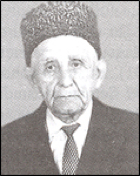 Efendizade Mukhtar (Mukhtar Efendi) Ismayil oglu was born on January 1, 1880, in Shamsabad village of the present Aghdash district. He was an educationalist, teacher, orientalist-translator and one of the active participants of freedom movement in Azerbaijan. Mukhtar Efendi got his primary education from his father. Afterwards, for 9 years he studied at Muslim religious school of his father’s friend Haji Mahammad efendi. For another 9 years he studied at Aghdash, Nukha, Guba, Baku and Shamakha scholars. In the early 20th century he wrote a book titled “Oxu” (reading) for children on the basis of a new method of teaching, as well as, he opened orphanage, course for adults, “Darulirfan” school, reading hall in 1906, new theatre in 1908, “Seadet” girls’ school in 1908. He taught at his own school on basis of New Testament at Guba.
Efendizade Mukhtar (Mukhtar Efendi) Ismayil oglu was born on January 1, 1880, in Shamsabad village of the present Aghdash district. He was an educationalist, teacher, orientalist-translator and one of the active participants of freedom movement in Azerbaijan. Mukhtar Efendi got his primary education from his father. Afterwards, for 9 years he studied at Muslim religious school of his father’s friend Haji Mahammad efendi. For another 9 years he studied at Aghdash, Nukha, Guba, Baku and Shamakha scholars. In the early 20th century he wrote a book titled “Oxu” (reading) for children on the basis of a new method of teaching, as well as, he opened orphanage, course for adults, “Darulirfan” school, reading hall in 1906, new theatre in 1908, “Seadet” girls’ school in 1908. He taught at his own school on basis of New Testament at Guba.
Armenian dashnaks’ attacks devastated many villages of Shamakha, Aghsu, Gutgashen (present Gabala), Ismayilli districts in 1918. During their attack to Goychay and Aghdash, Mukhtar Efendi organized a group of 200 people and prevented their further assault. According to the “Law on establishment of parliament of Azerbaijan” of Azerbaijan National Council, he was elected to the parliament of ADR from Arash district.
After the April occupation in 1920, he returned to Aghdash and continued his educational activities. Mukhtar Efendi was repeatedly subjected to physical and psychological pressures, his house was searched because of his political affiliation, and he was arrested and exiled to Kazakhstan. In 1939, he came back from exile and continued his pedagogical and scientific activity. In 1944-50, he taught Arabic language in Azerbaijan State University. His book titled “Miftah ül-lisan ül-ərəb” (the key of Arabic language) (1947) was one of the first textbooks of Arabic language for higher school students in the USSR.
Mukhtar Efendi died on October 17, 1975, in Baku. He was buried in Aghdash district, Shamsabad village cemetery.
Ganizade Sultan Majid
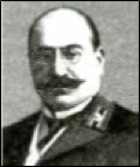 Ganizade Sultan Majid Haji Murtuzali oglu – was a man of science, a writer, a translator and a philologist.
Ganizade Sultan Majid Haji Murtuzali oglu – was a man of science, a writer, a translator and a philologist.
He was born in a merchant family, in Shemakha, in 1866. A primary education he got at school named “Majlis” (1872-1879), then continued his education at the local college of the 3rd category (1879-1882). Later he got one-year pedagogical training course (1883). In 1887 he graduated from Aleksandrovsky teacher's institute in Tiflis. At the same year, together with Habib bey Makhmudbeyov he opened the first Russian-Azerbaijani school in Baku, where he worked as a teacher (1887-1891). Then he worked at the position of the manager of the 2nd "Russian-Muslim" (1891-1898) and the highest primary colleges (1898-1905). Later he worked as an inspector of national schools’s management of Baku and Dagestan district’s province (1908-1917). For the period 1917-1918 he was a director of the national district schools.
In 1894 Sultan Majid Ganizade translated into the Azerbaijani language and made an amateur performance of Tolstoy's comedy "The first distiller or how the imp deserved a hunk of bread", written in 1885-89. In 1907 Haji Agha Abbasov together with the school head S. Ganizade came to the “Yasnaya polyana” and presented to Tolstoy the translation of the story on the Azerbaijani language. In response of this he received the book "War and peace" with the author’s autograph as a remembrance of the visit. Since 1886 and almost to Tolstoy’s death, Sultan Majid Ganizade wrote letters to Tolstoy. He could consult about problems of national education by means of those letters. He constantly received answers from Tolstoy and visited him in the “Yasnaya polana”.
In 1917 Ganizade was one of the organizers of the “Ittikhad” party. On May 28, 1918 he was elected a member of the National Council of Azerbaijan. During the process of voting for adoption of the Act of Independence Ganizade abstained from voting. Ganizade took active part in the Parliament work. In August, 1919 he was elected the vice-chairman of the Parliament.
In the period of the Soviet power he worked as the head of the department devoted to the preparation of textbooks and materials on home reading of the National commissariat of education of the Azerbaijan Soviet Socialist Republic (1920-1925). At the same period he worked at the position of an inspector of the Baku National Education’s management (1925-1929) and also taught at Military school and Iindustrial Institute.
Ganizade is the author of such novel as "Sheyda-bey Shirvani's Letters" (1898-1900), the story "The Fear of God" (1906), and etc. He showed difficulties of national life and criticized social injustice and ignorance in these works. He also was engaged with translation of the Russian, Georgian and Armenian classical writers into the Azerbaijani language. He was the author of "The Russian-Tatar dictionary" (1902) and "The Azerbaijani phraseological dictionary" (1904).
On June 26, 1936 Ganizade was arrested. On March 14, 1937 he was sentenced to be shot.
Garabeyli Gara bey
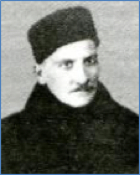 Garabeyli Gara bey Ismayil aga oglu was born on January 14, 1873 in Yukhari Ayibli village of Yelizavetpol province. He was public figure and politician, doctor, publicist, linguist-lexicographer and journalist. He went to Shemkir German-Russian lycée for his primary education. After graduating classical education gymnasium in 1892, he entered medical department of Moscow University. On studying there for 4 years, he was sentenced to 1 year imprisonment for his political activity in 1896. After being released from prison he continued his study in medical department of Yuryev (Tartu) University. On graduating the University in 1899, he worked in Moscow for two years.
Garabeyli Gara bey Ismayil aga oglu was born on January 14, 1873 in Yukhari Ayibli village of Yelizavetpol province. He was public figure and politician, doctor, publicist, linguist-lexicographer and journalist. He went to Shemkir German-Russian lycée for his primary education. After graduating classical education gymnasium in 1892, he entered medical department of Moscow University. On studying there for 4 years, he was sentenced to 1 year imprisonment for his political activity in 1896. After being released from prison he continued his study in medical department of Yuryev (Tartu) University. On graduating the University in 1899, he worked in Moscow for two years.
In 1901, he returned to Baku and worked as a doctor on his own. For the first time he opened a consulting room for venereal diseases in Baku. Garabeyli started his public activity under the influence of the first Russian revolution and took part in the first congress of Russian Muslims held on August 15, 1905, in Nizhny Novgorod. He was a member of “Ittifaqi-muslimin” (Muslims’ union), also one of the leaders of Ahmed bey Aghayev’s “Difai” party. From that time he started his activity as a publicist and cooperated with “Hayat”, “Irshad”, “Caspi” publications. Some sources say Garabeyli took part in establishment of “Hummat” as well. In 1906 he immigrated to Iran and continued his revolutionary activity there. But after occupation of Rasht he emigrated to Europe. He established “Seadet” organization in Istanbul in 1908. In 1911 he returned to Baku and continued his activity as a doctor and publicist. He published the first two-volume Turkish-Russian dictionary in Azerbaijan. During the First World War he went to the front and acted as a doctor of division. After the February revolution in 1917 he returned to Baku and worked as editor-in-chief of “Kaspi” and “Yeni hayat” newspapers.
Garabeyli was elected a member of parliament of the Democratic Republic of Azerbaijan and headed “Ittihad” faction. He was a leader of “Ittihad” party in April, 1919. Under Garabeyli’s leadership the “Ittihad” became the strongest party after “Musavat” at the time of the Democratic Republic of Azerbaijan.
After the Russian occupation in April, 1920, Garabeyli was arrested and sent to Solovki prison camp in Arkhangelsk region. He was released from prison at Narimanov’s request in 1923, moved to Moscow and worked as a doctor at the hospital of Russia Extraordinary Commissariat. For some time, Garabeyli taught on pathological anatomy at the medical institute and headed the Kremlin hospital, at the same time he worked as an interpreter in the administrative department of council of people’s commissariat. In 1924, he moved to Kyrgyzstan and laid the foundation of the first obstetrics medical school there. In 1932, he established the first roentgenologic room in Kyrgyzstan. He worked as a head doctor of sanatorium for consumptives in Samarkand, Uzbekistan, in 1936.
He died in Samarkand in September, 1953.
Gardashov Aslan bey
 Gardashov Aslan bey Ali Agha oglu – was a public figure, politician, and one of the “Ekhrar” party’s leaders.
Gardashov Aslan bey Ali Agha oglu – was a public figure, politician, and one of the “Ekhrar” party’s leaders.
Aslan bey was born in 1866, in Zagatala district. He got a secondary education in the Zagatala district school and then finished the Teacher's seminary. Then he continued his education at the Istanbul University. He worked in the sphere of rights and education. He was elected the deputy of the State Duma of the II convocation from the Dagestan region. He joined “Musavat” party in 1917. He also was a member of the Transcaucasian Seim, a member of the National Council of Azerbaijan and a member of the Parliament of Azerbaijan at the same time. On May 28, 1918 at the meeting of the National Council of Azerbaijan, which took place in Tbilisi, the Act of independence of Azerbaijan was adopted. Gardashov Aslan bey was one of the 24 members of the National Council, who voted for adoption of this Act. In December 25, 1918, the parliament made a resolve on creation of the commission, which should be dealing with the political prisoners’ amnesty. Gardashov was one of the members of that commission.
He also was the leader and one of the founders of the “Ekhrar” party. The parliament "Ekhrar" had its own deputy fraction, the leader of which was Gardashov himself.
He held a post of the Minister of Agriculture in the Fourth Governmental Cabinet of the Azerbaijan Democratic Republic (since April 14 - on December 22, 1919).
After the ADR’s fall, in April, 1920 Gardashov headed the underground organization of the “Ekhrar” party. Working in close contact with the society the "Salvation of Azerbaijan" (which was located in Tbilisi), the “Ekhrar” party managed to organize the armed protest actions against the Bolshevist authorities. However this revolt, lifted in June, 1920 in the Zagatala zone was cruelly suppressed.
On July 21, 1920 Aslan bey Gardashov was captured and shot by Bolsheviks.
Gindes Yevsey
 Yevsey Yakovlevich Gindes was an Azerbaijani statesman, pediatrician and the founder of modern pediatrics science in Azerbaijan.
Yevsey Yakovlevich Gindes was an Azerbaijani statesman, pediatrician and the founder of modern pediatrics science in Azerbaijan.
Gindes was born on October 17, 1872 in Kiev, Ukraine. He graduated from the Medical Department of Kiev State University in 1897 and immediately started working at Chernov clinic, where he was the director of the Children's Infections department for eight years. At the same time, he conducted research in the Kiev Bacteriology Institute and published seven scientific works on children's diseases.
In 1905, following the All-Russian competition of the Medical Congress of Baku Oil workers, he was selected as a finalist to lead the Caucasian Factory Hospital in Baku. The hospital he then directed was the Black City Hospital of Baku, which became a place of his scientific and practical researches. Here for the first time rose a question of studying of forms and features of children’s diseases in general and in social climatic conditions of Baku.
As soon as he came to Baku, Gindes opened the Baby Food Bank under the hospital, which supplied all children’s pediatric departments of the city with a dietary food. Here, in hospital, he also organized a retraining course for pediatricians and published for them the brochure “A helpmate of mother”.
In 1907, he founded the first nursery and kindergarten of Baku for the families with low income and established the Baku branch of the All Russian League for Fighting Tuberculosis, League of Child Protection, etc. The tables named “The Childhood Mortality and Meteorological Data” made by him the same year, were awarded a medal and a certificate of appreciation.
Both in the center and in the workers’ settlement Evsey Yakovlevich organized free consultations for kids under the name of “Milk Drop”. Subsequently, all these consultations and clinics were united under the aegis of the Society of struggle against the childhood mortality, created in Baku on his initiative. The Society was closely associated with the well-known in all Russia by its noble activity Commission, struggling against childhood mortality under the “Pirogovsky” society in Moscow. In 1911 Gindes opened children’s sanatorium of bones tuberculosis for working class’s children, in Zagulba.
But due to unforeseen circumstances, in 1913, by the decision of Congress of Baku Oil workers, he was fired for not charging people for medical care and giving every possible assistance to needy families. Being the leadership of Congress Gukasov, Tagianosov and other representatives of the Armenian bourgeoisie, were dissatisfied with growing glory and popularity of the kind children’s doctor. However, unexpectedly for them, the dismissal of the doctor Gindes had an explosive effect on the widest circles of the Baku public.
So, on pages of “Caspiy” newspaper a group of doctors, such as A.Garayev, G. S. Abramson, G. B. Bron, addressing to the doctor Gindes, wrote: “With feeling of deep grief and a sincere regret we met news about your leaving the hospital. In our joint work with you we, young doctors, appreciated not only the talented doctor and the skilled head, but also that deep love and devotion to the work, which had an effect on your activity...”
But the doctor was not long out of a place. The same year, on the initiative of Baku public and in particular leading city doctors, he founded Baku Society of Pediatricians which he chaired himself until the organization was incorporated into a branch of the Baku University. The plan and the mechanism of such society’s creation were described in detail on pages of the “Caspiy” newspaper by Doctor Abulfaz Garayev. The fund of society was made of voluntary contributions of workers, employees, the citizens, who were inspired with love and respect to the doctor Gindes. The special brand was let out, and soon on the raised funds the construction of children’s hospital on Shamakhinka began (later it began to be called the Institute of Maternity and Childcare, Baku). During the same period Evsey Yakovlevich organized the Baku society of children’s doctors, which he directed up to the placing of this society under the authority of the University.
In early 1918, he also founded the Children’s hospital in Bayil, which he directed until 1922.
With the establishment of Azerbaijan Democratic Republic on May 28, 1918 Gindes participated in formation of the healthcare sector of the country and was appointed the Minister of Healthcare and Social Security of Azerbaijan Democratic Republic in the third cabinet led by Fatali Khan Khoyski on December 26, 1918. Later he had to hide this page of his biography carefully, and only the fact that he was held in a high respect as a children’s doctor, in Baku, allowed him to avoid prosecutions and repressions of the Soviet period.
In 1922, the construction of the Children’s hospital in Shamakhinka came to an end, and the doctor Gindes was appointed the director of a new hospital. That is where he conducts administrative reforms and transforms the hospital into Pediatrics Institute, later to become Institute of Maternity and Childcare. He was the permanent head of all these establishments up to 1932.
Since 1933, Gindes was the chief physician of the Children’s hospital in Bayil, and since 1945, headed the clinic of Children’s Diseases of the Institute of Advanced Medical Studies (being at the same time the head and the consultant of the hospital).
In 1906, doctor Gindes was, practically the first not only in Baku, but also in all the Transcaucasia, who succeeded to achieve his old dream - to create so-called children’s summer colonies, first in Buzovna district (Baku), and later in other seaside suburbs of Absheron (Baku). However, doctor’s imagination and energy couldn’t be limited, and in 1928, at the disposal of Evsey Yakovlevich there was the whole floating sanatorium for patients with bones tuberculosis disease, in Zykh (Baku), which was put up on a board of an old pre-revolutionary ship. Summer cottages and colonies of Doctor Gindes became one of the brightest memoirs of sick children.
His scientific activity was also very extensive and many-sided. He was the first, who offered milk-free diet as prevention of children’s disorders in summertime, described new symptoms of children’s avitaminosis (a dangling head, an outpouching of abdominal wall, a pigmentary nail border), introduced into practice a drop method of nourishment for patients suffering from toxicoses and for the first time in pre-revolutionary Russia described acrodynia (pink [Feer’s] disease).
Doctor Gindes also insisted on therapy of children’s state of mind along with a physical therapy. He gave serious consideration to problems of school education and children’s psychology. He was the first, again in all Transcaucasia, who opened a question in his monographs, brochures and articles about juvenile delinquents and mental deficients. Some of these works, such as “Stepchildren of school”, “Disturbed children”, “Awkward age”, “About children’s crime” and “Children’s whims” were republished many times and didn’t lose its value to this day. Since 1907, special classes opened by Evsey Yakovlevich for mental deficients successfully functioned. And it was an unprecedented phenomenon for that time.
At the beginning of the 20th, Doctor Gindes became the first chairman of Committee of Juvenile Criminal under the Ministry of Education (Azerbaijan). He actively participated in elimination of children’s homelessness and organized the House of open doors for homeless children. His extensive experience in a work with difficult teenagers, children from broken families and homeless, Evsey Yakovlevich stated in the most interesting brochure “About children’s crime”, in 1922.
Evsey Yakovlevich Gindes died in Baku, in 1952.
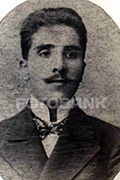
Hajibababeyov Mekhti
Hajibababeyov Mekhti bey was a public figure, politician and one of the active participants of the struggle for independence of Azerbaijan. After the fall of the Transcaucasian Seim and the Transcaucasian Democratic Federal Republic he became a member of the National Council of Azerbaijan (on May 26, 1918). On May 28, 1918 at the meeting of the National Council of Azerbaijan, which took place in Tbilisi, the Act of Independence of Azerbaijan was adopted. Hajibababeyov Mekhti bey was one of the 24 members of the National Council, who voted for adoption of this Act.
Hajibababeyov Mekhti bey finished the Baku non-classical secondary school. Since 1901 he worked as a teacher in the Baku Russian-Tatar School. He was one of the secretaries of the "Nijat" charitable society, and also the director of the first municipal Russian-Tatar School under the "Nijat" society. He also was a member of the Central Commission dealing with the elections of the Constituent Assembly. According to the law on formation of the Parliament of Azerbaijan (on November 19, 1918) Hajibababeyov was included into the structure of the Parliament of ADR. He also was a member of the “Musavat” fraction, and later, at the same time a member of the non-parties.
Hajibeyli Jeykhun
 Hajibeyli Jeykhun Abdoul-Huseyn oglu was the Azerbaijani publicist and the public figure. He was the younger brother of the outstanding Azerbaijani composer Uzeir Hajibeyli.
Hajibeyli Jeykhun Abdoul-Huseyn oglu was the Azerbaijani publicist and the public figure. He was the younger brother of the outstanding Azerbaijani composer Uzeir Hajibeyli.
Hajibeyli Jeykhun was born in the town of Shusha in 1891. Having finished the Russian-Tatar school in Shusha, he continued his study in Baku. With the assistance of the Maecenas Murtuza Mukhtarov Hajibeyli was sent to study law at the Petersburg University. Later, he left Petersburg for France, to enter the Sorbonn University in Paris. Since the beginning of the XX century Hajibeyli cooperates with the Baku press very actively. Besides publishing the articles in “Caspiy”, “Irshad” and “Taraggi” newspapers, he was occupied with editing of the Russian-language Baku "Azerbaijan" newspaper.
Due to close creative cooperation of Uzeir Hajibeyli with Jeykhun Hajibeyli, the first Azerbaijani opera "Leyli and Mejnun" was staged in Baku, in 1908.
In 1916, having graduated from the University, J. Hajibeyli returned to Baku, where he was occupied with editorial activity and wrote for the press with articles narrating about grievous condition of the people. His articles were published under the pen name "J. Dagestani".
When the Azerbaijan Democratic Republic was established, J. Hajibeyli was appointed to hold a post of the editor of the “Azerbaijan” newspaper, which was an official organs of the governmental press. In 1919, he was included into the Azerbaijani delegation (directed by Alimardan bey Topchubashov), which should participate in the Versailles peace conference, in Franse. After the Azerbaijan Democratic Republic’s fall in 1920, J. Hajibeyli didn't return to Azerbaijan and til the end of his life he lived in Paris, where he had enough opportunities for activity in promotion of history and culture of Azerbaijan. He translated an ample quantity of poems of the Azerbaijani poets like: Vidadi, Nabati, Kasumbey, Zakir and others into French. He was also an author of a number of articles written on various philological and literary subjects ("Hafiz Shirazi", "Life of Firdousi", "The Azerbaijani poetesses" and others). Living in France, J. Hajibeyli published the articles in some French magazines and newspapers; he took an active part in the foundation of the Azerbaijani edition of Radio "Freedom".
J. Hajibeyli is the author of many stories, scientific works and articles devoted to the Azerbaijani history, language and literature. The story "Morning of Haji Kerim", whose author was J. Hajibeyli, was published in the “Caspiy” newspaper. He also was an author of the researches "Babek and the Ancient State Arran", "The History of the Cities of Baku and Barda" and the articles devoted to the creativity of the Iranian poets A.Firdousi and Shiraz. One of the most valuable works of J.Hajibeyli was the research "Karabakh Dialect and Folklore", published in "The magazine of two worlds” in 1934, in Paris. The same magazine inserted his other two works: the "From the history of Azerbaijan. Abbasgulu Agha Bakikhanov" and the "Intellectual potential in the USSR". J.Hajibeyli’s special attention was drawn to the problems of liberation and equality of women, to their roles in public work and social struggle. The book named the "Anti-Islamic Promotion and Its Methods in Azerbaijan", which was a result of his researches, was published by the Institute for studying of the USSR in Munich, in 1959.
Jeykhun Hajibeyli died and was buried in Paris, in 1962.
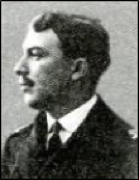 Hajinski Jamo
Hajinski Jamo
Hajinski Jamo bey Souleymane oglu was born in 1888 in Guba. He was a public figure and politician. When he was a child, together with his family he moved to Baku where he finished a gymnasium. There was a period of time when he worked as a “Caspiy” newspaper's correspondent. In 1907 he entered the faculty of law of the Petersburg’s University. Graduated from the university Hajinski in the 1915-1917th (during the World War I), worked as an authorized representative of the committee concerned with matters of Muslim refugees in Batumi, where he rendered a legal assistance to the victims. In April, 1917 he was appointed as a representative of Provisional government of Russia in the Special Transcaucasian Committee. In February, 1918 he became a member of the Transcaucasian Seim. He held a post of a public supervisor in the First Governmental Cabinet of Azerbaijan Democratic Republic, and at the same time he held a post of a Secretary of State Post and Telegraph in the Fourth and the Fifth Cabinets also. He was a member of socialist fraction in the ADR parliament. After a communistic regime’s establishment in Azerbaijan he worked in the National Commissariat of Justice. In 1922 he was arrested and condemned for 6 years. In 1938 he was arrested for the second time. He died in a forced labor camp in Vyatka, in 1942.
Hajinski Mammad Hasan
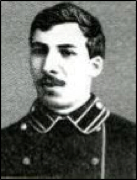 Hajinsinski Mammad Hasan Jafargulu oglu was born on March 3, 1875 in Baku. In 1902 he graduated from the Petersburg Technological University. There was a period of time when he worked as an engineer at Asadullayev's refinery, in Moscow. Coming back to Baku in 1908, he participated in construction works, in improvement of the main town planning (the author was Nikolaus von der Nonne). Hajinski also was an initiator and an inspirer of Baku Primorski Boulevard’s creation. In 1912, a book, about upgrading of Baku streets was edited by Hajinski. In 1913 he headed Baku municipal office. He also paid a special attention to the Palace of Shirvanshakhs, suggesting offers on protection of the palace and its restoration. Due to on Hajinski’s initiative, O. Abuyev and Ziver bey Ahmadbeyov carried out research work for the further restoration. In 1902-1917 he was a member of Baku municipal duma. He also was one of the founders of “Hummet” - a society of literacy propagation among Muslims "Neshr-Maarif". He was a member of "Nijat" Muslim educational society’s governance; he was included in the Central Committee of "Muslim charitable institution" and was one of the first members of “Musavat”. In 1917 he opened and participated in the Congress of the Caucasian Muslims which took place in Baku. In May of the same year he actively participated in the Moscow Congress of Muslims. On October 26-31, 1917 he became a member of the Central Committee Party at the first “Musavat” party’s congress.
Hajinsinski Mammad Hasan Jafargulu oglu was born on March 3, 1875 in Baku. In 1902 he graduated from the Petersburg Technological University. There was a period of time when he worked as an engineer at Asadullayev's refinery, in Moscow. Coming back to Baku in 1908, he participated in construction works, in improvement of the main town planning (the author was Nikolaus von der Nonne). Hajinski also was an initiator and an inspirer of Baku Primorski Boulevard’s creation. In 1912, a book, about upgrading of Baku streets was edited by Hajinski. In 1913 he headed Baku municipal office. He also paid a special attention to the Palace of Shirvanshakhs, suggesting offers on protection of the palace and its restoration. Due to on Hajinski’s initiative, O. Abuyev and Ziver bey Ahmadbeyov carried out research work for the further restoration. In 1902-1917 he was a member of Baku municipal duma. He also was one of the founders of “Hummet” - a society of literacy propagation among Muslims "Neshr-Maarif". He was a member of "Nijat" Muslim educational society’s governance; he was included in the Central Committee of "Muslim charitable institution" and was one of the first members of “Musavat”. In 1917 he opened and participated in the Congress of the Caucasian Muslims which took place in Baku. In May of the same year he actively participated in the Moscow Congress of Muslims. On October 26-31, 1917 he became a member of the Central Committee Party at the first “Musavat” party’s congress.
Hajinski worked as a deputy commissioner of the trade and the industry of the Transcaucasian commissariat. Being a member of “Musavat” party, he became a member of the Transcaucasian Seim. He also was a member of delegation which carried on negotiations with the Ottoman Empire. Hajinski held a post of the Minister of Foreign Affairs in the First Governmental Cabinet when Azerbaijan Democratic Republic was proclaimed. In the Second Governmental Cabinet he held a post of the Minister of Foreign Affairs (May 28 - December 7, 1918) at the source, but later he held a post of the Minister of Finance. In the Third Governmental Cabinet Hajinski held a post of a public supervisor, and in the Fifth Governmental Cabinet – the Minister of Internal Affairs at the source, and then the Minister of Trade, Industry and Food. Hajinski was a member of the Parliament of Azerbaijan. In April, 1920 Hajinski was committed by the parliament to set up the government. Hajinski carried on negotiations with parties. He offered Bolsheviks to allocate the portfolios, but Bolsheviks refused. On April 22 Hajinski reported to Mammad Yusif Jafarov, who was a temporary Speaker, that it was impossible to set up the government. On the same day Hajinski left “Musavat” and became a member of the Communist Party of Azerbaijan. When Bolsheviks came to power Hajinski worked at various economic positions, and was the vice-chairman of a planning commission of the Transcaucasian Soviet Socialist Federation.
On December 3, 1930 Mammad Hasan Hajinski was arrested by order of Beria. In prison he fell ill with tuberculosis. According to the evidences, Hajinski couldn’t endure tortures and commited a suicide on February 9, 1931.
Hajinski Mehdi
 Hajinski Mehdi bey Suleyman oglu – a theatrical and socio-political figure, an actor and a publicist.
Hajinski Mehdi bey Suleyman oglu – a theatrical and socio-political figure, an actor and a publicist.
Mehdi bey was born on May 24 in 1879 in Guba. He got courses of the Baku real school and was a student of east languages’ courses. Hajinski graduated from the Baku State University, where he studied philology and juridical science. In 1896 he took an active part in creation of the Baku Muslim troupe. He began his scenic activity as an actor of "The First Muslim troupe" in 1897. Since 1906 he worked in "The Second Muslim troupe", where he played the Governor of a town, Charles Moor and etc. He also was a member of the Baku Artistic and the Charitable and Educational Societies, which created theatrical troupes. Since 1906 he headed the theatrical department of the "Nijat" charitable society. Since 1914 he was the vice-chairman of the theatrical department of the "Saf" society. Since 1908 he acted as an actor.
It was Hajinski who presented Hacibeyov with the award for the opera "Leyli and Mejnun" on behalf of the "Nijat" society. Hajinski was very attentive towards Uzeir bey’s creative work. Due to this he was an author of many articles about Hacibeyov’s life and creativity. At the same time he actively participated in the organization of the Azerbaijani theaters. Hajinski was an author of the "Deposition of Sultan Aziz" tragedy. He also translated into the Azerbaijani language a number of plays, including the "Robbers" and the "Marriage". He was published in newspapers and magazines ("The Russian actor", "Stage", "Caspian Sea", "Hayat", "Igbal", "Irshad", "Zanbur" and "Mullah Nasreddin") with articles about the Azerbaijani theater and performing arts. Hajinski was the author of a number of sketches, stories and feuilletons.
Hajinski was also engaged in political activity. He was a member of the “Musavat” party and was elected to the structure of the Baku bureau’s party (1917). After the fall of the Transcaucasian Seim and the Transcaucasian Democratic Federal Republic he became a member of the National Council of Azerbaijan (on May 26, 1918). On May 28, 1918 at the meeting of the National Council of Azerbaijan, which took place in Tbilisi, the Act of independence of Azerbaijan was adopted. Hajinski was one of the 24 members of the National Council, who voted for adoption of this Act. According to the law on formation of the Parliament of Azerbaijan (November 19, 1918) Hajinski was included into the structure of the Parliament of ADR where he held a position of the secretary of Presidium.
During the period of the Soviet power Hajinski cooperated with the newspapers "Yeni Fikir" and "Yeni Kend" issued in Tbilisi, and also with the “Dan Ulduzu” magazine.
At the first congress of the judicial figures of the Azerbaijan Soviet Socialist Republic he was elected the member of the Presidium of Council of national judges. Later he was sent to the Nakhchivan Autonomous Republic for the organization of judicial authorities as an instructor. He was elected the member of the Supreme economic council of the Nakhchivan Autonomous Soviet Socialist Republic, and also the chairman of the committee on studying of the Nakhchivan Autonomous Republic. Hajinski was the member of an editorial board of the “National Economy of Azerbaijan”
magazine under the Council of the National Economy of Azerbaijan.
Hajinski Mehdi bey died in June in 1941.
Hasanov Aliagha
 Hasanov Aliagha Haji Suleyman oglu – was a public figure and a statesman.
Hasanov Aliagha Haji Suleyman oglu – was a public figure and a statesman.
Aliagha was born in 1871 in Baku. He finished the Baku Gymnasium and the Commercial School. Being a merchant, he took part in the organization and of “Nashri-maarif” society. He also was a member of the municipal duma. Aliagha Hasanov had big merits in carrying out “shollar” water in Baku, in creation of a city drainage system and in laying Seaside Park. Hasanov was an active participant of events after February revolution of 1917. During the March slaughter of 1918 made by Armenians in Baku, he was a member of Temporary executive committee of Muslim national council. According to the law on formation of Parliament of Azerbaijan (on November 19, 1918), Hasanov Aliagha was included into the structure of ADR’s Parliament as a non-party one.
In the Third Governmental Cabinet of ADR Aliagha Hasanov held a post of the Deputy Minister of Finance, and in the Fourth Cabinet – the post of Minister of Finance. Under his management the Azerbaijani state bank on September 30, 1919 was founded. Aliagha Hasanov also promoted the acceptance of very important (from the point of view of formation of a national financial system) the governmental resolution of November 8, 1919. According to this resolution, both for exchange, and for payments in the state cash desks of all departments of the republic, now could be used only bank notes of ADR and also bank notes issued by former authorities (the Baku city government, the Council of municipal economy and the Transcaucasian commissariat). Thereby in the territory of Azerbaijan, the circulation of the Russian rubles, which have been used under the tsarist regime, and later in the time of Provisional Government was stopped.
Aliagha Hasanov sincerely worried about how hard inflation was reflected on people’s life, but he had to proceed from the government’s resources. The remarkable fact testifying a social orientation of liberalism professed by Aliagha Hasanov is that, in August, 1919, “for protection of national savings from an abnormal expenditure and fighting against luxury”, he suggested to impose consumers of luxury goods in favor of fisk by an indirect tax. The bill prepared by him about introduction of a special temporary customs tariff on luxury goods imported from abroad was approved by the Council of Ministers on August 16, 1919.
Aliagha Hasanov carried on a private correspondence with Lev Nikolayevich Tolstoy and translated his “To God or Mammon?” into the Arabic language.
After the accession to power of Red Army, Aliagha Hasanov’s family (he, his wife and nine children, 5 daughters and 4 sons) lived under the continuous control, though Aliagha Hasanov continued to work in the State bank as the deputy director.
Gradually all houses of the Hasanovs’ brothers (Aliagha and Hasanagha) were taken away. There was only the last house, in the fortress (the Big Serfdom 20) where the family of Aliagha lived all life.
In 1933 Aliagha Hasanov caught typhus from his son Zyaka, who was a talented chemist.
Both of them died in the same day, on March 18 in 1933.
Jafarov Mammad-Yusif
 Mammad-Yusif Jafarov was born on March 14, 1885, in Baku. In 1907 he finished Baku Aleksandrovski gymnasium, and then he entered the Moscow State University where he studied law. During his studies Jafarov communicated with Azerbaijanian students and actively participated in all arrangements and events. In 1912 he graduated from the Moscow State University with honors and returned to Baku where worked as an assistant of the juryman. Later, when he already deserved respect of Baku, and the population of Elisabethpol and Irevan, Mammad-Yusif Jafarov became a deputy of the Fourth State Duma. He was the only Muslim deputy from the South Caucasus. He was a member of the Muslim fraction and a member of the Cadets’ fraction.
Mammad-Yusif Jafarov was born on March 14, 1885, in Baku. In 1907 he finished Baku Aleksandrovski gymnasium, and then he entered the Moscow State University where he studied law. During his studies Jafarov communicated with Azerbaijanian students and actively participated in all arrangements and events. In 1912 he graduated from the Moscow State University with honors and returned to Baku where worked as an assistant of the juryman. Later, when he already deserved respect of Baku, and the population of Elisabethpol and Irevan, Mammad-Yusif Jafarov became a deputy of the Fourth State Duma. He was the only Muslim deputy from the South Caucasus. He was a member of the Muslim fraction and a member of the Cadets’ fraction.
In the Special Transcaucasian Committee Jafarov directed the industry and trade. On November 15, 1917 Jafarov became the Commissioner of Industry and Trade of the Transcaucasian Commissariat. He also was a member of the Muslim fraction in the Transcaucasian Seim. On May 27, 1918, at the extraordinary congress of the Muslim fraction the Temporary National Council under the direction of Mammad Amin Rasulzade was founded and Mammad-Yusif Jafarov was elected into that executive committee.
The Declaration of Independence of the Azerbaijan Democratic Republic was signed next day. Mammad-Yusif Jafarov was also one of the people who signed the declaration. Jafarov held a post of the Minister of Trade and Industry in the First Governmental Cabinet. After resignation of the First Governmental Cabinet, Mammad-Yusif Jafarov became the ambassador of ADR in Georgia, where he played a big role in creation of diplomatic relations between ADR and GDR and in sharing of the Transcaucasian Democratic Federative Republic’s property.
On March 14, 1919 the chairman of Council of Ministers of ADR Nasib-bey Usubbeyov formed the Fourth Governmental Cabinet and Jafarov was appointed to a position of the Minister of Foreign Affairs. Having become the head of foreign office of Azerbaijan, Mammad-Yusif signed the contract on military cooperation with Georgia, and sent notes to headquarters of armed forces of Great Britain in the South Caucasus. According to his instruction the commission for a collecting documents, concerning tsarism policy in the South Caucasus was founded.
On February 2, 1920 according to Rasulzade’s offer, Jafarov became the senior comrade (the first deputy) of the chairman of the ADR parliament. He worked at this position till Azerbaijan was annexed to the Soviet Russia. On April 27 after intense discussions Jafarov signed the decision on transfer of power to the Interim Revolutionary Committee of Azerbaijan. After the ADR’s fall Jafarov was engaged in legal consultation of cotton and wine trusts.
He died on May 15, 1938, in Baku.
Javanshir Behbud Khan
 Javanshir Behbud Khan was a great-grandson of Panakhali Khan - the founder of the Karabakh khanate, and a son of Azad Khan. He was born in 1877, in Azad Garagoyunlu village of Tartar district. In 1890 he entered school with the German language bias in Tbilisi, where he got a secondary education. Then Javanshir Behbud Khan continued his study in Germany, at Frayberg’s mining academy which was the first-ever technical college. So, Behbud Khan was the first Azerbaijanian who graduated from that academy. Behbud Khan Dzhavanshir had a good command of foreign languages, such as German, English, French, Russian, Georgian and Armenian.
Javanshir Behbud Khan was a great-grandson of Panakhali Khan - the founder of the Karabakh khanate, and a son of Azad Khan. He was born in 1877, in Azad Garagoyunlu village of Tartar district. In 1890 he entered school with the German language bias in Tbilisi, where he got a secondary education. Then Javanshir Behbud Khan continued his study in Germany, at Frayberg’s mining academy which was the first-ever technical college. So, Behbud Khan was the first Azerbaijanian who graduated from that academy. Behbud Khan Dzhavanshir had a good command of foreign languages, such as German, English, French, Russian, Georgian and Armenian.
Behbud Khan Javanshir was a member of the central committee of “Difai” party, which was set up secretly by Ahmed bey Aghayev in 1905.
Later on, February revolution of 1917 he was elected into structure of the Interim Executive Committee of the National Muslim Council.
During the period of the ADR rule Behbud Khan Javanshir held a post of the Minister of Internal Affairs in the Second Governmental Cabinet, which was set up by Fatali Khan Khoyski on June 17, 1918 in Ganja.
Since October 6, 1918 and till the end of the same year Behbud Khan Javanshir also headed the Ministry of Trade and Industry. He resigned his post after resignation of the cabinet of Fatali Khan Khoyski, in December.
Behbud Khan Javanshir was a member of the ADR parliament.
Later on, April events of 1927, according to Nariman Narimanov’s recommendation Behbud Khan Javanshir worked in the sphere of oil industry. At the end of the same year he was sent to Germany for purchase of the modern oil industry equipment.
Being in Istanbul, Behbud Khan Javanshir stayed at Ahmed bey Aghayev’s house. Ahmed bey Aghayev was in exile on the island of Malta at that time. Behbud Khan Javanshir travelled together with his spouse Tamara Javanshir, with brothers Surkhay Khan and Jamsheed Khan. Most probably, he was going to say goodbye to his Homeland.
On June 18, 1921 approximately at 23 o'clock Behbud Khan Javanshir was killed by three shots in front of the “Pera-Palas” hotel. He was murdered by a member of “Dashnaktsutyun” party – Misak Torlakyan, who was a former soldier of Armenian army. Misak Torlakyan was on-the-spot arrested, but in spite of being under investigation he managed to run away somehow.
Kaplanov Rashid khan
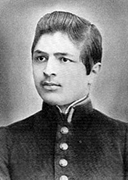 Kaplanov Rashid khan Zavid oglu — the Kumyk prince, the Minister of Internal Affairs of the Mountain Republic (1918-1919), the Minister of National Education and Denomination Affairs (1919) and Trade, the Minister of Industry and Food of the Azerbaijan Democratic Republic (1919-1920).
Kaplanov Rashid khan Zavid oglu — the Kumyk prince, the Minister of Internal Affairs of the Mountain Republic (1918-1919), the Minister of National Education and Denomination Affairs (1919) and Trade, the Minister of Industry and Food of the Azerbaijan Democratic Republic (1919-1920).
Kaplanov Rashid khan Zavid oglu was born in 1883, in the Aksay settlement, in the Kumyk princely family. He graduated from the Sorbonne’s law faculty, in Paris. In 1910-1913 taught at the Istanbul University, taught state law at school on Civil Cases (Mektebi-Mulkiyye) and taught a constitutional law at school of Political Sciences. During that period he published a lot in the Russian newspapers of Turkey named "Istanbul news" and “Tenin”. He took part in activities of the reforms’ commission in legislative system of Turkey’s Ministry of Justice. He established a personal relations with members of the Triumvirate rulling the empire — Enver pasha, Talaat pasa and Jamal pasha.
In 1913 Kaplanov returned to Russia, lived in Vladikavkaz and till 1917 served as an assistant to the juryman.
In 1917-1918 he was an active participant of political events in the North Caucasus.
In May, 1917 he was elected the vice-chairman of the Central Committee of the Union of Mountaineers at the 1st congress of the Union of the Integrated Mountaineers of the North Caucasus and Dagestan (The Union of Mountaineers of the Caucasus).
Since December, 1917 he worked at the post of the Minister of Internal Affairs and at the same time acting chairman of the Board of Ministers of the Mountain government.
He also was one of the organizers of the Tersk-Dagestan’s government (set up on December 1(14), 1917, in Vladikavkaz at the meeting of the representatives of the Central Committee of the Union of the integrated mountaineers of the Caucasus, the Army government of the Tersk’s Cossacks, the Union of the cities of the Tersk-Dagestan’s territory) - the chairman of the Board of the Government, the President of External Relations.
Later he became the Minister of Internal Affairs in the 2nd Mountain government (November 1918 - March 1919).
In the spring 1919, Dagestan was occupied by Denikin's armies, after what Kaplanov resigned and by the invitation of the ADR’s management moved to Baku, where he joined the “Ekhrar” party and along with A.Efenddi-zade and A.Gardashov became one of its leaders.
Since April, 1919 he held a post of the Minister of National Education and Denomination Affairs in the Fourth Governmental Cabinet of the ADR, headed by N. Usubbeyov. He also participated in creation of the Baku University.
Since December 1919 till April 1920 he was the Minister of Finance in the Fifth Governmental Cabinet of the ADR.
In 1920, after the ADR’s fall, twice in Baku, then in Temir-Khan-Shur (since 1922 - Buinaksk), he was arrested by the All-Russian Extraordinary Commission bodies, which brought the case before the Special Investigative department of the 11th Red Army. Due to the intercession of D. Korkmasov, V. Naneyshvili (the old Bolshevik and a member of an underground, he was shot in 1940) and N. Narimanov, Kaplanov was released with the permission of countrywide residence, except the Caucasus.
Since 1920 Kaplanov lived in Moscow and worked in the National Commissariat of Public Education of the RSFSR (Russian Soviet Federative Socialist Republic). He also gave a course of lectures on history of Turkey at the Moscow Institute of Oriental Studies (the Institute existed from 1920 to 1954). He worked as a jurisconsult under the permanent representation of the plenipotentiary “Uzbektorg” and the corporate enterprise "Turk. Silk".
In 1930 he was arrested by bodies of the United State Political Administration. In accordance with the resolution of the general meeting of the USPA the case was dismissed in the absence of compromising materials.
Since 1931 Kaplanov cooperated with the All-Union Central Committee of the NA (New Alphabet) of the USSR on legal questions (till 1931 this committee was named the All-Union Central Committee of the New Turkic Alphabet).
On October 8, 1937, R. Kaplanov was arrested for the fourth time. He was first kept in the “Butirsk” prison, and then in the “Lefortov” prison.
On December 10, 1937 he was sentenced to the extreme penalty for the active participation in the counterrevolutionary movement and the anti-Soviet nationalist terrorist organization. He was executed by shooting on the same day.
The burial place was the Communard of the Moscow Region.
He was rehabilitated by the Public Procurator's office of the USSR on April 29, 1991.
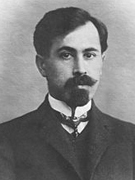 Khasmammadov Khalil bey
Khasmammadov Khalil bey
Khasmammadov Khalil bey Hajibaba oglu was born in 1873 in Ganja (Elizabethpol). He was a public figure and politician. He finished the Elisabethpol’s classical gymnasium. In 1895 he graduated from the Moscow University where he studied law. Later he worked in district courts of Ekaterinodar and Elisabethpol. Khasmammadov Khalil bey was a deputy of the II (the Second) and the III (the Third) State Duma from Elisabethpol’s province. In the 1913-1918th he was the head of Elisabethpol’s municipality and the head of executive committee of the Elisabethpol’s district.
Later on February revolution of 1917 he became a commissioner of control in the Transcaucasian Commissariat, and also the member of the Transcaucasian Seim. In May, 1918 he was in an executive committee of the National Council of Azerbaijan.
Khasmammadov Khalil bey worked in all five government institutions of ADR and held post of Ministers of Justice, Communication Lines, Internal Affairs and Justice again. He also was a member of the parliament of Azerbaijan. In April, 1920 Khasmammadov Khalil bey was appointed an ambassador of the Azerbaijan Democratic Republic in Turkey. Due to the fall of the Azerbaijan Democratic Republic and the establishment of communistic regime in Azerbaijan, he lived in emigration. He was buried in the "Feridkyoy" cemetery in Istanbul.
Khoyski Fatali Khan
 Khoyski Fatali Khan Isgender oglu was born on November 25, 1875 in the town of Shaki of the Elisabethpol’s province. His great-grandfather Jafargulu Khan was Khoy's governor in the Southern Azerbaijan, and grandfather Ismail Khan, being the Khan of Shaki in the 1807-10th also was a lieutenant general of the Russian army. Fatali Khan got a good education. He finished a classical gymnasium in Elisabethpol (Ganja) and then entered the Moscow University, where he studied law. He graduated from the university in 1897.
Khoyski Fatali Khan Isgender oglu was born on November 25, 1875 in the town of Shaki of the Elisabethpol’s province. His great-grandfather Jafargulu Khan was Khoy's governor in the Southern Azerbaijan, and grandfather Ismail Khan, being the Khan of Shaki in the 1807-10th also was a lieutenant general of the Russian army. Fatali Khan got a good education. He finished a classical gymnasium in Elisabethpol (Ganja) and then entered the Moscow University, where he studied law. He graduated from the university in 1897.
His official activity began in the Judicial Court of Tbilisi. In 1899 he is appointed the senior judicial official, and a bit later – the director of Ozurget’s district of investigation. In 1900 of Fatali Khan was appointed the assistant of Zugdidy’s world court.
In 1903 he already was a manager of the Third Ekaterinodar’s (nowadays - Krasnodar) local judicial district. In 1904 was his promotion on the "Tables of ranks". So he became a collegiate asessor, what corresponded to a military rank of the captain.
In 1907 he stood fot the deputy of the Second State Duma of Russia from the Elisabethpol’s province and succeeded.
In February, 1907 he together with four other Azerbaijanians became a deputy.
Being a deputy of the Second State Duma, and a member of the Muslim fraction, Khoyski opposed resettlement policy of the government. He also adjoined party of cadets.
After dissolution of the Duma by Nikolay II Fatali khan returned home and started working again by the former profession.
On July 21, 1907 Fatali Khan is employed as a juror of Elisabethpol’s district court.
The district court in Baku where he moved in 1913 became the following instance of his official activity.
His public activity during that period was limited to participation in work of a number of the charitable organizations.
Later on February revolution of 1917 he was a participant of the 1st congress of Muslims of the Caucasus (April, 1917, Baku); a member of Executive committee of the All-Russian Muslim Council elected at the 1st All-Russian Muslim congress in Moscow (May, 1917).
Being a non-party, he took part in the 1st congress of Turkic Democratic Party "Musavat" ("Equality") (on October 26-31, 1917).
He supported the demands advanced by the party about granting of a wide autonomy to Azerbaijan as a part of federativly arranged democratic Russia.
He headed the Baku City Council during the period of October 1917 – April, 1918).
During the period of November 15, 1917 – February 10, 1918 he worked at a position of a commissioner of national education under the Transcaucasian commissariat. During the period of February 10 – May 26, 1918 he was a member of the Transcaucasian Seim, and at the same time a member of the “Musavat” fraction and democratic group of non-parties.
Since April, 1918 Fatali Khan held a post of the Minister of Justice of the Transcaucasian government. During the period of May 27 – December 7, 1918 he was a member of the Temporary National Council of Azerbaijan.
Since May 27 Fatali Khan was a chairman of Executive Committee of the National Council. On May 28 he set up the first government of the Azerbaijan Democratic Republic.
On May 28, 1918 at the meeting of the National Council of Azerbaijan which held in Tbilisi, the Act of independence of Azerbaijan was adopted. Fatali Khan Khoyski was one of the 24 members of the National Council who voted for adoption of this Act.
September 15, 1918 the Caucasian Islamic army consisting of the Turkish and Azerbaijani parts, entered Baku, and on September 17 the government of the Azerbaijan Democratic Republic moved to the city, and this city was declared a capital.
Since May 26, 1918 Fatali Khan became a chairman of the Council of Ministers. At the same time he held a post of the Minister of Internal Affairs (May 28 – June 17, 1918) and the Minister of Foreign Affairs (December 26, 1918 – March 14, 1919).
After Fatali Khan’s report on November 9, 1918 the government approved three-colored national flag of the Republic.
On December 7, 1918 the official opening of the first session of the Azerbaijan Democratic Republic’s parliament took place.
The Prime Minister F.Khoyski made a comprehensive report on the work done in the most difficult historical conditions, and then addressed to the deputies with a request to accept the cabinet's resignation. The parliament accepted the resignation and Fatali Khan was assigned a mission to form the Third government of the republic too.
On December 26 F.Khoyski made a speech in the parliament about the governmental program and structure of a new Cabinet. And this time F.Khoyski held in the government two posts - the Prime Minister and the Minister of Foreign Affairs.
Already, from the very beginning some party fractions in the parliament were in the scathing opposition to Fatali Khan's government. They accused the government of inactivity, tried to produce all lawlessness and anarchy in the country as a result of passivity of the authorities.
In connection with the current situation Fatali Khan Khoyski sent a letter to the parlaiment corresponding the government’s resignation, and this letter was announced at the meeting on February 25, 1919.
Having accepted the resignation, the parliament asked F.Khoyski’s Cabinet to execute their duties till the new government’s formation.
In April, 1919 the Fourth Governmental Cabinet led by N. Usubbeyov was set up. Fatali Khan wasn’t originally in that structure. In December, 1919 Khoyski held a post of the Minister of Foreign Affairs (on December 24, 1919 – on March 30, 1920).
During the period of December 7, 1918 – April 27, 1920 he was a member of the Azerbaijani Parliament.
During the period of April 25 – May 30, 1919, he was a member of the Azerbaijani delegation at the 1st conference of the Transcaucasian republics’ representatives in Tbilisi.
After the ADR’s fall and the Soviet power’s establishment in Azerbaijan (on April 28, 1920) he moved to Tbilisi where on June 19, 1920 he was killed.
Fatali Khan Khoyski became the first victim in the list consisting of the 41 people, approved at the 9th congress of "Dashnaktsutyun" (Yerevan, October, 1919) and designated, from the point of view of "Dashnaktsutyun", the main culprits, responsible for murder of Armenians in Baku in September, 1918 who were destined to destruction within the so-called operation "Nemezis" (by name of the Greek goddess of a revenge of Nemesis).
Fatali Khan Khoyski was shot by Aram Erkanyan while walking on the Golovinski Avenue in Tbilisi together with former acting chairman of the ADR’s Parliament Hasan bey Aghayev.
Khoyski died on the place of the incident. Aghayev died in the hospital.
K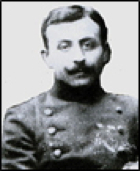 hoyski Rustam khan
hoyski Rustam khan
Khoyski Rustam khan Isgender oglu – was one of the National-Liberation Movement’s active members. He was a son of the lieutenant-general Isgender khan Khoyski and a younger brother of Fatali khan Khoyski. He worked in law-enforcement authorities till 1918. During the period of Azerbaijan Democratic Republic Rustam khan held a post of the chief of the executive office in the First and the Second Governmental Cabinets. Later he became a Minister of State Charity. After the Soviet Power’s establishment in Azerbaijan Rustam khan Khoyski held a post of the secretary of the Azerbaijan Soviet Socialist Republic’s Presidium of the Supreme Economic Council; also he held a post of the lawyer on cooperative rights questions, and etc. Subsequently he moved to Moscow where he died. He was buried at the Novodevichy Cemetery.
Kic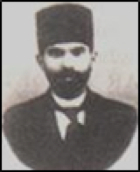 hikkhanli Bayram
hikkhanli Bayram
Kichikkhanli (Kichikkhanov) Bayram Niyazi (1889-1922) was born in Faldar village of Zagatala. He was a participant of freedom movement of Azerbaijan. Kichikkhanli graduated from Orenburg seminary. He began his work activities, and then joined to revolutionary movement in Baku. According to the “Law on establishment of parliament of Azerbaijan” of Azerbaijan National Council, he was elected to the parliament of ADR from Zagatala region. He was a member of “Ahrar” faction in parliament. Being elected to parliamentary secretary, Kichikkhanli was included in presidium as well.
Klen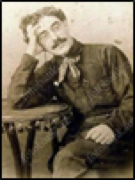 evski Victor
evski Victor
Klenevski Victor Viktorovich (? - ? ) was a Member of the ADR Parliament. According to the law on formation of the Parliament of Azerbaijan (on November 19, 1918) he was included into the structure of the ADR’s Parliament from Slavic-and-Russian society. Klenevski was a member of "Slavic-and-Russian society" fraction. He held a post of the Minister of Charity in the Fourth Governmental Cabinet of the ADR.
Kocharli Firidun bey
 Kocharli Firidun bey Ahmed-bey oglu — was the Azerbaijani philologist, a writer and a critic.
Kocharli Firidun bey Ahmed-bey oglu — was the Azerbaijani philologist, a writer and a critic.
Firidun bey Kocharli was born on January 26, in 1863 in Shusha. He was the only child in a family. He finished local Russian-Muslim school, and then entered the Transcaucasian teacher's seminary in Gori (Georgia). He got diploma in 1885, and started his teaching activity as a teacher of theology and the Azerbaijani language at Yerevan Russian-Muslim School. Later he organized spectacular according to Mirza Fatali Akhundzade's comedy "Monsieur Jordan and the Dervish of Mastali Shah" in Erevan, which became a big cultural event in city life. In 1896 he was invited to work at teacher's seminary in Gori, where he worked till 1918. In 1910 he was appointed to the position of a temporary instructor of the Azerbaijani department of the same seminary.
Kocharli was one of the first Azerbaijani scientists who have brought up a question of standardization of the literary Azerbaijani language.
In 1895 his first article - "The Tatar comedies" was published, and another one - "Letters about our literature" was published in 1904. In 1903 was published his first scientific work - "The Literature of the Azerbaijani Tatars". Subsequent period’s published works were: "Mirza Fatali Akhundov" (1911) and "A Gift to the children" (1912). Along with this, Kocharli occupied himself with translations of Russian (Pushkin, Lermontov, Chekhov, Koltsov) and the European authors’ works into the Azerbaijani language. He was an author of some brilliant articles covering the creativity of N. Gogol, L.Tolstoy and A.Chekhov. The profound knowledge of compatriots’ creativity was noted in his numerous publications about 130 works of the Azerbaijani writers and poets, which were not generalized into a single whole, consecutive scientific research before that.
Much work has been done by Kocharli in revision of the first part of the "Native language" book. He made about 300 amendments to the textbook, added some theoretical materials, stories, changed and enriched methodology and stylistics. His work "Millet and Wheat" was icluded into the "Native language" book. His treatise which was published only in 1925 was entitled "Materials of Azerbaijani literature’s history". The author was describing Shusha, having called her the Transcaucasian Shiraz.
In 1918-1920th Kocharli worked at a position of the chief of the Gazakh Teacher's Seminary, opened on his initiative under the Gori Seminary.
In 1917 Kocharli became a participant of political processes, and joined “Musavat” party. On May 28, 1918 he was elected a member of the National Council of Azerbaijan. On May 28, 1918 at the meeting of the National Council of Azerbaijan, which was hold in Tbilisi, the Act of independence of Azerbaijan was adopted. Firidun bey Kocharli was one of the 24 members of the National Council who voted for adoption of this Act.
On February 1, 1919 he was elected the chairman of the Gazakh department of “Musavat” party.
During the transition period to the Soviet regime, which caused a political and public turmoil, in May, 1920 Kocharli was arrested and sent to Ganja, where he was executed with no investigation or trial by special department of the XIth Red army. He was at the age of 58 years. Later on, Nariman Narimanov who valued Kocharli’s services highly, ordered to find and to punish a committer of the crime.
Firidun bey died in 1920 in Ganja.
L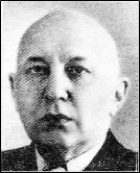 emberanski Jamil bey
emberanski Jamil bey
Lemberanski Jamil bey Nesir bey oglu was born in 1884 in Lemberan village of Barda district. He was a member of the Parliament of the Azerbaijan Democratic Republic. In 1913 he graduated from the medicine faculty of the Kiev University and until 1920 he worked in the Terter hospital which was founded by him. He participated in Batumi conference in 1918. According to the law of the National Council of Azerbaijan “On establishment of the Azerbaijan Parliament” he was elected a member of the Parliament of Azerbaijan Democratic Republic and represented Ittihad faction in the parliament. After the April occupation Lemberanski headed the therapy department of People’s Health Commissariat, worked as a head doctor of the first surgery hospital, chief of traumatology department of the oil-field district (Sabunchu, Black city) hospitals, the head surgeon of the garrison hospital during the 2nd World War and the consultant of the evacuation hospitals of Health Commissariat. He defended the Candidate's dissertation in 1949 and headed the orthopaedics and traumatology department of Azerbaijan Advanced Training Institute for Doctors. Lemberanski was awarded a title of honorary doctor of Azerbaijan in 1957.
He died in 1959, in Baku, Azerbaijan.
Lizgar Konstantin
Lizgar Konstantin Nikolaevich – was the Minister of Food in the Third Governmental Cabinet of the ADR.
Konstantin was born in 1882. Till 1914 he was an owner of some shops in Baku and Vladikavkaz. In 1914 he was called up for military service in a rank of the ensign. He served in the 499th field hospital, of the Tbilisi automobile detachment, in Turkestan. In the Select Transcaucasian Committee Lizgar held a post of the clerk of the communication lines’ commission, and in the commissariat of the communication lines – the officer pro hac vice. In March, 1918 he was one of the founders and the chairman of the "Slavic-and-Russian society". In October of the same year, by the invitation of the Minister of Agriculture of the ADR – Khosrov Pasha bey Sultanov, Lizgar came to Baku. In the Ministry of Agriculture he held a post of the officer pro hac vice. In the Third Governmental Cabinet of the ADR he held a post of the Minister of Food. On May 2, 1920 Konstantin Lizgar was arrested by the Special Department of the Revolutionary Council of the 11th Red army. On May 15, Lizgar Konstantin Nikolaevich was executed by shooting for the counterrevolutionary activity and the hostile attitude to the Soviet Power.
Mahammadbeyov Gazi Ahmad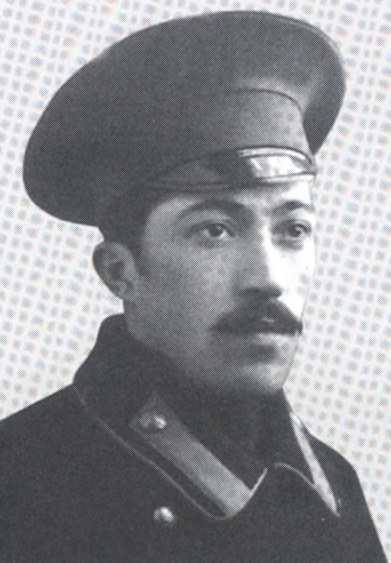
Mahammadbeyov Gazi Ahmad was one of the active participants of the struggle for national independence in Azerbaijan and member of the Parliament of Azerbaijan Democratic Republic. He was a member of the Muslim faction of Transcaucasian Seym and after the fall of the Transcaucasian federation (May 26, 1918), he became a member of the National Council of Azerbaijan (May 27, 1918). According to the law on the formation of Azerbaijan Parliament (November 19, 1918) of the National Council he was entered to the membership of the Parliament without election. Earlier he was a member of “Musavat” party, and then joined to “Ittihad” party. He was deputy chairman of “Ittihad” party.
Mahammadbeyov was grandson of Gazi Mahammad who headed the Samur-Akhti rebel against the Russian Empire during Russian-Ottoman war in 1877-78 years and according to some sources, great-grandson of Sheykh Shamil. He was a practicing lawyer. Mahammadbeyov was an editor (after doctor G. Garabeyli) of “Ittihad” newspaper published in Russian from June, 1919. He represented “Ittihad” faction in parliament.
M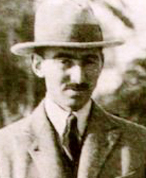 aharramov Mahammad
aharramov Mahammad
Maharramov Mahammad was born in 1886, in Gamarli village of Irevan province. He was a participant of Azerbaijan freedom movement. On graduating Irevan gymnasium, he entered to medicine department of Moscow University in 1914. After the February revolution he returned to Tiflis leaving his education unfinished and joined to “Hummat” social-democratic organization there. He was elected to Transcaucasian Seym from Muslim Socialist Bloc. M. Maharramov is one of 26 members of Azerbaijan National Council who signed the Declaration of Independence. According to the “Law on establishment of parliament of Azerbaijan” of Azerbaijan National Council, he was elected to the parliament of ADR. He was a member of Azerbaijani delegation attending the Paris Peace Conference. After the April occupation in 1920, he stayed in France and graduated from the department of economics in Sorbonne University. Since 1927, he worked at the bank. Later, he opened a second-hand bookseller. Losing all hope for returning to homeland after the Second World War, Mahammad Maharramov acquired French citizenship in 1948. In 1972 and 1975, he visited Baku and donated valuable documents related to the culture of Azerbaijan to museums and libraries of the city.
He died in 1982, in Paris.
Mahmudbeyov Alesker bey
Mahmudbeyov Alesker bey – the Member of National Council of Azerbaijan.
Mahmudbeyov Alesker bey got a secondary education in the Baku real school, and then graduated from the State Petersburg Polytechnical Institute. After graduation he worked at Haji Zeynalabdin Tagiyev’s weaving mill. In 1908 he moved to Tiflis, where he was engaged in public work. Mahmudbeyov took active part in a work of the Caucasian Muslim charitable society. Alesker bey Mahmudbeyov was one of those who voted for adoption of the Act of Independence of Azerbaijan. In 1918 he moved to Turkey where he directed the weaving mill in the city of Adana. Subsequently, he moved to Cairo where he lived until the end of his life.
Mahmudbeyov died in 1968, in Cairo.
Makhmudov Mustafa
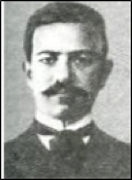 Makhmudov Mustafa Haji Musa oglu – was a member of the Parliament of ADR.
Makhmudov Mustafa Haji Musa oglu – was a member of the Parliament of ADR.
Makhmudov was born in 1878, in the village Kyurdemir of the Gyoychay district. Makhmudov Mustafa graduated from the Gori teacher's seminary. After being educated he started to work as a teacher (1899-1907), and then a manager of the first "Russian-Muslim" school (1910-1920). He also worked at the post of the official of the commission dealing with the assessment of the city immovable property (1908-1910). In 1907 he was voted into the Second State Duma from the Baku province, where he became a member of the Muslim fraction, a member of the 9th department and the four commissions at the same time. Together with Fatali Khan Khoyski and Khalil bey Khasmammadov Mustafa Makhmudov addressed to the Minister of War with the petition for commutation, given by the Caucasian court-martial to the sentenced to death prisoners.
After the fall of the Transcaucasian Seim (1917) and the Transcaucasian Democratic Federal Republic (on May 26, 1918) Mustafa Makhmudov became a member of the National Council of Azerbaijan (on May 26, 1918). On May 28, 1918 at the meeting of the National Council of Azerbaijan, which took place in Tbilisi, the Act of Independence of Azerbaijan was adopted. Mustafa Makhmudov was one of the 24 members of the National Council, who voted for adoption of this Act. According to the law on formation of the Parliament of Azerbaijan (on November 19, 1918) he was included into a structure of the ADR’s Parliament. Being in the Parliament he was a member of the “Musavat” fraction and a member of the agrarian commission of the Parliament.
After the seizure of power by Bolsheviks in 1920 he taught at the Baku school No. 132. Mustafa Makhmudov was persecuted for political reasons. He was prosecuted for nationalism and counterrevolutionary activity. On December 20, 1937 he was arrested and shot.
Makinski Teymur Khan
Teymur Khan Makinski was born in Irevan, in 1874. Being descendants of the Maku Khans, who had lived in Irevan, the family of Makinski was the close relative to the Irevanski family - the successors of the family of Irevan Khans. Teymur Khan Makinski was one of the founders of the Azerbaijan Democratic Republic. He finished the Irevan gymnasium and in 1916, with the diploma of the first degree graduated from the law department of the Warsaw University.
Teymur Khan Makinski was one of the active participants of the National Liberation Movement, which has begun in Azerbaijan at the beginning of the XX century. Being a political figure, Teymur Khan Makinski was a member of Muslim fraction of the Transcaucasian Seim, and after disintegration of the Transcaucasian Federation became a member of the National Council of Azerbaijan.
According to the law on formation of Parliament of Azerbaijan (on November 19, 1918), Makinski was included into the structure of ADR’s Parliament. T.Makinski (June-October, 1918) worked as the Deputy Minister of Justice of the Azerbaijani government, and since October 20th until the end of December was the diplomatic representative of the Azerbaijan Democratic Republic at the Armenian government. He was elected the chairman of the board of an association of Muslims of Irevan province, which had been founded in January, 1919, in Baku for the purpose of protection of Azerbaijanis, living in Irevan province against the Armenian tyranny.
From December 26, 1918 to March 14, 1919 Teymur Khan Makinski held a post of the Minister of Justice in the Third Governmental Cabinet of Fatali Khan Khoyski. Since June 1919 till January (March), 1920 T.Makinski was the chairman of the Court-martial of Azerbaijan Republic. And since March, 1920 he was appointed, again to the position of the diplomatic representative of the Azerbaijan Democratic Republic at the Armenian government.
After the fall of the Azerbaijan Democratic Republic on May 15, 1920 the Armenian government stopped the activity of diplomatic mission of Azerbaijan Republic in Irevan. Armenian public procurator’s office complained of T.Makinski for the reason that he, being the head of the diplomatic mission, rendered financial support to the compatriots living in Zangibasara. However, with assistance of Georgian permanent representation in Irevan, he managed to leave secretly Irevan and on May 28 arrived to Tiflis.
Unfortunately, there is no authentic news about the further destiny of Teymur bey Makinski.
Abbasali bey Makinski (the cousin of Teymur bey Makinski) graduated from the law department of the State Petersburg University in 1908. He worked in the permanent representation of Azerbaijan in Irevan. Due to his knowledge of the Russian, English, French and German languages he always protected the rights of Azerbaijanis at diplomatic negotiations. Abbasali bey Makinski was also one of the activists of the Arazo-Turkic government, established in Nakhchivan, in the fall of 1918.
Malik-Aslanov Khudadat bey
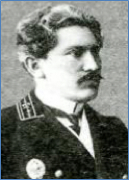 Malik-Aslanov Khudadat bey Agha oglu was born in Shusha, in 1879. He was a scientist, state and political figure. In 1899 he finished the Shusha real school, and later, in 1904 - the Petersburg Institute of Engineers of Road Transport. During his study in Petersburg, in 1901, he joined RSDRP (Russian Social Democratic Labour Party), but in 1904 left the party and remained the non-party till the end of his life.
Malik-Aslanov Khudadat bey Agha oglu was born in Shusha, in 1879. He was a scientist, state and political figure. In 1899 he finished the Shusha real school, and later, in 1904 - the Petersburg Institute of Engineers of Road Transport. During his study in Petersburg, in 1901, he joined RSDRP (Russian Social Democratic Labour Party), but in 1904 left the party and remained the non-party till the end of his life.
After graduating from the institute, Malik-Aslanov worked at the Vologda-Petrozavodsk railroad construction for half a year. In 1905 he moved to Tiflis and worked on the Transcaucasian railroad: built stations and technical constructions on the Suramsk site, the second line of a way and the narrow-gage road to Chiatursk manganese mine. In 1912-17 Malik-Aslanov published in the Petersburg scientific magazines four articles about problems and prospects of the railroads’ technical development of. After the February revolution in Russia, in 1917 he was appointed the representative of the Provisional Government on the Transcaucasian railroad. In the Transcaucasian commissariat Malik-Aslanov held a post of the Commissioner for the Communications of Transcaucasia, and in the government of the Transcaucasian Federal Republic – the Minister of Railway Communications. In 1918 Malik-Aslanov published a book telling about the history of the Transcaucasian railroad.
After the ADR declaration in May, 1918 Malik-Aslanov became Minister of Railway Communications in the First Cabinet of the Government of the republic, and the Minister for Posts and Telegraphs. He held a post of the Minister of Railway Communications in four of the five cabinets, and also the Minister of Trade and Industry, and the first deputy of head of the government at the same time. He also was a member of the Azerbaijani parliament. He initiated the establishment of a bilingual Azeri-Russian institution of higher education to train specialists in the field of railway communications (later reorganized into the Baku College of Railway Transportation). The same year, due to him was founded a commission dealing with preparation for transition of the Azerbaijani writing to the Latin alphabet. The commission made the plan of measures which were approved by parliament. But the commission wasn’t succeeded to carry out this plan. The ADR fell, and the communist regime was established.
During the first years of the Soviet power Malik-Aslanov worked in the State Committee for Construction, first as the head of department, and subsequently the chairman of the committee. In 1923-33 he worked in the Supreme Soviet of the National Economy, in the State Committee for Planning and State planning commission and also as a Dean of the Faculty of Building Engineering at the Azerbaijan Polytechnic Institute. Malik-Aslanov was a member of various scientific and technical societies and commissions of the USSR and Azerbaijan. He published some scientific works, including two monographs.
At the beginning of 1930 Malik-Aslanov Khudadat bey Agha oglu was arrested for the first time and was in prison of the State Political Directorate for two and a half years. For that not long period of time of being free, he taught at the Institutes of Transport and Construction. In August, 1934 he was arrested again and died in prison, in June, 1935.
Malik-Yeganov Javad
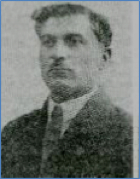 Javad Irzabey oglu Malik-Yeganov was an Azerbaijani politician, the representative of Muslim workers in the Transcaucasian Seim, the Governor-General of Lankaran during Azerbaijan’s independence in 1918–1920, the first chairman of labor union of the Azerbaijan Democratic Republic and the deputy of parliament of ADR from “Musavat” fraction. Malik-Yeganov was born in the village of Tugh (Elisabethpol province), in 1878.
Javad Irzabey oglu Malik-Yeganov was an Azerbaijani politician, the representative of Muslim workers in the Transcaucasian Seim, the Governor-General of Lankaran during Azerbaijan’s independence in 1918–1920, the first chairman of labor union of the Azerbaijan Democratic Republic and the deputy of parliament of ADR from “Musavat” fraction. Malik-Yeganov was born in the village of Tugh (Elisabethpol province), in 1878.
He received his primary education at the school named after Mir Mehdi Khazani. Later he graduated from the technical school.
In 1903 he left his native Garabakh for Baku, where he worked at different, mainly administrative positions of the oil fields. He joined the Muslim Social Democratic Party and within several years became known as an outspeaking socialist among Baku’s oil workers. Javad bey was ordered imprisoned for one year in 1909 and temporarily refused the right to stay in Baku. Upon his release he returned to his native Tugh to continue his education and established contact with prominent scholars of neighbouring Shusha, one of the largest cultural centres of the Caucasus. He returned to Baku in 1914 and was hired as a clerk at the Shibayev and Co. oil company. That same year he joined the “Musavat” Party and enrolled in an undergraduate technical school.
In 1917, Javad Malik-Yeganov was elected in the Transcaucasian Seim as a representative for the South Caucasus’ Azeri community. A year later he was among the Azerbaijani politicians who were members of the Azerbaijani National Council who signed the Declaration of Independence of 28 May 1918 proclaiming Azerbaijan's sovereignty, and became one of Members of Parliament of the newly founded state. On 10 March 1919 he was included in the committee in charge of investigating and reporting on the economic problems of Baku's working class. In June 1919 he became Governor-General of Lankaran after the fall of the British-backed Provisional Military Dictatorship of Mughan and its successor, the Mughan Soviet Republic. His brief governance was marked by major social developments in Azerbaijan’s southeastern regions, including the opening of new schools, libraries and cultural clubs, as well as the encouragement for girls to receive education. He also managed to reconcile the local Azeri population with the pro-Bolshevik representatives of the local Russian community and the Armenian volunteers who fought on their side. Malik-Yeganov remained in that position until Azerbaijan’s Sovietization on 28 April 1920.
Unlike many members of Musavat, Javad Malik-Yeganov did not choose to emigrate after the establishment of the Soviet rule in Azerbaijan. He immediately fell under suspicion in the eyes of the Communist leaders. In the next 18 years he would be imprisoned 6 times. In the 1920s he worked in the construction trust, employment exchange office, department for refugee affairs at the State Labour Commissariat and other government institutions of the Azerbaijan SSR. In 1933 he was accused of being a secret member of “Musavat” and arrested. The court ordered him exiled to the Karelo-Finnish SSR (present day Karelia, northern Russia) to a correctional camp, where he died 9 years later, in 1942.
Mammadbeyli Heybetqulu
Mammadbeyli Heybetqulu Habibulla oglu was born in 1888, in Shaghan village near Baku. He was public figure and politician and Member of Parliament of Azerbaijan Democratic Republic. He graduated from technical industrial school. He was closely involved in spectacle and concerts put up by Baku Muslim charity society, also by “Neshri-maarif” and “Nijat” societies in Baku. Mammadbeyli started his political activity after the February revolution in 1917, took an active part in establishment of “Islam in Russia” party (from late November, 1917, “Ittihad” party). He became a member of Transcaucasia Seym in February, 1918, on February 18 of that year he joined to Muslim faction as a representative of “Ittihad” party. On December 7, 1918, he was elected a Member of Parliament in constituent assembly of the parliament of Azerbaijan Democratic Republic. He was one of the leaders of “Ittihad” faction in parliament. Mammadbeyli also was organizer of many cultural and educational activities at that time in Baku. He worked as a minister of state control at the 2nd cabinet of Nasib bey Yusifbeyli. After the April occupation he worked in different offices, suffered persecution, was arrested and dismissed.
He died on December 16, 1937.
Mehdiyev Mir Yagub
 Mehdiyev (Mirmehdiyev) Mir Yagub was born in 1891 in Khirdalan village of Baku. He was one of the active participants of the national independence movement. After leaving the Aleksandropol (Gyumri) commercial school in 1909, he continued his education in economic department of Petersburg Polytechnic Institute. In 1913, he took a short-term vacation to participate in the secret meeting of the Muslim students of Russia in Kiev. Mehdiyev was expelled from the institute because his was arrested and could not come back to Petersburg in time. But soon he was reinstated. In 1915, after graduating the institute he went to Bonn city of Germany in order to continue his education. Mehdiyev was one of the organizers of “Ittihad” party and was elected a member of the central committee in the first (April, 1918) and second (January, 1920) congresses of party. Before, he took an active part in public and political life of the country as a deputy chairman of the Villagers Union and the Council of Baku Muslim Public Organizations.
Mehdiyev (Mirmehdiyev) Mir Yagub was born in 1891 in Khirdalan village of Baku. He was one of the active participants of the national independence movement. After leaving the Aleksandropol (Gyumri) commercial school in 1909, he continued his education in economic department of Petersburg Polytechnic Institute. In 1913, he took a short-term vacation to participate in the secret meeting of the Muslim students of Russia in Kiev. Mehdiyev was expelled from the institute because his was arrested and could not come back to Petersburg in time. But soon he was reinstated. In 1915, after graduating the institute he went to Bonn city of Germany in order to continue his education. Mehdiyev was one of the organizers of “Ittihad” party and was elected a member of the central committee in the first (April, 1918) and second (January, 1920) congresses of party. Before, he took an active part in public and political life of the country as a deputy chairman of the Villagers Union and the Council of Baku Muslim Public Organizations.
At the meeting of Transcaucasian Seym dated March 25, 1918, the representative of “Ittihad” party Mehdiyev made his first speech on behalf of the Muslim faction, demanding that the South Caucasus should be declared independent. On May 26, 1918, after the fall of the Transcaucasian Federation, he became a member of the National Council of Azerbaijan (May 27, 1918) and according to the law on the formation of Azerbaijan Parliament (November 19, 1918) of the National Council he was entered to the membership of the Parliament without election. He was a member of “Ittihad” faction in parliament. Mehdiyev was involved in Azerbaijani delegation for Paris Peace Conference (1919-1920). After the April occupation (1920) he emigrated to Turkey. In spite of all the efforts of Mir Yagub Mehdiyev, the foreign office of “Ittihad” party was not established.
He represented Azerbaijan in “Prometey” organization together with Mahammad Amin Rasulzade. Mehdiyev took part in Geneva and Lausanne conferences and expressed a strong protest against putting up the Azerbaijani petroleum to auction. His book titled “Petroleum in international policy” was published in Istanbul in 1928. The book gave the detailed analysis of international fight for Baku oil. A little later, the book was translated to French and in 1931, to Chinese language. In 1934, M. Y. Mehdiyev’s article titled “International situation and nationality issue in the Soviet Union” was published in Paris in Russian language.
He died in 1952, in Turkey.
Mehmandarov Samadbey
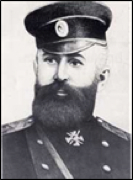 Samadbey Mehmandarov Sadykhbey oglu was born in Lankaran, in 1855. He was an Azerbaijani General of the Artillery in the Imperial Russian Army and served as the Minister of Defense of Azerbaijan Democratic Republic. He graduated from the 2nd Constantine Military School in St. Petersburg in 1875, was conferred the rank of podporuchik and assigned to 1st Turkestan artillery brigade. In the course of military service he was promoted to poruchik in 1877 and seconded two years later to 2nd artillery brigade in St. Petersburg. In 1885 shtabs-kapitan Mehmandarov was assigned to 38th artillery brigade in the Caucasus, where he served 9 years. In 1894, 38th artillery brigade was transferred to Poland, where he became a member of court martial. In 1898, captain Mehmandarov was promoted to lieutenant-colonel and appointed the commander of 1st battery of 3rd artillery battalion. The same year, Mehmandarov’s battery was moved to Transbaikal region and took part in China Relief Expedition in 1901. For the services in battle Mehmandarov was conferred the rank of colonel. In 1903 he completed a course in Tsarskoye Selo Officer's Artillery College.
Samadbey Mehmandarov Sadykhbey oglu was born in Lankaran, in 1855. He was an Azerbaijani General of the Artillery in the Imperial Russian Army and served as the Minister of Defense of Azerbaijan Democratic Republic. He graduated from the 2nd Constantine Military School in St. Petersburg in 1875, was conferred the rank of podporuchik and assigned to 1st Turkestan artillery brigade. In the course of military service he was promoted to poruchik in 1877 and seconded two years later to 2nd artillery brigade in St. Petersburg. In 1885 shtabs-kapitan Mehmandarov was assigned to 38th artillery brigade in the Caucasus, where he served 9 years. In 1894, 38th artillery brigade was transferred to Poland, where he became a member of court martial. In 1898, captain Mehmandarov was promoted to lieutenant-colonel and appointed the commander of 1st battery of 3rd artillery battalion. The same year, Mehmandarov’s battery was moved to Transbaikal region and took part in China Relief Expedition in 1901. For the services in battle Mehmandarov was conferred the rank of colonel. In 1903 he completed a course in Tsarskoye Selo Officer's Artillery College.
When the Russo-Japanese War broke out in 1904, Mehmandarov was appointed the commander of 7th Eastern Siberia artillery battalion. During the siege of Port Arthur he was the commander of the Eastern Front Artillery. For the services in battle he was promoted to major general and decorated with the Order of Saint George of IV degree. After the capitulation of the fortress the garrison was in Japanese captivity. When Japanese commanders allowed the captured Russian officers to return home in exchange to signing an obligation not to fight against Japan, Mehmandarov refused and preferred to stay with his soldiers.
Upon his return from captivity Mehmandarov was appointed the commander of 7th East Siberian Artillery Brigade in 1906, and became the commander of 3rd Siberian Army Corps artillery a year later. In 1908, he was conferred the rank of lieutenant-general. In 1910, he was appointed the commander of 1st Caucasian Division; in 1913 he became the commander of 21st Infantry Division and in this position entered World War I within 3rd Caucasian Army Corps. Under Mehmandarov’s command the division earned the reputation of one of the best in the Russian Army, and 81st Apsheron and 83rd Samur regiments especially distinguished themselves. He was decorated with the Order of Saint George of III degree for the battles of 27 – 29 September 1914, and Saint George sword decorated with diamonds for the battle near Ivangorod on 14 February 1915. On December 11, 1914 Mehmandarov was appointed the commander of 2nd Caucasian Army Corps. Mehmandarov’s corps was engaged in the fiercest battles with German troops and during the whole war had not surrendered to the enemy a single piece of ordnance. On 22 March 1915 Samedbey Mehmandarov was promoted to the rank of the General of the Artillery. He was decorated with British, French and Romanian orders.
After the February Revolution in Russia Mehmandarov resigned and lived in Vladikavkaz. With the establishment of the Azerbaijan Democratic Republic in 1918, Samedbey Mehmandarov became the third and last Minister of Defense of Azerbaijan. He held this position until 11th Red Army troops invaded Azerbaijan in 1920. After the fall of the national government and establishment of the Soviet rule in Azerbaijan Mehmandarov was arrested, but was released two months later. He taught in military schools and was an advisor to the Commissariat of Military and Naval Forces of the Azerbaijan SSR until his retirement in 1928.
Samedbey Mehmandarov died on February 12, 1931 in Baku.
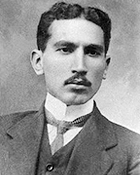 Narimanbeyov Nariman bey
Narimanbeyov Nariman bey
Nariman bey Narimanbeyov was born in 1889, in a family of Hashim oglu, who had become famous due to his asceticism of education in Irevan. Living in Irevan Hashim bey actively participated in creation of charitable societies and schools for Azerbaijanis. Together with other teachers he made the textbook for the Azerbaijani schools named “The Native Language”, which was published in Irevan, in 1907 and subsequently three times in Tiflis.
Narimanbeyov was born in Shusha, Azerbaijan. After completing his secondary education at the Irevan gymnasium where his father taught, he attended universities in Russian and Ukraine, graduating from Department of Physics and Mathematics of Moscow State University and Law Department of Kharkov State University. While abroad, he was an active member of the Azerbaijani students’ revolutionary movement. In 1915, he returned to Irevan and worked as an attorney. Narimanbeyov was also the chairman of Muslim Charity Society in Baku. In 1917, Narimanbeyov joined “Musavat” Party and was elected a member of the Muslim fraction of Transcaucasian Seim. He was a member of the Azerbaijani National Council on the eve of declaration of independence who voted in favor of establishing an independent republic. After establishment of Azerbaijan Democratic Republic on May 28, 1918, Narimanbeyov was elected to the National Assembly of Azerbaijan. When the Fourth Governmental Cabinet under Nasib Yusifbeyli was formed on April 14, 1919, he was appointed the State Controller of ADR.
After Bolshevik’s takeover of Azerbaijan, Narimanbeyov worked as a legal counsel but was soon arrested and became another victim of the Great Purge repressions. He was sent to Solovki prison camp on Solovetsky Islands where he died in 1937.
Pepinov Ahmed bey
 Pepinov Ahmed bey Omar oglu – was a political figure and statesman.
Pepinov Ahmed bey Omar oglu – was a political figure and statesman.
Pepinov Ahmed Jovdat was born in 1893. Having finished the Tiflis Gymnasium, in 1913, Ahmed bey Pepinov entered the Moscow University, where he studied law and economics at the same time. During that period he was one of the leaders of the “Azerbaijani associations” organization.
At the beginning of 1918, Ahmed bey Pepinov graduated from the University and came back to Baku where he began to participate in the political processes happening on the South Caucasus. He was elected a member of the Muslim fraction of the Transcaucasian Seim. Ahmed bey Pepinov was a member of the National Council of Azerbaijan, and then a member and a secretary of the Parliament of ADR. Ahmed bey also participated in the Parliament activity. In the Fifth Governmental Cabinet, founded by N. Usubbeyov (24.12.1919 - 30.03.1920), Ahmed bey Pepinov held a position of the Minister of Labor and Agriculture. He also was an active participant of the Baku State University’s foundation.
After the capture of power in Azerbaijan by the Bolsheviks, Pepinov managed the cultural, educational and publishing work in Azerbaijan. In the periodical press of the 20th numerous articles of Ahmed bey were published. In 1930, owing to prosecutions Pepinov was compelled to move to Ulyanovsk, and later to Alma-Ata. Since 1934 he worked as the Deputy of the People’s Commissariat for Education, in the Kazakh Soviet Socialist Republic.
Ahmed bey Pepinov was repressed in the village Bolazur of Akhalkalaki province of the Georgia in 1938.
Protasov I.
Protasov I. was one of the members of the Parliament of ADR. According to the law of the National Council of Azerbaijan on formation of the Parliament of Azerbaijan (November 19, 1918) Protasov was included into the structure of the Parliament of ADR from the Slavic-and-Russian society. He was a member of the “Slavic-and-Russian society” fraction in the Parliament. Protasov held a post of the Minister of Finance in the Third Governmental Cabinet, headed by Fatali Khan Khoyski since December 26, 1918 till March 14, 1919.
Rafibeyli Khudadat
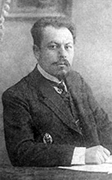 Rafibeyli Khudadat bey Alekber oglu was born in 1873, in Ganja. He was a public figure, a politician, a publicist and a doctor. He finished a classical gymnasium in Ganja. In 1903 he graduated from the medical faculty of the Kharkov University.
Rafibeyli Khudadat bey Alekber oglu was born in 1873, in Ganja. He was a public figure, a politician, a publicist and a doctor. He finished a classical gymnasium in Ganja. In 1903 he graduated from the medical faculty of the Kharkov University.
In 1903 Rafibeyli returned to Ganja and began to practise medicine. In 1906 he was occupied with journalism and wrote not only about medicine, but also about literature, art and history. In 1914 together with Hasanbey Aghayev he founded the "Medical society of Ganja" and was elected its chairman. The society provided needy population with free medical assistance.
In March, 1917 Rafibeyli was elected a member of the Interim Executive Committee of the Muslim National Council, which was set up in Ganja. He wasn’t a member of any party or fraction and remained the non-party till the end of his life.
Rafibeyli held a post of the Minister of Public Health Service and the Minister of Charity in the Second Governmental Cabinet, formed by Fatali Khan Khoyski in June 17, 1918. Later the government of ADR moved to Baku. The Ministry of Health in October of the same year was allocated in the separate ministry, and Khudadat bey was appointed to the post of the Minister of Health. During a short term he opened new hospitals, outpatient clinics and chemist's shops. He also restored old hospitals for rendering free medical service to needy population and opened some barns for storage of the medical equipment and medicines. In December, 1918 when the government of Fatali Khan Khoyski resigned Rafibeyli left his post of the Minister of Health.
In May, 1919 he was appointed the governor of the province of Ganja. On April 30, 1920 after the April’s occupation of Azerbaijan Rafibeyli resigned his commission of the governor at Bolsheviks’ request. On May 12 of the same year he was arrested and shot on the Nargin's island.
Rafiyev Musa bey
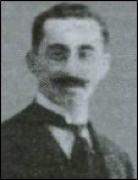 Musa bey Rafiyev Haji Mammadhuseyn oglu was born in Ganja, in 1888. He was an Azerbaijani statesman and a member of the government of ADR.
Musa bey Rafiyev Haji Mammadhuseyn oglu was born in Ganja, in 1888. He was an Azerbaijani statesman and a member of the government of ADR.
Musa bey received his elementary education at the madrasah of Shah Abbas Mosque and then at Ganja Classic Gymnasium. In 1911, he graduated from the Medical Department of Kharkov State University and returned to Ganja to start his medical practice. At the end of 1914, in cooperation with Khudadat Rafibeyli and Hasan bey Aghayev, he co-founded the first Medical Society of Elisabethpol. After the February revolution in1917, he was appointed the representative of the Special Transcaucasian Committee of the Elisabethpol Governorate. On October 25, 1917, in Baku was held the first congress of “Musavat”, where Musa bey Rafiyev was elected a member of the Central Committee of the party. Having joined Musavat party, he became a member of Muslim faction of the Transcaucasian Seim and after its abolishment (on May 26, 1918), a member of Azerbaijani National Council (on May 27, 1918). Azerbaijan Democratic Republic was established on May 28, 1918. When its second government convened on June 17, 1918, Rafiyev was appointed a Special Minister without portfolio, in charge of Social Security and Refugee Affairs and served in the capacity until October 6, 1918.
According to the law of National Council of Azerbaijan on formation of Parliament of Azerbaijan (on November 19, 1918) Musa bey Rafiyev was included into the structure of the Parliament of ADR. In the Parliament he was a member of “Musavat and Non-parties” fraction. He was a member of the Parliament Committee on Finance and Budgets, and also the chairman of the Military Commission. In the Fifth Governmental Cabinet created by N. Usubbeyov (24.12.1919 - 30.03.1920), Musa bey Rafiyev held a post of Minister of Healthcare and Social Security. After establishment of the Soviet power in Azerbaijan he was one of the organizers of Ganja revolt. The revolt was suppressed and he had to immigrate to Turkey. Later Musa bey Rafiyev moved to Tabriz (Iran), where he opened a clinic. He worked as a doctor until his death in 1938.
Rasulzade Mammadali
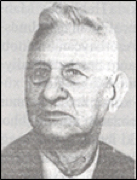 Rasulzade Mammadali Abdulaziz oglu was born on April 7, 1882, in the village Novkhani of Baku. He was one of the active participants of the freedom movement of Azerbaijan, and a member of parliament of Azerbaijan Democratic Republic. Mammadali Rasulzade is Mammad Amin Rasulzade’s cousin. He got his first education from his father who was a religious figure, and then he continued his education at the second Russian-Muslim school opened by the leadership of educationalist Sultan Majid Ganizade. Rasulzade started his political activity in “Muslim Youth Organization” established by Mammad Amin Rasulzade in 1902 and fighting against Russian colonialism. He was one of the first people who affiliated himself with this organization. Rasulzade published articles on revolutionary movement in “Təkamül” (evolution) 1906-1907 and “Yoldaş” (comrade) (1907) newspapers of “Hummat” organization. The chairman of “Union of oil industry workers” which was established by participation of P. Japaridze, M. Azizbeyov, I. Fioletov, S. Efendiyev and others, was P. Japaridze, and technical secretary was Mammadali Rasulzade. He was one of co-organizers of Muslim Democratic “Musavat” party established secretly in October, 1911, in Baku. Also, he was publisher and editor of party newspaper “Açıq söz” (free speech) in the years 1915-1919. In October, 1919, he was elected a member of the Baku committee of “Turk Ademi-Merkeziyyet “Musavat” party”.
Rasulzade Mammadali Abdulaziz oglu was born on April 7, 1882, in the village Novkhani of Baku. He was one of the active participants of the freedom movement of Azerbaijan, and a member of parliament of Azerbaijan Democratic Republic. Mammadali Rasulzade is Mammad Amin Rasulzade’s cousin. He got his first education from his father who was a religious figure, and then he continued his education at the second Russian-Muslim school opened by the leadership of educationalist Sultan Majid Ganizade. Rasulzade started his political activity in “Muslim Youth Organization” established by Mammad Amin Rasulzade in 1902 and fighting against Russian colonialism. He was one of the first people who affiliated himself with this organization. Rasulzade published articles on revolutionary movement in “Təkamül” (evolution) 1906-1907 and “Yoldaş” (comrade) (1907) newspapers of “Hummat” organization. The chairman of “Union of oil industry workers” which was established by participation of P. Japaridze, M. Azizbeyov, I. Fioletov, S. Efendiyev and others, was P. Japaridze, and technical secretary was Mammadali Rasulzade. He was one of co-organizers of Muslim Democratic “Musavat” party established secretly in October, 1911, in Baku. Also, he was publisher and editor of party newspaper “Açıq söz” (free speech) in the years 1915-1919. In October, 1919, he was elected a member of the Baku committee of “Turk Ademi-Merkeziyyet “Musavat” party”.
About two years after the April occupation in 1920, Mammadali Rasulzade worked in cooperative organization within the People Commissariat of Nationalities in Moscow, later, in the summer of 1922, left Baku for Iran and from there for Istanbul. He closely cooperated with “Yeni Qafqasya”, “Azəri türk”, “Odlu yurd”, “Azərbaycan yurd bilgisi” and other newspapers published at that time in Istanbul. His activity in promotion of Azerbaijani literature in Turkey is also remarkable. Many of his articles bearing the signature “M.Ə.Rəsuloğlu” were published in “Azerbaijan” magazine issued in Ankara from the year 1952.
He died on February 3, 1982, in Istanbul.
Rustambeyli Shafi bey
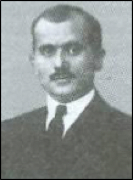 Rustambeyli Shafi bey Mustafa oglu was born in Mammadli’s village of the Aghdash district, in 1893. He was one of the active participants of people’s liberation war in Azerbaijan and a member of the Parliament of ADR.
Rustambeyli Shafi bey Mustafa oglu was born in Mammadli’s village of the Aghdash district, in 1893. He was one of the active participants of people’s liberation war in Azerbaijan and a member of the Parliament of ADR.
Shafi bey finished the Ganja classical gymnasium and entered the Kiev State University (1916), where he studied law. During his study at the university he was a member and one of the leaders of the association of Azerbaijanians. Shafi bey was an active member of the “Musavat” party’s Kiev department, which have been secretly founded in October, 1911. Since 1916 he worked in the Ganja district court. Shafi bey Rustambeyli was a member of the Transcaucasian commissariat, created on November 15, 1917, and also a member of the Transcaucasian Seim’s Muslim fraction. After the breakup of the Transcaucasian Democratic Federal Republic (on May 26, 1918) he became a member of the National Council of Azerbaijan. On May 28, 1918 at the meeting of the National Council of Azerbaijan, which took place in Tbilisi, the Act of independence of Azerbaijan was adopted. Rustambeyli Shafi bey was one of the 24 members of the National Council, who voted for adoption of this Act.
According to the law of National Council of Azerbaijan on formation of Parliament (on November 19, 1918), Rustambeyli was included into the structure of ADR’s Parliament, where he held a post of the chairman of credentials committee. At the first and the second congresses of “Musavat” party Shafi bey was elected a member of the Central Committee of the party, and on the second one, he was also elected the vice-chairman of the party. Shafi bey was an editor of “Azerbaijan” newspaper, and at the same time managed the chancellery of the Ministry of Internal Affairs. Since the beginning of March, 1920 he held a position of the deputy Minister of Internal Affairs.
After the occupation of Azerbaijan by Bolsheviks (1920), Shafi bey moved to Tiflis where he founded the “Committee of liberation of Azerbaijan”. Later, when the 11th Red army captured Georgia, in February, 1921, Shafi bey Rustambeyli moved to Istanbul. During the emigration he laid open to public numerous articles on pages of newspapers and magazines (“Yeni Kavkaz”, “Azeri Turk”, “Odla Yurd”, “Prometheus” and “the Caucasus”).
At the all-Azerbaijanian congress of the “Majlis of National Unity", carried out in Berlin, in 1943, Shafi bey Rustambeyli was elected an honorary member of the Presidium.
He died in Istanbul, in 1960.
Rustambeyov Bakish bey
 Rustambeyov Bakish bey was born in 1870 in Salyan. He was a member of the Parliament of Azerbaijan Democratic Republic. After graduating from secondary school in Baku in 1890, he entered Moscow technical school in the same year. But not finishing the secondary school, he entered mechanics faculty of Saint Petersburg Technologic Institute in 1893. He was expelled from the institute because of his participation in students’ movement, but soon was returned. On graduation from the institute, he came back to Baku and worked as a deputy chief by Shamsi Asadullayev till 1906. Afterwards he carried out the same duties by Agha Musa Haghiyev, worked in the fishery field and in 1910-1917 years in the oil fields. According to the law of the National Council of Azerbaijan on establishment of the Parliament (November 19, 1918), Rustambeyov became a member of the Parliament of the Democratic Republic from Salyan. He represented “Musavat” and unaffiliated faction in Parliament.
Rustambeyov Bakish bey was born in 1870 in Salyan. He was a member of the Parliament of Azerbaijan Democratic Republic. After graduating from secondary school in Baku in 1890, he entered Moscow technical school in the same year. But not finishing the secondary school, he entered mechanics faculty of Saint Petersburg Technologic Institute in 1893. He was expelled from the institute because of his participation in students’ movement, but soon was returned. On graduation from the institute, he came back to Baku and worked as a deputy chief by Shamsi Asadullayev till 1906. Afterwards he carried out the same duties by Agha Musa Haghiyev, worked in the fishery field and in 1910-1917 years in the oil fields. According to the law of the National Council of Azerbaijan on establishment of the Parliament (November 19, 1918), Rustambeyov became a member of the Parliament of the Democratic Republic from Salyan. He represented “Musavat” and unaffiliated faction in Parliament.
Bakish bey Rustambeyov held the leading positions in the field of light industry during Soviet regime, also taught in the fishery institute and technical school, in the training institute within the light industry commissariat.
He was subjected to repression in 1939. In 1942, he was released, but died on the way to Baku.
Rzayev Abuzer bey
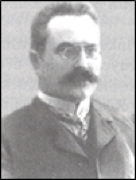 Rzayev (Irzayev) Abuzer bey Asker bey oglu was born in 1876 in Ganja. He was one of active participants of Azerbaijan freedom movement, and a member of the parliament of Azerbaijan Democratic Republic. He was a descendant of Rafibeylis. In 1894, he graduated from Tiflis school, and in 1899, Moscow technical school. From 1899, he worked as an engineer, then as a chief of the oil fields of Musa Naghiyev and Murtuza Mukhtarov in Bibiheybat. In connection with the crisis in the oil industry, he moved to Ganja in 1909, after a while, he was appointed deputy head of Ganja city office. He did a lot for supplying Ganja city with drinking water. A. Rzayev was a member of Ganja Provincial Executive Committee established after the revolution of February, 1917.
Rzayev (Irzayev) Abuzer bey Asker bey oglu was born in 1876 in Ganja. He was one of active participants of Azerbaijan freedom movement, and a member of the parliament of Azerbaijan Democratic Republic. He was a descendant of Rafibeylis. In 1894, he graduated from Tiflis school, and in 1899, Moscow technical school. From 1899, he worked as an engineer, then as a chief of the oil fields of Musa Naghiyev and Murtuza Mukhtarov in Bibiheybat. In connection with the crisis in the oil industry, he moved to Ganja in 1909, after a while, he was appointed deputy head of Ganja city office. He did a lot for supplying Ganja city with drinking water. A. Rzayev was a member of Ganja Provincial Executive Committee established after the revolution of February, 1917.
According to the “Law on establishment of parliament of Azerbaijan” of Azerbaijan National Council, he was elected to the parliament of Republic from Ganja city. He represented “Independents” faction in parliament. After decomposition of this faction in October, 1919 and joining of majority to “Musavat” faction he represented both “Musavat” and “Independents” factions. At the same time, he was a member, then, a head of financial and budgetary commission.
After the April occupation in 1920, he worked as a chief of the oil fields in Bibiheybat for a period of time. On June 15, 1920, he was arrested by Azerbaijan Extraordinary Commission and was executed by shooting.
Safikurdski Aslan bey
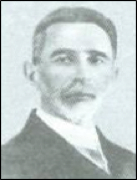 Aslan bey Safikurdski Aghalar bey oglu was born in Ganja, Azerbaijan in 1881. He was an Azerbaijani statesman, an outstanding political figure and a member of the Parliament of ADR.
Aslan bey Safikurdski Aghalar bey oglu was born in Ganja, Azerbaijan in 1881. He was an Azerbaijani statesman, an outstanding political figure and a member of the Parliament of ADR.
After completing his studies at Ganja Gymnasium, he left for Saint Petersburg to attend Saint Petersburg State University. In 1905, he graduated from the Law Department of the university and returned to Ganja becoming the co-chair of “Muslim Charity Society” and chairman of “Actors Society”. Throughout his career (1911-1917), Safikurdski worked as the chief prosecutor in Elisabethpol and Shusha uyezds.
With the establishment of Azerbaijan Democratic Republic, Safikurdski was elected a member to the Executive Committee of Ganja Uyezd and also a member of Ganja Muslim National Council.
Aslan bey became a member of Muslim fraction of the Transcaucasian Seim, created after dissolution of the All Russian Constituent Assembly, and also a member of the National Council of Azerbaijan. He directed the block of Muslim socialists. In December, 1918 he was elected into ADR Parliament from the Gazakh uyezd.
On December 26, 1918 when the Third Governmental Cabinet of ADR was formed, he was appointed the Minister of Postal Service and Telegraph, but later (on March 14, 1919) it was dismissed. With formation of the Fourth Governmental Cabinet of ADR, Safikurdski was appointed the Minister of Labor and Justice. In June 1919, he was appointed a member of the State Defense Committee of ADR. Since January, 1920 he became a member of the Central Committee of Parliament Convocation. Since 1920, Safikurdski continued his activity in the Parliament. On February 5, 1920 he became a member of the Parliament Committee on Finance and Budgets. On April 27, 1920 he took part at negotiations with the Azerbaijani communists.
After Bolshevik takeover of Azerbaijan on April 28, 1920 Safikurdski held various positions. He worked in the legal system of Azerbaijan, where he held a post of a Deputy Commissar at the Ministry of Justice of Azerbaijan SSR. However in 1922, he was arrested and sentenced to 3 years of imprisonment. After discharge Aslan bey found work of the legal consultant in association system of “Azneft”.
But despite of this, he was exposed to prosecutions all the time. He died from long term illness in 1937.

Sanili Haji Karim
Haji Karim Kerbelayi Huseyn oglu Saniyev was born in 1878, in Chayli Kesemen village of Kazakh district in peasant family. He was a Member of Parliament of Azerbaijan Democratic Republic. Sanili was a poet, educationist and public figure. In 1886-1893 years he studied in Muslim ecclesiastical school and graduated from Gori Teachers’ Seminary in 1898. He worked as a principal in 1898-1902 years in Khachmaz village school of Zangezur district, in 1902-1904 years Russian-muslim school in Ganja city and in 1905-1918 years in Poylu and Dagh Kesemen primary schools of Gazakh district. Sanili started his political activity in 1905, in “Difai” party. From 1917 he was a member of Tbilisi Menshevik “Hummat” party. In 1918, he held a position of governor general of Gazakh district. In November, 1918, he was elected to the Parliament of Azerbaijan Democratic Republic from “Hummat” party of Tbilisi and became a member of socialists’ faction. In 1918-1920 years he fought against “Musavat” party and headed the subversive activities against Azerbaijan Democratic Republic.
During the years of Soviet power H. K. Sanili worked in the field of education as a teacher and scientific worker. He was also the author of several lyrical-epic poems, verses and satiric novels. In 1937, he was subjected to repression.
Seyidov Mir Hidayat
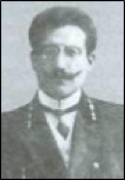 Seyidov Mir Hidayat bey Adil oglu – was one of the active participants of the Azerbaijan People's Liberation Movement and a member of the Parliament of ADR.
Seyidov Mir Hidayat bey Adil oglu – was one of the active participants of the Azerbaijan People's Liberation Movement and a member of the Parliament of ADR.
Hidayat bey was born in 1887, in Ganja. Having finished the Elizabethpol’s (Ganja) classical gymnasium in 1906, Mir Hidayat bey entered the Kazan University, where he studied law. Since 1907 he joined the revolutionary movement. Mir Hidayat bey was the chairman of the Muslim National Council of the Yerevan province and a member of the Transcaucasian Seim’s Muslim fraction. On May 28, 1918 at the meeting of the National Council of Azerbaijan, which took place in Tbilisi, the Act of independence of Azerbaijan was adopted. Mir Hidayat bey was one of the 24 members of the National Council, who voted for adoption of this Act.
According to the law on formation of the Parliament of Azerbaijan (on November 19, 1918) Mir Hidayat bey was included into the structure of the Parliament of ADR. He was one of the 44 members of the National Council.
Seyidov died in 1919 in Ordubad.
Shahsuvarov Nurmammad bey
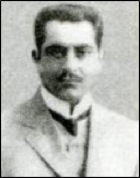 Nurmammad bey Shahsuvarov Adilkhan oglu – was an Azerbaijani statesman who served as Minister of Education and Religious Affairs in the fifth cabinet of Azerbaijan Democratic Republic, and was a Member of Parliament of Azerbaijan. He was also an independence movement participant and educationalist.
Nurmammad bey Shahsuvarov Adilkhan oglu – was an Azerbaijani statesman who served as Minister of Education and Religious Affairs in the fifth cabinet of Azerbaijan Democratic Republic, and was a Member of Parliament of Azerbaijan. He was also an independence movement participant and educationalist.
Shahsuvarov was born in 1883, in the village of Lachin district of the Minkend. In 1903 he graduated from Transcaucasian Teachers Seminary and taught Russian language in Ganja for several years. He then graduated from Tbilisi Alexander Pedagogical Institute 1912 and Law Department of Kiev University in 1915. He was a participant of February Revolution of 1917 and became the Minister of Education of Mountainous Republic of the Northern Caucasus, established in the summer of 1918.
In June, 1919 Shahsuvarov moved to Azerbaijan and joined Ittihad Party. He was then appointed Deputy Minister of Education. Under his leadership, many schools were opened in villages and towns of Azerbaijan. On March 5, 1920, he was appointed Minister of Education in the fifth cabinet of Azerbaijan Democratic Republic lead by Nasib Yusifbeyli, effectively replacing Hamid bey Shahtakhtinski who resigned from his position to teach at Baku State University. His term ended on April 1, 1920 when the last fifth government dissolved.
After Bolshevik invasion of Azerbaijan, Shahsuvarov was appointed Deputy Education Commissar of Azerbaijan SSR and taught Russian in secondary and high schools. In 1940, he was arrested with false accusation and sent to Krasnodar repression camp. He was released in 1943 and returned to Baku where he worked as the Professor of Russian language at Baku Medical University from 1946 to 1958 and Azerbaijan State Oil Academy, was a Dean of Russian Language Department at Baku State University. He died on August 11, 1958 in Baku.
Shahtakhtinski Hamid bey
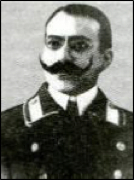 Shahtakhtinski Hamid bey Khalil oglu – was an Azerbaijani statesman who served as a Minister of Education and Religious Affairs in the fifth cabinet of Azerbaijan Democratic Republic, and was a Member of Parliament of Azerbaijan. He was also a prominent educationalist.
Shahtakhtinski Hamid bey Khalil oglu – was an Azerbaijani statesman who served as a Minister of Education and Religious Affairs in the fifth cabinet of Azerbaijan Democratic Republic, and was a Member of Parliament of Azerbaijan. He was also a prominent educationalist.
Hamid bey was born on March 12, 1880, Shakhtakhty village of Nakhchivan. After completing his secondary studies in a religious school in Nakhchivan, he studied at Irevan Pedagogical Seminary graduating in 1899. He then worked at the same institution as a teacher of Azerbaijani and Russian languages. He was also a member of Irevan Muslim Charity Society. Shahtakhtinski then left for Odessa, Ukraine to attend Novorossiysk University, where he graduated with a law degree. While a student in Ukraine, he joined Azerbaijani Compatriots organization. In 1912, he returned to Azerbaijan and settled in Ganja, where in 1914 he was appointed Chief Inspector of Elisabethpol Governorate schools. He then worked as Assistant Prosecutor at Elisabethpol District Court for two years. After moving to Baku in 1916, he worked in the same position at Baku District Court.
In 1917, he joined Ittihad Party and was appointed Commissar of South Caucasus Education Department. Shahtakhtinski was a member of the Azerbaijani National Council on the eve of declaration of independence who voted in favor of establishing an independent republic. After establishment of Azerbaijan Democratic Republic on May 28, 1918, he was elected to the National Assembly of Azerbaijan from Ittihad faction. During the work of the second, third and fourth cabinets, Shahtakhtinski served as Deputy Minister of Education and Religious Affairs. He directed qualification courses established on September 9, 1918 for local teachers in Shaki, Zaqatala and Shusha. When the fifth government under Nasib Yusifbeyli was formed on December 22, 1919, he was appointed Minister of Education and Religious Affairs of ADR. While a minister, he played a significant role in establishment of Baku State University, where he also delivered lectures and worked as a dean in later years.
After Bolshevik take over of Azerbaijan on April 28, 1920, Shakhtakhtinski graduated from Transcaucasian University in Tbilisi and taught at Azerbaijan University of Languages and Azerbaijan Medical University from 1930 through 1940. Shahtakhtinski was married to his cousin and had four daughters.
In 1941, he was arrested as a result of Soviet repressions and sent to Solovki prison camp in Arkhangelsk Oblast where he died on February 3, 1944.
Sheykhulislamov Akbar Agha
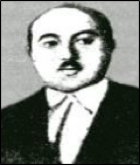 Sheykhulislamov Akbar Agha Ibrahim oglu – was an Azerbaijani public figure and politician, Member of Parliament of Azerbaijan Democratic Republic.
Sheykhulislamov Akbar Agha Ibrahim oglu – was an Azerbaijani public figure and politician, Member of Parliament of Azerbaijan Democratic Republic.
Akbar Agha was born in 1891, in Irevan city. Having graduated from a gymnasium in Erivan, he got enrolled Petersburg State Transport University in 1912. Upon his return to Azerbaijan, he worked as the Deputy Minister of Internal Affairs of Transcaucasian Democratic Federative Republic. Sheykhulislamov was a member of Hummet party. He was one of the co-signers of Proclamation of Independence of Azerbaijan Democratic Republic.
After establishment of Azerbaijan Democratic Republic on May 28, 1918 he was appointed Minister of Agriculture and Labor in Fatali Khan Khoyski's newly formed government and served in the National Assembly of Azerbaijan until the Bolshevik invasion of Azerbaijan on April 28, 1920. He was a member of Azerbaijani delegation sent to Paris Peace Conference (1919-1920). In the twenties of the 20th century he was a representative of Azerbaijan at the Second International in Paris. The article titled “How was the Azerbaijan Republic established” in “Azerbaijan” magazine (No. 2) published in Russian in Paris offered detailed information on the events of May 26-28, 1918. That article was republished in “Mujahid” magazine (1962, No. 49-50) in Ankara.
Sheykhulislamov died on March 2, 1961 in Paris, France and was buried in Bobigny cemetery.
Sheykhzamanli Mammadbaghir
 Sheykhzamanli Mammadbaghir Salah bey oglu was born in Ganja in 1881. He was a public, political, cultural figure and educationalist. He was from old Sheykhzamanli descent of Ganja. M. Sheykhzamanli graduated from Ganja school and took an active part in cultural life of the city. In 1906, he established a drama society and staged the plays of Azerbaijan and Europe playwrights. He took an active part in establishment of Ganja branch of “Difai” party and was a member of city Duma. After the February revolution (1917) he joined to “Turk Ademi Merkeziyyet Party” formed by Nesib bey Yusifbeyli in Ganja. Later, the above mentioned party joined to Muslim democratic “Musavat” party of Mammad Amin Rasulzade and was titled “Turk Ademi Merkeziyyet Musavat Party”. Sheykhzamanli took an active part in establishment of Azerbaijan Democratic Republic and was elected a Member of Parliament from “Musavat” party. By the order of the chairman of State Defense Committee formed in the early June, 1919, Sheykhzamanli was appointed a head of the organization for fighting against counter revolution. He contributed greatly to protection of national security from internal and external enemies. But on August 20, 1919, he was dismissed at his own request and his younger brother Naghi bey Sheykhzamanli was appointed to that position. Meanwhile, he did a lot in the field of enlightenment in Azerbaijan and published various articles in periodical press.
Sheykhzamanli Mammadbaghir Salah bey oglu was born in Ganja in 1881. He was a public, political, cultural figure and educationalist. He was from old Sheykhzamanli descent of Ganja. M. Sheykhzamanli graduated from Ganja school and took an active part in cultural life of the city. In 1906, he established a drama society and staged the plays of Azerbaijan and Europe playwrights. He took an active part in establishment of Ganja branch of “Difai” party and was a member of city Duma. After the February revolution (1917) he joined to “Turk Ademi Merkeziyyet Party” formed by Nesib bey Yusifbeyli in Ganja. Later, the above mentioned party joined to Muslim democratic “Musavat” party of Mammad Amin Rasulzade and was titled “Turk Ademi Merkeziyyet Musavat Party”. Sheykhzamanli took an active part in establishment of Azerbaijan Democratic Republic and was elected a Member of Parliament from “Musavat” party. By the order of the chairman of State Defense Committee formed in the early June, 1919, Sheykhzamanli was appointed a head of the organization for fighting against counter revolution. He contributed greatly to protection of national security from internal and external enemies. But on August 20, 1919, he was dismissed at his own request and his younger brother Naghi bey Sheykhzamanli was appointed to that position. Meanwhile, he did a lot in the field of enlightenment in Azerbaijan and published various articles in periodical press.
In April, 1920, in the days of Russian bolshevik takeover of Azerbaijan Democratic Republic, Sheykhzamanli was arrested and by the decision of special department of 11th Red Army, he was shot for his service for independent Azerbaijan.
Sheykhzamanli Naghi bey
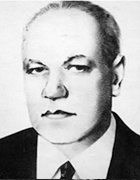 Naghi Salah bey oglu Sheykhzamanli — also known as Naki Keykurun was born in 1883 in Elisabethpol, the present-day Ganja, Azerbaijan. He was an Azerbaijani public figure, politician and the head of the counterintelligence service of Azerbaijan Democratic Republic within the fourth and fifth cabinets led by Nasib bey Yusifbeyli.
Naghi Salah bey oglu Sheykhzamanli — also known as Naki Keykurun was born in 1883 in Elisabethpol, the present-day Ganja, Azerbaijan. He was an Azerbaijani public figure, politician and the head of the counterintelligence service of Azerbaijan Democratic Republic within the fourth and fifth cabinets led by Nasib bey Yusifbeyli.
Naghi Salah bey was born in 1883, in Ganja. In 1905, Sheykhzamanli joined "Difai" (Defender) National Committee established by the Ahmed bey Aghayev in Ganja, which in 1917 merged with the National Party of Turkic Federalists established by Nasib bey Yusifbeyli. Upon the establishment of Azerbaijan Democratic Republic, Sheykhzamanli became an instrumental figure behind the invitation of the Ottoman forces to support the ADR government in its struggle against the Bolshevik Baku Commune. During the negotiations with the Ottoman Commander-in-Chief Enver Pasha, Sheykhzamanli successfully pushed for Enver's brother, Nuru Pasha, to take the lead over the Ottoman offensive in the Caucasus.
Upon the Bolshevik occupation of Azerbaijan in April 1920, Sheykhzamanli left for Turkey. Later in life, he moved and settled with family to New Jersey, United States, where they established Azerbaijan Society of America in 1957. Under the pen-name of Naki Keykurun, he also published a few essays in Turkish about the first Azerbaijani independence movement in Istanbul, including "The Great Philanthropist Haji Zeynalabdin Taghiyev" (1957), "The Confession" (1963), and "The Memoirs of the National Liberation Movement in Azerbaijan" (1964). The latter two books were republished by the Ministry of National Security of Azerbaijan in 2004.
Naghi Sheykhzamanli died in Istanbul in 1967, in Istanbul.
Shikhlinski Ali-Agha
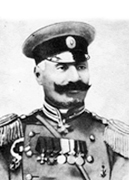 Shikhlinski Ali-Agha Ismail-Agha oglu was born on April 23, 1865 in a small settlement of the Gazakh district of the Elisabethpol’s province, in the family of landowner. He descended from an old noble family first mention which relates to 1537. His mother Shah Yemen Khanum was a grandchild of a famous poet Molla Vali Vidadi.
Shikhlinski Ali-Agha Ismail-Agha oglu was born on April 23, 1865 in a small settlement of the Gazakh district of the Elisabethpol’s province, in the family of landowner. He descended from an old noble family first mention which relates to 1537. His mother Shah Yemen Khanum was a grandchild of a famous poet Molla Vali Vidadi.
In August 1876 he entered the Tiflis military gymnasium, subsequently renamed into the Cadet Corps, which he graduated in 1883.
On September 1, 1883 he began his military service as a cadet of Mikhaylovsky Artillery School in Saint Petersburg. Having finished school according to the first category, on August 11, 1886 Ali-Agha Shikhlinski received the rank of the second lieutenant by the royal order and was assigned to the 39th artillery brigade, located in the Caucasus, in town of Alexandropol (nowadays Gyumri). His military service there began in the 5th, later in the 2nd battery, and at the end of October he was appointed as a teacher of the brigade educational team, preparing Feuerwerkers (non-commissioned officers). On November 23, 1887 he was appointed as a lieutenant, and in April, 1891 received his first award — St. Stanislav's award of the 3rd degree.
On July 15, 1894 A.Shikhlinski became a staff captain and later, in September and he was appointed as commander of the training team. Since February 1, 1895 he served as a senior officer of the 1st battery. In February, 1896 he was decorated with an order of St. Anna of the 3rd degree. Since July 19, 1898 A. Shikhlinski became a captain. From June, 1899 to February, 1900 he temporarily carried out the duties of the 1st battery’s commander. At the beginning of 1900 Ali-Agha decided to be transferred to serve to the Eastern Siberia. On February 17 went out the royal decree on transfer of the captain A. Shikhlinski to the Separate Transbaikal artillery division. Having gone to the new place to work on March 14, 1900, Shikhlinski arrived to the division on May 17 and was appointed the senior officer of the 1st battery. The Separate Transbaikal artillery division consisted of two batteries: the 1st battery was under the command of Colonel V. I.Engelman, and the 2nd one was under the command of lieutenant colonel Samadbey Mekhmandarov. Due to the shortage of officers in the 2nd East Siberian flying artillery train (the rear division which had stocks of ammunition) Shikhlinski fulfilled duties of the commander of that artillery train for some period. Being a part of the Separate Transbaikal artillery division he also took the field in the China Relief Expedition. Due to the distinguished services in a deal against the Chinese on May 1, 1901 A.Shikhlinski was decorated with the Order of St. Stanislav Second class with swords.
From May, 1901 to March, 1902 A.Shikhlinski fulfilled duties of the commander of the 1st battery and the commander of a division. In May-June, 1902 he temporarily commanded the 2nd battery, and in July at least he was appointed the senior officer of that battery. From August of the same year to October, 1903 he commanded the 2nd battery, replacing decreased in six-months holiday and with study to St. Petersburg colonel S. Mekhmandarov.
During the Russo-Japanese War Shikhlinski was the commander of an artillery battery. In February, 1904 the colonel S. Mekhmandarov was appointed the commander of the 7th East Siberian shooting artillery division, and after this the captain Shikhlinski was temporarily appointed the commander of the battery. He especially distinguished himself during the siege of Port Arthur when, despite being severely wounded in his leg, he personally aimed the guns which lost their guncrews and repulsed attacks of superior Japanese forces. For the services in battle on September 28, 1905, he was decorated with the Order of Saint George Fourth class. He was also awarded a golden sword and conferred the rank of lieutenant-colonel.
In total Ali-Agha Shikhlinski was awarded the following awards for his service in the Russian-Japanese war: The Order of Saint George Fourth class, the gold weapon with an inscription "For the Bravery", gold swords enclosed for the Order of St. Anna Second class, The Order of Saint Vladimir Fourth class with swords and a bow, the Order of St. Anna Fourth class with an inscription "For the Bravery".
On May 25, 1905 Shikhlinski was transferred to the 2nd division of the 15th artillery brigade dislocated in Odessa. On November 26, 1905, the day of the St. George holiday, Ali-Agha Shikhlinski was promoted to the rank of colonel. At the same day among other bearers of the order he was invited to the state reception to the Tsarskoye Selo palace where he was presented at court.
As A. Shikhlinski had a rank of the lieutenant colonel he must be the commander of the battery, but there weren’t vacancies. Because of this he addressed with the official report to the general inspector of the artillery to send him to the alternate structure of the Officer Artillery School in St. Petersburg. In January 1906, Shikhlinski was seconded to Tsarskoye Selo Officer's Artillery School, which he finished with honors in August of the same year and was appointed the instructor of the Artillery School. For excellent and diligent service on May 13, 1907 Shikhlinski "The highest goodwill" was declared. During his service as the instructor of the college Shikhlinski published a number of works on artillery, including a book titled “Use of Field Artillery in a Battle”, and invented an original target-finding device, which was called “Shiklinski triangle”. On September 22 he was appointed the senior officer of the 7th battery of the 15th artillery brigade, and on December 9 the commander of the 5th battery of the 29th artillery brigade dislocated in Riga.
On February 14, 1908 the lieutenant colonel Shikhlinski was sent to the constant structure of the Officer Artillery School where he held a position of the head. Since February 29 and then he held a post of the staff officer and the manager of the officers who were trained at that school. On November 26, 1908, Shiklinski was promoted to the rank of colonel, and in 1912 he was conferred the rank of major-general and assigned the deputy chief of the Officer's Artillery School.
During his service at the Artillery School he managed to publish "The instruction for the organization of artillery maneuvers as a part of a division", the abstract of the lectures given at the Officer Artillery School under the name "The Use of Field Artillery in Fight" and the article "About Artillery Firing through the Head of the Armies". These works were widely adopted and had a great impact on development of artillery science. On August 26, 1914 by the order of the chief of the Head artillery department the major general Shikhlinski was appointed the chief of the Officer Artillery School.
When World War I started in 1914 Ali-Agha Shikhlinski was appointed the commander of St. Petersburg garrison artillery. In the first months of war it became obvious that there were serious defects in the organization of the supreme management of artillery. For the purpose of studying of this question, in October, 1914 on the South Western front the major general Shikhlinski was sent.
In January, 1915 Shikhlinski was seconded to the Northwestern front to manage the training of heavy artillery guncrews. On May 23, 1915, he was appointed the general for errands at the commander-in-chief of the Northwestern front, and after division of the front into two held the same position at the Western front. On October 31, 1915 he was appointed to the position of the general for errands at the Supreme Commander-in-Chief. He was charged with creation of heavy artillery battalions and brigades.
From April 1916 16, Shikhlinski was the acting inspector of Western Front artillery. He was in charge of the artillery aspects of operations of the Western Front. On April 2, 1917 Ali-Agha Shikhlinski was promoted to the rank of lieutenant-general.
On September 9, 1917 by the order of the Supreme Commander the lieutenant general Shikhlinski was appointed the commander of the 10th army. This appointment was recognition of his talent of a military leader and an appreciation of military work. Military work of Shikhlinski in the years of World War I was noted by the Order of St. Stanislav First class, the Order of St. Anna First class with swords, the Order of St. Vladimir Second class with swords and a rank of the lieutenant general.
At the end of 1917 A. Shikhlinski arrived to Tiflis where by the decision of the Special Transcaucasian Committee he was appointed the commander of again formed Muslim (Azerbaijani) corps. In January 1919, the government of Azerbaijan Democratic Republic appointed Shikhlinski a deputy to the Minister of Defense of Azerbaijan Republic Samedbey Mehmandarov. On June 28, 1919, Ali-Agha Shikhlinski was promoted to the rank of General of the Artillery of the Azerbaijani army.
After the establishment of the Azerbaijan SSR on April 30, 1920 Shikhlinski was appointed the assistant to the People’s Commissar for Military and Naval Affairs of the republic, where he fulfilled duties of the military head of the People’s Commissar.
After the cruel suppression of anti-Soviet revolt in Ganja at the end of May, 1920 almost all officers of the Azerbaijani national army were arrested. S. Mekhmandarov and A.Shikhlinski were also among the arrested. They both were rescued from repressions due to Nariman Narimanov’s intervention, who was the head of Council of People’s Commissars of Azerbaijan that period.
At the beginning of August, 1920 Shikhlinski was seconded to Moscow, where he was an adviser to the artillery inspection department of Red Army and taught at the Higher Artillery School. On 18 July 1921, Shikhlinski was transferred back to Baku, where he taught at the Military School and became a deputy to the chairman of the military science society of Baku garrison. Since October 15, 1924 he was an assistant to the chief of the Azerbaijan Associated Military School of commanding officers. Since February 6, 1924 he also held a position of the chairman of the Military editorial publishing board of Azerbaijan SSR under the Revolutionary Council of War of the Caucasian army. In 1926, Shikhlinski published the Russian-Azerbaijani Concise Military Dictionary. For this work, on February 23, 1928 A.Shikhlinski was awarded with the Certificate of Honor of the Revolutionary Council of War of the USSR. He resigned from military service in 1929 and wrote his memoirs, which were published in 1944.
Ali-Agha Shikhlinski died in Baku on 18 August 1943 and was buried on the Yasamal cemetery.
Sultanov Khosrov bey
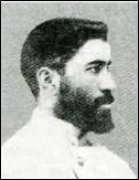 Khosrov bey Pasha bey oglu Sultanov was born in the Zangezur district’s village Kurdhaji of the Elisabethpol’s province. He studied in gymnasium, in Ganja and in 1903 he graduated from medical faculty of the Novorossiysk University. In 1917 Khosrov bey became a member of the "Musavat" party, but in 1918 he left it for the “Ittikhad” party. He also was a member of the Transcaucasian Seim. Khosrov bey Sultanov was one of the 26 people who signed the Independence Act. During the period of ADR he held a post of the Minister of Defence (May — June 1918) in the First Governmental Cabinet, and a post of the Minister of Agriculture (June — July 1918) in the Second Governmental Cabinet.
Khosrov bey Pasha bey oglu Sultanov was born in the Zangezur district’s village Kurdhaji of the Elisabethpol’s province. He studied in gymnasium, in Ganja and in 1903 he graduated from medical faculty of the Novorossiysk University. In 1917 Khosrov bey became a member of the "Musavat" party, but in 1918 he left it for the “Ittikhad” party. He also was a member of the Transcaucasian Seim. Khosrov bey Sultanov was one of the 26 people who signed the Independence Act. During the period of ADR he held a post of the Minister of Defence (May — June 1918) in the First Governmental Cabinet, and a post of the Minister of Agriculture (June — July 1918) in the Second Governmental Cabinet.
On January 15, 1919 Khosrov bey Sultanov was appointed as a governor-general of Karabakh and Zangezur by headquarters of English occupation troops. According to the report of the Azerbaijani Ministry of Internal Affairs, the main tasks of Sultanov on this post were “the fight and complete elimination of the Armenian movement, the final public ordering, the organization of local government, refugees’ arrangement of food supplies and common assistance in whole, the organization of pest control both among refugees, and among indigenous people and, at last, the return of the refugees to their native heath”. In summer of 1919 Sultanov had rendered great services to his country, especially in reinstatement of sovereign Azerbaijan rights in Karabakh, Zangezur and other places where Armenians raised territorial claims.
On August 22, 1919 the agreement which declared that Nagorno-Karabakh considered itself "temporarily within the Azerbaijan Republic" (till the final solution of the issue at the Parisian Peace Conference) was signed. Herewith Armenians kept self-government. Azerbaijan had the rights to maintain garrisons in Shusha and Khankendi only by staffs of a peacetime. Azerbaijan had not rights to bring troops into Nagorno-Karabakh without the consent of the Armenian National Council. Complete disarmament of the townspeople had been suspended till the solution of the Parisian Peace Conference. Herewith Zangezur in spite of having opportunity to rely on a direct support of the republic of Ararat didn't recognize Sultanov's power.
After establishment of the Soviet Power in Azerbaijan on April 28, 1920 Sultanov immigrated to Turkey. Being one of the “Ittikhad” party’s leader Sultanov was very active in emigration. During the World War II Khosrov bey Sultanov put more than a little effort into organization of the Azerbaijani war prisoners’ discharge from the German camps. Khosrov bey was the person who opened the Azerbaijani hospital in France.
Taghiyev Agha Zeynal
Taghiyev Agha Zeynal was one of the participants of the Azerbaijan National Liberation Movement, a member of the Parliament of Azerbaijan Democratic Republic. He was one of the organizers of “Ittihadi-Islam-Muslimism in Russia” party and was elected a member of the Central Committee at the second congress of the party (January, 1920). According to the law of the National Council of Azerbaijan “On establishment of the Azerbaijan Parliament” Taghiyev Agha Zeynal was elected to the Parliament of the Azerbaijan Democratic Republic from Baku city.
Topchubashov Alimardan bey
 Alimardan bey Topchubashov was born on May 4, 1862 in Tbilisi. In 1884 he finished the first local gymnasium in Tbilisi and entered the St. Petersburg Imperial University on historical and philological faculty with the Caucasian grant. But later, when the first semester was over, he refused from the grant and changed his faculty for law one. In 1888 he graduated from the University and got a degree of candidate of law science. He worked as an assistant to the justice of the peace and a secretary of district court. He also taught in the Tbilisi Geodetic School. In 1894 Topchubashov moved to Baku, where at the same year he married Peri khanum, who was the daughter of the outstanding Azerbaijani enlightener Hasan bey Zardabi. The influence of Hasan bey, historical conditions of the end of XIX – the beginnings of the XX century, the influence of progressive ideas of that period defined the subsequent most important developmental milestones of Topchubashov’s life.
Alimardan bey Topchubashov was born on May 4, 1862 in Tbilisi. In 1884 he finished the first local gymnasium in Tbilisi and entered the St. Petersburg Imperial University on historical and philological faculty with the Caucasian grant. But later, when the first semester was over, he refused from the grant and changed his faculty for law one. In 1888 he graduated from the University and got a degree of candidate of law science. He worked as an assistant to the justice of the peace and a secretary of district court. He also taught in the Tbilisi Geodetic School. In 1894 Topchubashov moved to Baku, where at the same year he married Peri khanum, who was the daughter of the outstanding Azerbaijani enlightener Hasan bey Zardabi. The influence of Hasan bey, historical conditions of the end of XIX – the beginnings of the XX century, the influence of progressive ideas of that period defined the subsequent most important developmental milestones of Topchubashov’s life.
Alimardan bey became the herald of the ideas of the Muslim world’s transformation, the propagandist of Islamic values and restoration of the rights of Turkic language, the defender of europeanization of thinking and life of the Azerbaijani society. On June 24, 1898 Topchubashov became the editor of the “Caspiy” newspaper, issued in Baku. Important asset of Alimardan bey was his active participation in opening of the school for Muslim girls in 1901, which came out of material backing of Baku Maecenas Haji Zeynalabdin Taghiyev, who became one of the three trustees of that school. Topchubashov regarded this event, as "a way from pitch darkness to light". Meanwhile Topchubashov continued his activity as a town councillor also. Together with Ahmed bey Aghayev and Farrukh bey Vezirov he used a tribune of the Municipal Duma for promotion of the Turkic population’s expansion representation in economic and spiritual life of the city.
The events of the First Russian revolution (1905-07) played a huge role in Topchubashov's destiny. Wide prospects for full display of his remarkable talent as a public figure and the politician on the All-Russian scale were opened. First of all, it’s notable that this period Topchubashov was one of the outstanding representatives of that part of not numerous Muslim intellectuals who, with a big inspiration used all possibilities of the new time for protection of the rights of the people whom they represented.
On April 8, 1905 in Petersburg, a number of popular for that period Muslim public figures, gathered in the apartment of Gabderrashid Ibrahim, where they came to an agreement about creation of the unified political party of the Russian Muslims. Alimardan bey was the active participant of this meeting and the reached agreement. Inspired with success he hurried to Baku where, after a long break the edition of the first newspaper in the Azerbaijani language is planned to be issued. Later, the newspaper named “Hayat”, due to Topchubashov’s invests and applying much effort to the permission of its edition, began to be published regularly. That newspaper has played its part in development of the national consciousness of the Turkic people and consolidation of their unity. The editor-in-chiefs of the newspaper, which owner was A.Topchubashov, were well known heralds of the Turkic unification Ali bey Huseynzade and Ahmed bey Aghayev. It defined a cast of mind of the newspaper, on which pages actively made statements not only public figures and enlighteners of Azerbaijan, but also representatives of other Turkic-speaking regions of Russia: the Crimea, Central Asia, Tataria.
In August, 1905 Topchubashov founded and headed the Muslim Society of charity and education. In August, of the same year, together with his like-minded persons Sh. Asadullayev, A.Aghayev, N. Vezirov, S. Taghizade he went to Nizhny Novgorod, where the first congress of representatives of the Muslim people of Russia was supposed to hold. On August 15, this congress was hold semi-legally on the steamship "Gustav Struve". In his speech, which with a good reason could be called a program, Topchubashov spoke about necessityof political party’s formation, which would be capable to consolidate the progressive forces of the public for the sake of ensuring progress of the Muslim people. It was typical of him that, addressing to those present, he concentrated their attention on the common Turkic ancestry of the majority of the Muslim people of Russia. It was a serious bid for transition from nationalism of religious character to nationalism of the ethnic, Turkic substance. He said: "We are heirs and assigns of the Turkic people, of one tribe, of the common roots, of one religion". The same thought sounded in the speech of the outstanding representative of the Turkic people I.Gasprinski and in many spechees of other delegates too.
After declaration of the Manifesto of Nikolay II of October 17, about the “donation” of democratic freedoms to the people of Russia, the group of Muslim public figures held a meeting in Petersburg. In this meeting’s work active part took A.Topchubashov and A.Aghayev. At the II congress of the Muslims of Russia in January, 1906 Topchubashov already stated his thoughts of the program of the founded party, which was named the "Ittifaq-al-Muslimin". On elections of the I State Duma of Russia Topchubashov spoke already as a recognized leader of the Russian community of the Muslim, and in the majority of the Turkic people. "Ittifaq"’s supporters won absolute majority of votes of Muslims at the Duma elections, and Topchubashov was elected the leader of fraction of Muslim deputies in the Duma. However, Topchubashov's Duma activity didn’t go for long. On July 9, 1906, catching at an excuse the interfractional conflicts in the Duma, the tsar dismissed the Duma. Together with party members of the National Freedom (Cadets) the Duma deputies from "Ittifaq", including A.Topchubashov gathered in Vyborg, near Petersburg, where they signed the well-known protest letter which, was named the Vyborg proclamation, in which they denounced the autocracy in failuring to keep its promise to follow voters’volition in very scathing form. Incensed by strength of the form of address, the tsar angered by sharp tone of the address ordered to take protestants into custody. Against the ex-deputies of the Duma, including Topchubashov, the criminal case was complained, and everyone got various terms of imprisonment. Alimardan bey stayed in the well-known prison "Kresti" for three months. He was discharged from the “Caspiy” newspaper’s editing, and removed from the structure of the Baku Public Duma. As well as the other Protestants, he was prohibited, to stand for the Duma election repeatedly.
The "Vyborg" misadventures didn't shake Topchubashov's confidence of fidelity to the chosen way. In August, 1906 he became one of the senior figures of the III All-Russian congress of Muslims of Russia. At that congress he submitted to the delegates the draft of the party program of "Ittifaq-al-Muslimin". In the program it was noted that as the purpose of association’s creation served the intention to "adjust our political, economic, public, religious cases". Confirming requirements of providing Muslims of Russia with all civil laws, the program supplemented with popular in those days program installations of the Russian political parties and the liberal organizations. The program was approved by the congress. The adoption of the program was also supplemented with adoption of the Constitution of the "Ittifaq", which defined organizational structure of the party. Alimardan bey became the central figure of the elected Central Committee of the party.
During this period, against the background of the flared up international Armenian-Azerbaijani armed conflict, Alimardan bey stood up for interests of the people very actively, exposing aggressive essence of an adverse party, a provocative role of the Russian officials movable by feelings of self-seeking and national conceit. Concerning behavior of representatives of the imperial government in relation to Azerbaijanians Topchubashov said: "A critical situation arose in our country, when statesmens can't work according to their conscience and justice". In connection with these murderous events Topchubashov proved himself as an original humanist and an active adherent of the international peace. Due to Topchubashov’s intermediation, the international collisions of that period were abating periodically, and finally, didn't develop into a permanent condition until a certain time. The publications of the “Caspiy” newspaper edited by Topchubashov played a big role in stabilization of that situation.
After the revolution which held on June 3, 1907, when the Russian autocrat dispersed the State Duma once again, the possibilities of free political activity in Russia were prejudiced. Nevertheless, Topchubashov was still one of the most active public figures of Azerbaijan of that time. He went to Iran where he was within his powers in attempts of justice reforming. He also took part in the IV congress of Muslims of Russia, taken place in June, 1914 in St. Petersburg. But, undoubtedly, new rising of political activity of Topchubashov dates back to the time when Russian autocracies were dethroned. Together with his adherents, Alimardan bey made a speech with the idea of a national and territorial autonomy at congresses of Muslims, which held in Baku (April 1917) and Moscow (May 1917). At those congresses most of delegates supported granting to the ethnic minorities of the empire of only cultural autonomy. But A.Topchubashov and M.E. Rasulzade managed to lead the way the most part of delegates. Due to this the number of federal state system’s adherents considerably increased. And it wasn't accidental, that in the struggle for power, the leader of Bolsheviks Lenin, found it possible to declare expediency of federation. But Alimardan bey didn't accept the socialist idea. At the State meeting, which held in Moscow in August, 1917 Topchubashov supported "a peace with honor without annexations and contributions, based on self-determination of the nations". He declared for the federal system of Russia.
For all his conscious life, Topchubashov was a protagonist of the idea of the independent and united Caucasus. In Paris, where at that moment lived all former heads of Georgia, Armenia and the North Caucasus, there was a possibility of meetings and coordination of actions. Topchubashov's efforts crowned with success.
On June 10, 1921 the declaration of "The Union of the Caucasian republics"’s foundation was signed by Topchubashov, Chkhenkeli, Agoranyan and Chermoyev.
On Genoa (1922) and Lausanne (1923) conferences he raised a question of illegal occupation of Azerbaijan by the Red Army.
On July 14, 1934 in the name of Azerbaijan Topchubashov and Mammad Amin Rasulzade signed the pact about the Caucasian Confederation’s (Azerbaijan, Georgia and the North Caucasus) foundation in exile. These countries signed the agreement with Ukraine of mutual struggle for rehabilitation of their independence.
Topchubashov died of a long and serious illness in 1934. He was buried in the Saint-Cloud’s cemetery of Paris suburb.
Vakilov Mustafa
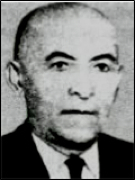 Mustafa bey Nadir Aga oglu Vakilov (1899 – 1943) was an Azerbaijani public figure, politician and diplomat. He served as the Minister of Internal Affairs. Vakilov was the youngest Azerbaijani minister.
Mustafa bey Nadir Aga oglu Vakilov (1899 – 1943) was an Azerbaijani public figure, politician and diplomat. He served as the Minister of Internal Affairs. Vakilov was the youngest Azerbaijani minister.
Vakilov was born in 1899 in Salahlı village located in the Qazakh district of the Elisavetpol Governorate. He graduated from the Baku gymnasium and entered the Law Department of the Moscow State University in 1912. That's where he got involved in Azerbaijani national movement. His uncle Mammad Rza Vakilov and close relative Alimardan Topchubashov played significant role in his ideological development. He later worked as a consultant to the Commissar for Internal Affairs of Transcaucasian Commissariat Akaki Chkhenkeli. He was also one of the most active members of the Muslim faction of Transcaucasian Seym.
Vakilov was affiliated with Musavat Party and served as its second chairman. He was a deputy to National Assembly of Azerbaijan. He was a member of Financial Budgetary Appropriations Commission within the parliament along with Mammad Emin Rasulzade and Nariman Narimanbeyov. Vakilov then served in the 5th cabinet of Azerbaijan Democratic Republic under Nasib Yusifbeyli as Deputy Minister of Internal Affairs. On February 15, 1920 he was appointed the Minister of Internal Affairs. He was the youngest minister within ADR government. With establishment of Soviet authority in Azerbaijan on April 28, 1920 Vakilov moved to Turkey. In 1929-1941 years he lived in Poland, then in France and Switzerland. Having a good command of several European languages he published various articles on Azerbaijan history and literature in “Yeni Gafgasiya”, “Azeri Turk”, “Odlu yurd”, “Azerbaijan yurd bilgisi” magazines in Turkey, as well as political articles in “Prometey”(in French) and “Kavkaz” (in Russian) magazines in Paris.
He died in Amasya, Turkey in 1943.
Vekilov Mammadrza
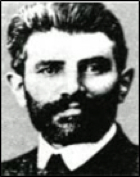 Vekilov Mammadrza Haji Mansur oglu was born om March 8, 1864, in Salahli village of Gazakh district. He was a member of the Parliament of Azerbaijan Democratic Republic, physician, public figure and politician. He graduated from Tbilisi classical school in 1887 and the medical department of Kharkov University in 1893. Vekilov worked as a doctor in Kars city of Turkey. He came to Baku in 1900 and a year later opened the first polyclinic there. In 1900, he was a full member of the Caucasus Emperor Medical Society. On February 10, 1918, he was elected to Transcaucasia Seym. In December, 1918 he was a member of Azerbaijan Parliament and represented “Musavat” faction. He mainly engaged in health and education fields in the parliament. After Soviet Power had been established in Azerbaijan he was arrested two times-in 1920 and 1937 years, but was released because of the lack of evidence. In 1922, Vekilov was engaged in commission on fixing the borders between Azerbaijan and Georgia as he was expert in this field. After his and Mamay bey Shikhlinski’s urgent request, the borders changed and the winter camps in Garayazi and Jeyranchol were kept within the borders of Azerbaijan. Though Vekilov retired on a pension in 1924, he continued his activity as a doctor.
Vekilov Mammadrza Haji Mansur oglu was born om March 8, 1864, in Salahli village of Gazakh district. He was a member of the Parliament of Azerbaijan Democratic Republic, physician, public figure and politician. He graduated from Tbilisi classical school in 1887 and the medical department of Kharkov University in 1893. Vekilov worked as a doctor in Kars city of Turkey. He came to Baku in 1900 and a year later opened the first polyclinic there. In 1900, he was a full member of the Caucasus Emperor Medical Society. On February 10, 1918, he was elected to Transcaucasia Seym. In December, 1918 he was a member of Azerbaijan Parliament and represented “Musavat” faction. He mainly engaged in health and education fields in the parliament. After Soviet Power had been established in Azerbaijan he was arrested two times-in 1920 and 1937 years, but was released because of the lack of evidence. In 1922, Vekilov was engaged in commission on fixing the borders between Azerbaijan and Georgia as he was expert in this field. After his and Mamay bey Shikhlinski’s urgent request, the borders changed and the winter camps in Garayazi and Jeyranchol were kept within the borders of Azerbaijan. Though Vekilov retired on a pension in 1924, he continued his activity as a doctor.
He died in 1944, in Baku.
Vekilov Rehim bey
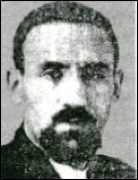 Vekilov Rehim bey Alagha oglu – was a member of the Parliament of the Azerbaijan Democratic Republic, public figure and politician.
Vekilov Rehim bey Alagha oglu – was a member of the Parliament of the Azerbaijan Democratic Republic, public figure and politician.
Rehim bey was born on February 29, 1897 in the village of Gazakh district of Salahli. He graduated from Salahli village school, then Baku school (1916), took active part in the pupils organization, was a member of “All Caucasus Student Organization”. He was a member of the Muslim faction of Transcaucasian Seym and after the dissolution of the Transcaucasian Democratic Federative Republic (May 26, 1918) became a member and secretary of the Azerbaijan National Council (May 27, 1918). On May 28, 1918 the Azerbaijani National Council passed a resolution on foundation of Independent Azerbaijan Democratic Republic in the south-east Caucasus and adopted the Declaration of Independence. Vekilov was one of the co-signers of Declaration of Independence of Azerbaijan Democratic Republic.
Rehim bey Vekilov represented “Musavat” faction in the parliament. The youngest member of the parliament Vekilov was elected the secretary of the parliament of the Azerbaijan Democratic Republic. After the Turkish army came to Azerbaijan he supported the independence of Azerbaijan in the issue of uniting to the Ottoman state. He took part at the Azerbaijan-Armenia conference held in December, 1919.
After the April occupation (1920) he entered to the Baku State University to the faculty of oriental studies. At that time he took an active part in the secret organization “Musavat”. That is why he was under arrest in June and October, 1923 and was sent into exile for 3 years to Yaroslav city of Russia in April, 1924. But after a while he was pardoned and returned to motherland. In 1926 he was again arrested and on February 28, 1927 was sent into exile to the north of the USSR for 8 years. The secret “Musavat” group was established there under his leadership.
Vekilov returned to his motherland in 1934. After a while he went to Tbilisi, took treatments in Borjomi and at the same time worked there for several months. He suffered persecution by the government for a long time and committed suicide in 1934.
Yusifbeyli Nasib bey
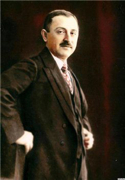 Yusifbeyli (Yusifbeyov, Usubbeyov) Nasib bey Yusif oglu – was an outstanding Azerbaijani statesman and political figure, one of the founders of the Azerbaijan Democratic Republic.
Yusifbeyli (Yusifbeyov, Usubbeyov) Nasib bey Yusif oglu – was an outstanding Azerbaijani statesman and political figure, one of the founders of the Azerbaijan Democratic Republic.
Nasib Yusifbeyli was born in 1881 in Elisavetpol (present-day Ganja, Azerbaijan). After graduating from a gymnasium (secondary school) in Ganja, he enrolled as a student at the Law Faculty of the Novorossiya University (now the Odessa University) in 1902. When the university was temporarily shut down by the Tsarist Russian authorities due to revolutionary student activities, N. Yusifbeyli moved to Bakhchisaray in Crimea, where he started editing "Tercuman" newspaper with the Crimean Turkic intellectual Ismail Gasprinski.
In 1908, Yusifbeyli moved to Istanbul, continuing on his work as a publicist and establishing the Turkic Society. In 1909, he returned to Elisavetpol to work as a city council.
In 1917, Yusifbeyli established the National Party of Turkic Federalists in Ganja, with the main goal of federalism in Russian empire. In July 1917, the party joined the Musavat Muslim Democrat Party of Mammad Emin Rasulzade, and Yusifbeyli became Musavat's regional chair in Ganja.
When the short-lived Transcaucasian Democratic Federative Republic was established on February 10, 1918, N. Yusifbeyli became its Minister of Education.
A historic meeting of the national Council of Azerbaijan chaired by Hassan bay Aghayev was held on May 28, 1918 in Tbilisi. The meeting adopted the Declaration of Independence of Azerbaijan. N. Yusifbeyli was one of the co-signers of Declaration of Independence of Azerbaijan Democratic Republic.
On May 28, 1918, when Azerbaijan Democratic Republic was proclaimed, N. Yusifbeyli again held the post of Minister of Education and finance in the first cabinet headed by Fatali Khan Khoyski. N. Yusifbeyli became Minister of Education and Religious Belief in the second and third cabinets. Among the notable accomplishments of the Ministry of Education was the declaration of Azerbaijani as a state language. In order to implement this decision there was a need to rebuild the education system and train the national specialists. In this connection on August 28, 1918 the government adopted a resolution on nationalization of the Azerbaijan schools. From March 1919 till March 1920, he was the Prime Minister of Azerbaijan, in parallel, also holding the post of the Minister of the Interior from March till December 1919. The most important event during his leadership over the government was de facto recognition of Azerbaijan’s independence by the leading countries of the world. Furthermore, his cabinet managed to achieve a number of measures on national economy and education, such as the foundation of Baku State University, sending of about 100 Azerbaijani students for higher education in various higher schools of Europe, preparation of a bill on land reforms, opening of training courses for combating illiteracy and publication of school textbooks.
The formation of the next cabinet was assigned to Mammad Hasan Hajinski, but he was unable to form it, due to lack of time and also Bolshevik takeover.
After the Bolshevik invasion of Azerbaijan and fall of the Azerbaijan Democratic Republic in April 1920, N. Yusifbeyli left Baku and on May 31, 1920 was assassinated on the way.
Ziyadkhanov Ismayil Khan
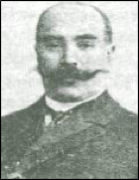 Ziyadkhanov Ismayil Khan Abulfat khan oglu – was public figure and politician of Azerbaijan Democratic Republic, active member of Azerbaijan independence movement. He was a descendant of Gajars dynasty (Iranian royal family of Azerbaijan-Turkic origin, which ruled Iran from 1796 to 1925), Adil khan Ziyadkhanov’s brother.
Ziyadkhanov Ismayil Khan Abulfat khan oglu – was public figure and politician of Azerbaijan Democratic Republic, active member of Azerbaijan independence movement. He was a descendant of Gajars dynasty (Iranian royal family of Azerbaijan-Turkic origin, which ruled Iran from 1796 to 1925), Adil khan Ziyadkhanov’s brother.
Ismayil Khan was born in 1867, Ganja. Ziyadkhanov studied at Ganja gymnasium, graduated from the law faculty of Ganja University and worked as a deputy-prosecutor in Tbilisi district court. The terrible massacres perpetrated by Armenian dashnaks in Baku and many other cities of Azerbaijan in 1905-1906 and in general, the deportation policy and unjust attitude of tsar government to Azerbaijani people made Ismayil khan start his political activity.
Azerbaijani representatives were elected to the special meeting within the Caucasus governor-general in 1906. Ziyadkhanov was elected the deputy of the first State Duma from Yelizavetpol (Ganja) province in 1906. He was a bureau member of Muslim faction of Duma and belonged to People’s Liberation Party. During his activity in State Duma he criticized tsarism’s deportation policy in remote regions and severely protested against the injustice committed not only in the Caucasus, but also in Baltic States.
In 1907, Ziyadkhanov headed the clandestine “Defense” organization which fought against the Russian colonialism. In March of the same year the congress of representatives of the South Caucasus, North Caucasus and Crimea Moslems held in Ganja, resolved to establish all-Muslim Union of Transcaucasia by the leadership of Ismayil Khan Ziyadkhanov. After the February revolution (1917) he was appointed the chief of the city militia by the executive committee of public organizations in Ganja. In the spring of 1918, the armed troops headed by Ziyadkhanov selflessly fought to save the lives of the Muslim population during Shamakhi massacres perpetrated by Armenian-dashnak armed forces. S. Shaumyan considered Ziyadkhanov as the most dangerous person for the Soviet power in Azerbaijan. Ziyadkhanov was a military commissioner in the second cabinet of Azerbaijan Democratic Republic. In the spring of 1919, he headed the extraordinary diplomatic mission of Azerbaijan Democratic Republic sent to Tehran to conduct negotiations with Iranian government. As a result of the mission, the establishment of the permanent diplomatic representation of Azerbaijan Democratic Republic in Tehran and consulates in some parts of Iran was agreed. Also the draft agreements were prepared on post, telegraph, commerce and other fields.
He was assassinated soon after the occupation in April, 1920.
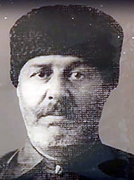
Zizikski Ali bey
Zizikski Ali bey Harun bey oglu was a member of the parliament of the Azerbaijan Democratic Republic and one of the active participants of Azerbaijan national independence movement. After the February revolution captain A. Zizikski was appointed a commissar of Guba district by Special Transcaucasian Committee (Deputy commissar was Mir Jafar Baghirov). He prevented the district to be taken under the control of the Baku Soviet after October revolution in 1917. During the massacre in March, 1918, A. Zizikski together with his groups joined the regiments of Najmaddin Gotsinski who came from Dagestan to give help for Baku.
In April, 1918, the troops of Baku Soviet launched an attack to Guba. In May, 1918, the muslim joint troops headed by Ali bey Zizikski, Hamdulla efendi Efendizade and others liberated Guba city from Baku Soviet armed forces. In late April-early May, according to S. Shaumyan and G. Korganov’s instructions the new dashnak-bolshevik armed forces headed by dashnak Hamazasp were brought into Guba. Zizikski could not put up resistance to outnumbering enemy forces and had to cross over to Dagestan. Hamazasp’s forces perpetrated massacres and vile atrocities in the city and surroundings. Zizikski founded up a new armed group consisting of Caucasus Islam Army and local population of Dagestan, lunched a counteroffensive against dashnak-bolshevik armed forces and liberated Guba.
On September 15, 1918, after liberation of Baku by Caucasus Islam Army consisting of Azerbaijani and Turkish armed forces, Zizikski who was a colonel by that time, was appointed deputy governor-general of the capital, at the same time, was elected a member of the Parliament of Azerbaijan from Guba district. He represented “Ittihad” faction in the parliament. He was elected a member of the Central Committee of “Ittihad” party at the first (April, 1919) and the second (January, 1920) congresses of the party.
For some time Zizikski participated in resistance movement against the soviet authority after the April occupation. Until 1928, he lived in Baku, but that time he suffered Bolshevik persecution. He was accused of “perpetration of Armenian massacre”, was arrested and put to death.
